DRIVING AUSTRALIA’S TRANSPORT SECTOR WITH ITS
PEEK INSIDE THE METRO TUNNEL
THE OUTBACK WAY:
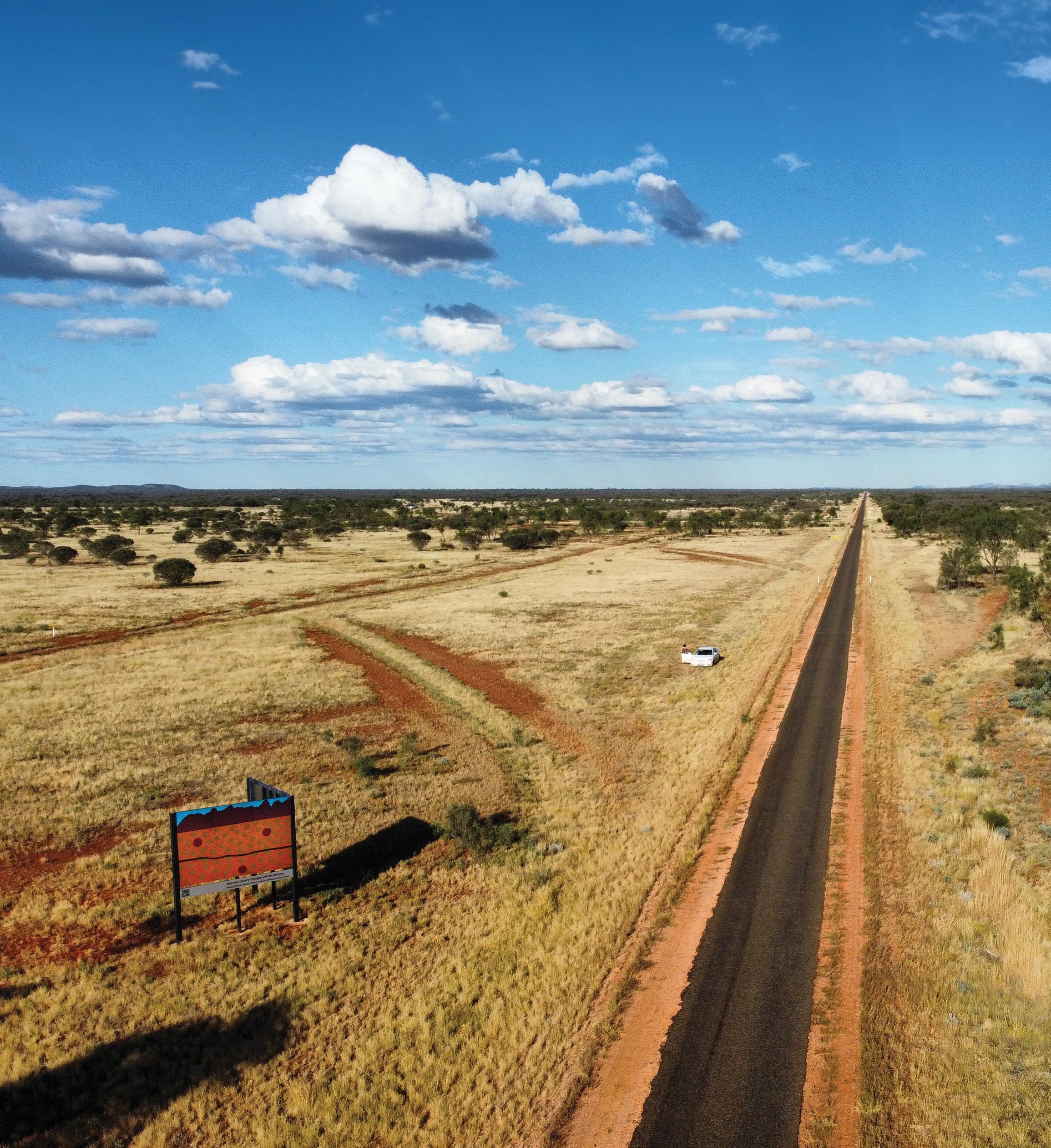
CONNECTING CENTRAL AUSTRALIA
Issue 28 September 2023 ROAD - RAIL - AIRPORT - PORT - URBAN - UTILITY
Polymaster’s unique Enclosed IBC Bund solves many of the problems associated with IBC storage and chemical/fluid decanting in a weather resistant, purpose-built enclosure.
Æ Full weather protection – stops rain entering the enclosure
Æ Easy forklift loading with wide forklift access from both side and back Æ 250ltr day tank
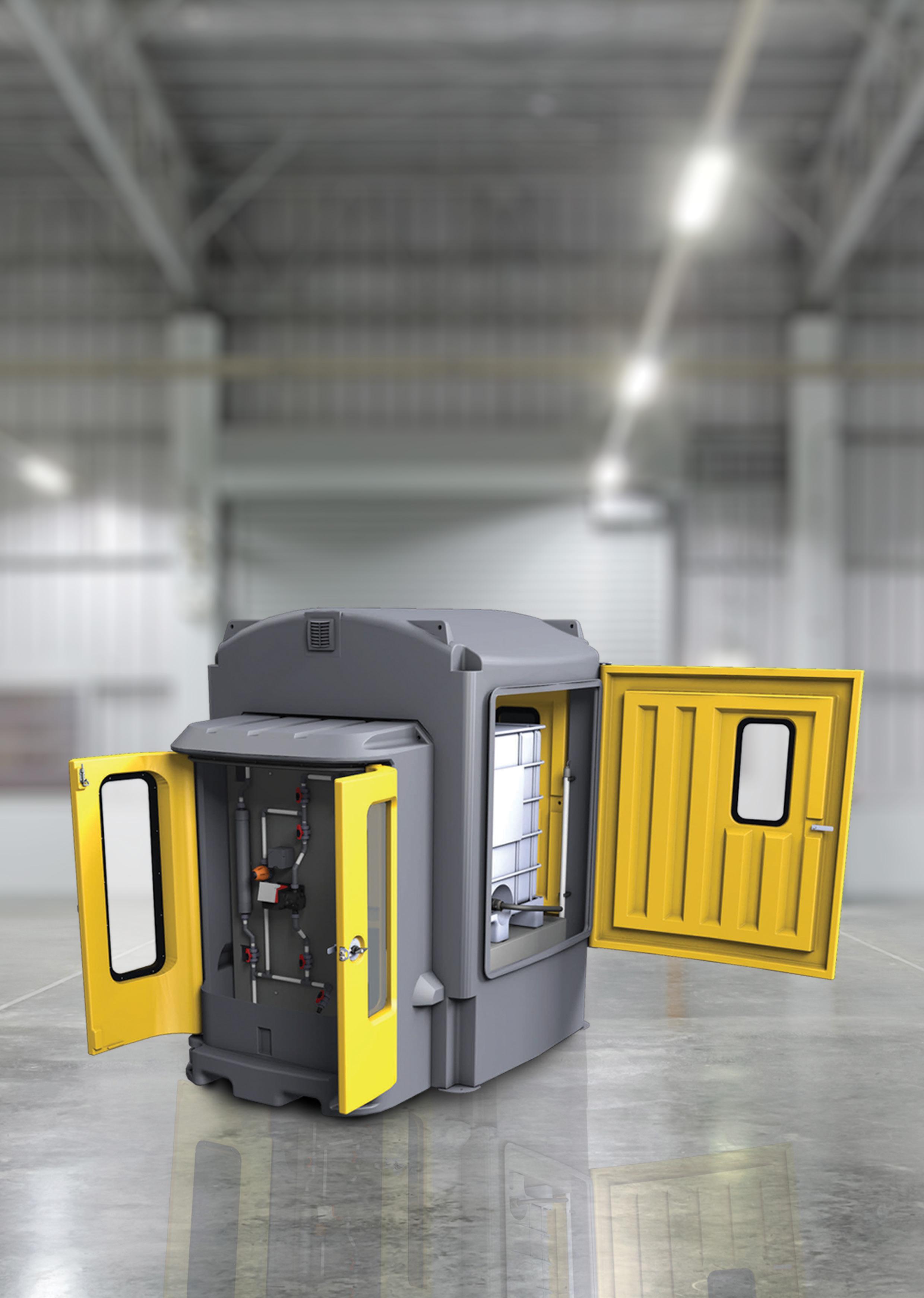
Æ Lockable cabinet to keep system secure Æ Venting by two sides
Æ Viewing windows incorporated into the doors
Æ 110% bund capacity complies with AS3780
Æ Sight tube and low-level alarm available
Æ Chemical resistant – high grade polyethylene construction
1800 062 064 | polymaster.com.au Secure IBC storage & decanting solutions
View Video
Tess Macallan, Kody Cook, Steph Barker, Yasmin Isaacs
National Media Executives
Rima Munafo, Brett Thompson, Ryan Sheehan
Design Manager

Alejandro Molano
Senior Designer Luke Martin
Designers
Ozlem Munur, Danielle Harris, Jacqueline Buckmaster
Marketing Manager
Radhika Sud
Marketing Associates
James Holgate, Natalie Ta, Rhys Dawes
Digital Marketing Assistants
Isabella Predika, Emily Gray
Publisher Chris Bland
Managing Editor Laura Harvey

ISSN: 2206-7906
EDITOR’S WELCOME
By the time this issue hits shelves, winter will hopefully have left us, and perhaps (although not so likely) the sector can catch its breath after a particularly fast-paced few months of news and upheaval. That’s why this issue, we’re bringing out the big guns – serving up diverse opinions on the biggest questions and projects in the sector right now.
One of these is the rise of AI and how this will continue to change the sector as we know it, with our feature AI and Machine Learning offering readers a deep dive and answer to the query on everybody’s lips – what does the future hold for the sector?
This issue also features discussion from Dr Ehsan Noroozinejad, a Senior Research Fellow at Western Sydney University and a pioneering authority in smart construction, covering not-sofuturistic autonomous, and AI-powered, inspection and monitoring.
Our September edition is focused not only on AI, but Intelligent Transport Systems (ITS) as well, showcasing multiple projects made easier, and more beneficial to the public, by using smart, digital solutions.
One of the more infamous of these is the Metro Tunnel in Melbourne – a complete ‘revamp’ of the city’s train system – which has just passed a major milestone using its High Capacity Signalling system – promising to service the city into the future and beyond.
Another mega-infrastructure project featured is the Western Sydney International Airport, with a special report in our Sustainability feature highlighting the project’s green initiatives and progress so far.
Finally, I can’t forget our cover story – hailed as ‘Australia’s Route 66’ the Outback Way is an eye-opening piece of infrastructure that is cutting through the desert and opening up Central Australia to the nation.
As always, I look forward to delivering the latest news and content from the sector, and if you have a story idea or a tip, reach out – my digital door is always open.
April Shepherd Editor
1 www.infrastructuremagazine.com.au September 2023 // Issue 28 EDITOR’S WELCOME
Get in touch at info@infrastructuremagazine.com.au or feel free to give us a call on 03 9988 4950. Don’t forget to follow Infrastructure Magazine on social media – find us on LinkedIn, Twitter and YouTube.
Scan to subscribe to Infrastructure Magazine’s weekly newsletter – delivered to your inbox every Wednesday morning. This document has been produced to international environmental management standard ISO14001 by a certified green printing company. Infrastructure Magazine
Published by Monkey Media Enterprises ABN: 36 426 734 954 C/- The Commons, 36–38 Gipps St,
P: (03) 9988
monkeymedia.com.au info@monkeymedia.com.au infrastructuremagazine.com.au news@infrastructuremagazine.com.au
April
Assistant
Stephanie
acknowledges
Aboriginal
Traditional Owners of Country throughout Australia and pays respect to their cultures and Elders past, present and emerging.
Collingwood VIC 3066
4950
Editor
Shepherd
Editor
Nestor Journalists
A WORD FROM INFRASTRUCTURE AUSTRALIA
HOW THE INDUSTRY IS WORKING WITH FIRST NATIONS COMMUNITIES
The infrastructure industry is increasingly playing a significant role in delivering meaningful outcomes for First Nations communities, thanks to methodical and thought-out engagement frameworks.
INDUSTRY INSIGHT
IS THERE A WAY OUT? CONSTRUCTION INSOLVENCIES MUST STOP
In March of this year, Canberra-based PBS Building joined a growing number of major Australian construction companies that have collapsed – yet another sign that the industry needs to reform.

26 THE THREE LINES OF DEFENCE: DIGITAL SECURITY IN AN INTERCONNECTED WORLD
Q&A: NEW GIIA CEO DISCUSSES SECTOR'S BIGGEST CHALLENGES, ECONOMIC OPPORTUNITIES
The Global Infrastructure Investor Association (GIIA), which represents many of the world’s leading institutional investors in infrastructure, announced in early June the appointment of Jon Phillips as Chief Executive Officer (CEO). Infrastructure Magazine sat down with the new CEO to discuss GIIA’s role in the sector, the upcoming challenges and how it is imperative that the industry reduces its emissions globally.
THERE’S
A SOLUTION TO AUSTRALIA’S PRODUCTIVITY PROBLEM: DIGITAL BY DEFAULT
In June, after Australia posted its largest fall in national productivity on record, federal Treasurer Dr Jim Chalmers noted that the solution was not “trying to make people work longer for less” but about “investing in their skills and their capacity to adopt and adapt technology”. This statement must come as a relief for the two thirds of people in the construction industry who reportedly already work more than 50 hours a week, and symbolises the need for change.
OPINION:
BUILDING FOR A BETTER AUSTRALIA
DIVERSITY IN THE SECTOR
IN FOCUS:
NAIF’S NEW BOARD MEMBER TALKS HISTORY, IDENTITY AND GROWTH
SIX STEPS TO CHOOSING THE RIGHT CONSTRUCTION SITE SURVEILLANCE
ENHANCING INFRASTRUCTURE MONITORING IN AUSTRALIA: EXPLORING DRONE-BASED AUTONOMOUS INSPECTION USING AI

Infrastructure monitoring is crucial in ensuring critical structures' safety and efficient functioning. This is especially true in Australia, a country known for its diverse and challenging environment, which requires robust monitoring systems to address the unique infrastructure needs of the country.
MAKING THE SWITCH TO CLOUD-BASED GEOTECHNICAL INFORMATION MANAGEMENT

AI IN THE INFRASTRUCTURE SECTOR: WHAT DOES THE FUTURE HOLD?
Around the globe many industries are already making use of artificial intelligence (AI) systems to automate operations. As this technology develops, there are plenty of opportunities for the construction, utility and transport sectors to save time, money and manpower. So what can AI offer the infrastructure sector?
LOOKING DEEPER: SOLVING THE PROBLEM OF UNDERGROUND UTILITY RISK
2 September 2023 // Issue 28 www.infrastructuremagazine.com.au CONTENTS
32 34 38 40 44
AI AND MACHINE LEARNING
16 18 20 14
22
AN EASY GUIDE: ACHIEVING ‘HAZARD FREE’ LEVELS OF RESPIRABLE CRYSTALLINE SILICA 30 28 ASSET MANAGEMENT
INTELLIGENT TRANSPORT SYSTEMS (ITS)
DRIVING AUSTRALIA’S TRANSPORT SECTOR WITH ITS
Digital innovations in transport and freight can increase efficiency, reduce costs and create new job opportunities. In Australia, however, the transport sector is lagging behind other OECD countries when it comes to digitalisation and automation trends. A recent report by Swinburne University of Technology, funded by the iMOVE Cooperative Research Centre and the Department of Infrastructure, Transport, Regional Development, Communications and the Arts, sheds light on the challenges and opportunities that lay ahead in adapting to this ever-evolving landscape.
THE POWER OF EDGE COMPUTING IN INDUSTRIAL ENVIRONMENTS
METRO TUNNEL’S SMART FEATURES PUT TO THE TEST
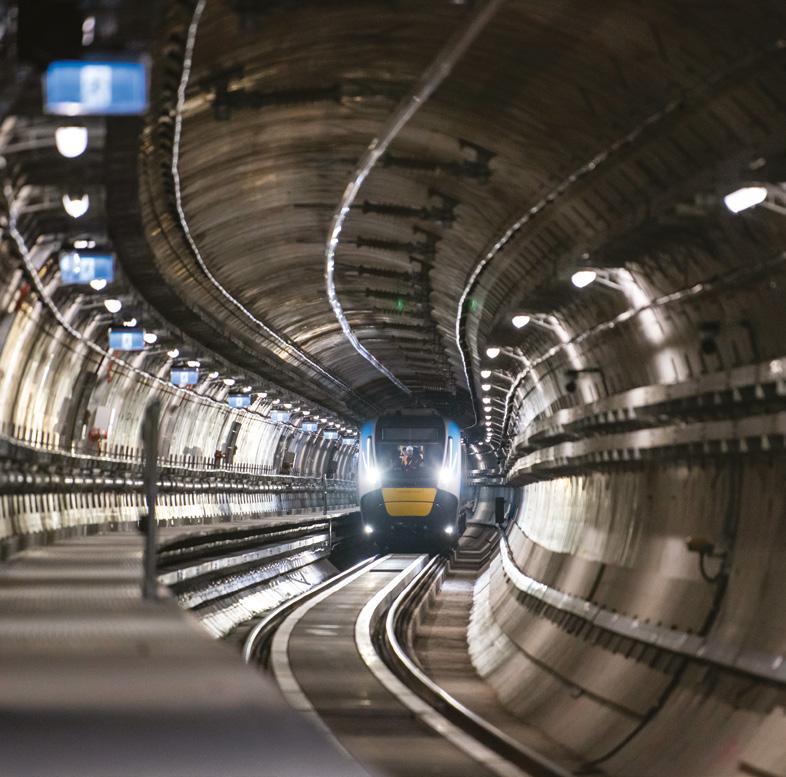
The Metro Tunnel – Victoria’s biggest transport infrastructure project in more than 40 years – has reached an historic milestone, with two test trains entering the twin 9km tunnels deep beneath Melbourne in the early hours of 25 July 2023, putting the new infrastructure, and its smart signalling system, to the test.
WESTERN SYDNEY INTERNATIONAL AIRPORT PROGRESS: AN AIRPORT FOR THE FUTURE

LET’S TALK WASTE: HOW THE SECTOR CAN BECOME A SUSTAINABLE FUTURE CORNERSTONE
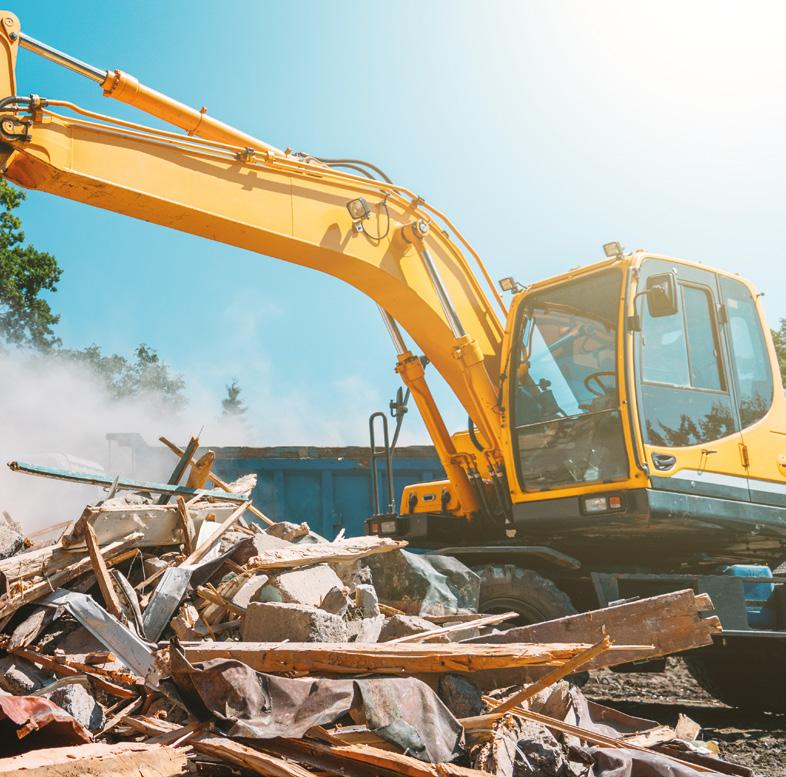
GOING CIRCULAR: WHAT INFRASTRUCTURE STANDS TO GAIN
ROADS AND TRAFFIC OPENING UP CENTRAL AUSTRALIA WITH THE OUTBACK WAY
ON THE ROAD AGAIN: EFFECTIVE SOLUTIONS FOR ASSET MANAGEMENT
WHY QUALITY, TESTED PRODUCTS ARE CRITICAL FOR INFRASTRUCTURE LONGEVITY
As road and infrastructure projects multiply across the nation, there’s a high demand for products with higher-than-usual lead times for precast concrete pipes and other stormwater products. But when inferior, untested products are unknowingly used, there can be a drastic negative impact on the lifespan and structural integrity of the project.
6 REGIONAL VIC PACKAGE ANNOUNCED FOLLOWING COMMONWEALTH GAMES CANCELLATION
8 NSW BYPASS CONSTRUCTION PROGRESSES
9 SEQ DRAFT PLAN PROPOSES 900,000 NEW HOMES
10 CONTRACTOR SHORTLIST RELEASED FOR FINAL VIC INLAND RAIL PROJECTS
12 MAJORS ROAD INTERCHANGE CONTRACT AWARDED
3 www.infrastructuremagazine.com.au September 2023 // Issue 28 CONTENTS
46 66 70 52 50 74
SUSTAINABILITY REGULARS
CONTRIBUTORS
ADVERTISERS’ INDEX
FEATURES SCHEDULE NEWS
1 EDITOR’S WELCOME 4
76
76
CLIMATE CONSCIOUS ENGINEERING AT CSE23 56 60 62 64
Contributors
Vanessa Elliott
Board member of Northern Australia Infrastructure Facility (NAIF)
Vanessa Elliott is a Jaru woman from the Kimberley and Desert region of Northern Australia. She is a sustainability expert with 30 years of land use and social impact planning experience, specialising in regional development, primary industries and the resources sector. Ms Elliott is also a board member of Northern Australia Infrastructure Facility (NAIF), Indigenous Business Australia (IBA), Desert Knowledge Australia (DKA), the Centre for Co-operative Research in Transformation in Mining Economies (CRC TiME), and the WA East Metropolitan Health Service (EMHS).
Ms Elliott is also a former Telstra Young Business Woman of Australia, National NAIDOC Young Person of the Year, with a Centenary Medal for Business, Curtin University’s John Curtin Medal for leadership, and inaugural member of the WA Women’s Hall of Fame.

Dr Ehsan Noroozinejad

Senior Research Fellow at UTRC, Western Sydney University
AEC Consultant on Digitalization
Dr Noroozinejad, a Senior Research Fellow at Western Sydney University's Urban Transformations Research Centre, is a pioneering authority in smart and resilient construction. His extensive background includes a prestigious role at UBC Smart Structures in Canada and founding the International Journal of Earthquake and Impact Engineering. Notably, he serves as an Associate Editor for distinguished journals and is the Engineering Editor for ASCE Natural Hazards Review.
Since 2018, he has founded and directed the Resilient Structures Research Group, collaborating with a renowned team of global researchers. Additionally, his consultancy work in digitalization for the construction industry further amplifies his influential contributions.
Shivendra Kumar
Principal Consultant, Shivendra & Co
Dr Kumar is the founder of Shivendra & Co, a business consultancy firm that works with small to medium-sized engineering and construction companies to improve performance and maximise growth potential. Shivendra & Co. assists clients on strategy execution, process improvement and digital transformation.
Dr Kumar's mission is to help build thriving businesses that will lead the transformation of the construction industry while concurrently helping develop a future-ready infrastructure delivery ecosystem.

He is also the host of The Competitive Contractor podcast, where he invites infrastructure’s key players to share insights and advice for business success.
Senator the Hon Bridget McKenzie
Shadow Minister for Infrastructure, Transport and Regional Development and the Nationals Leader in the Senate
Bridget McKenzie is the Shadow Minister for Infrastructure, Transport and Regional Development, a former Cabinet Minister and was Australia’s first female federal Agriculture Minister.
Ms McKenzie was elected Senator for Victoria in 2010 and has been the Leader of the Nationals in the Senate since 2019. She was the party’s Deputy Leader from 2017 to 2020. Ms McKenzie said she believes that strategic infrastructure investment and planning are the keys to a more prosperous, safer and stronger Australia.

4 SECTION
Contributors
Dr Olabode Ogunmakinde is an academic at the Department of Construction Management and Quantity Surveying, Faculty of Society and Design, Bond University. He holds a Ph.D. in Building from the University of Newcastle, Australia.

Dr Ogunmakinde’s research interests are diverse and reflect his commitment to addressing the pressing issues confronting the construction industry today. His research focuses on sustainable construction, circular economy, construction waste management, sustainable development goals, building information modelling, and disaster management. He has published several peer-reviewed articles in high-impact journals, presented his research at international conferences, and received several research awards.
Jon Phillips was appointed CEO in June 2023 having joined GIIA in 2016 to lead on communications strategy, public affairs and membership growth as Corporate Affairs Director and Deputy CEO.

Between 2005 and 2016 he was Communications Director for the Nuclear Decommissioning Authority, a UK government agency established to run the £3bn a year nuclear clean-up programme. Prior to that, Mr Phillips spent 12 years at airport operator BAA Heathrow, where he led the communications campaign for the £4.2bn T5 project.
Mr Copp was appointed Acting CEO of Infrastructure Australia in August 2022. An accomplished and transformational public sector leader, he has over 15 years’ experience in the Federal Government holding a range of policy, strategy and public affairs roles across infrastructure, workplace relations and the Council of Australian Governments. Prior to his appointment, Mr Copp was Infrastructure Australia’s Chief Operating Officer.
As Chief Operating Officer, Mr Copp was responsible for leading Infrastructure Australia’s Strategy, Finance, People & Culture and Digital Technology functions. He joined Infrastructure Australia in 2014 and set up the public affairs and stakeholder engagement function, before expanding his role across the other operational functions of the business. He is a passionate advocate for Reconciliation and First Nations engagement.

Hussein Dia Professor of Future Urban Mobility at Swinburne University of Technology
Hussein Dia is professor of Civil Engineering specialising in future urban mobility research. His interests are in the convergence of technology, infrastructure and human elements in urban environments.
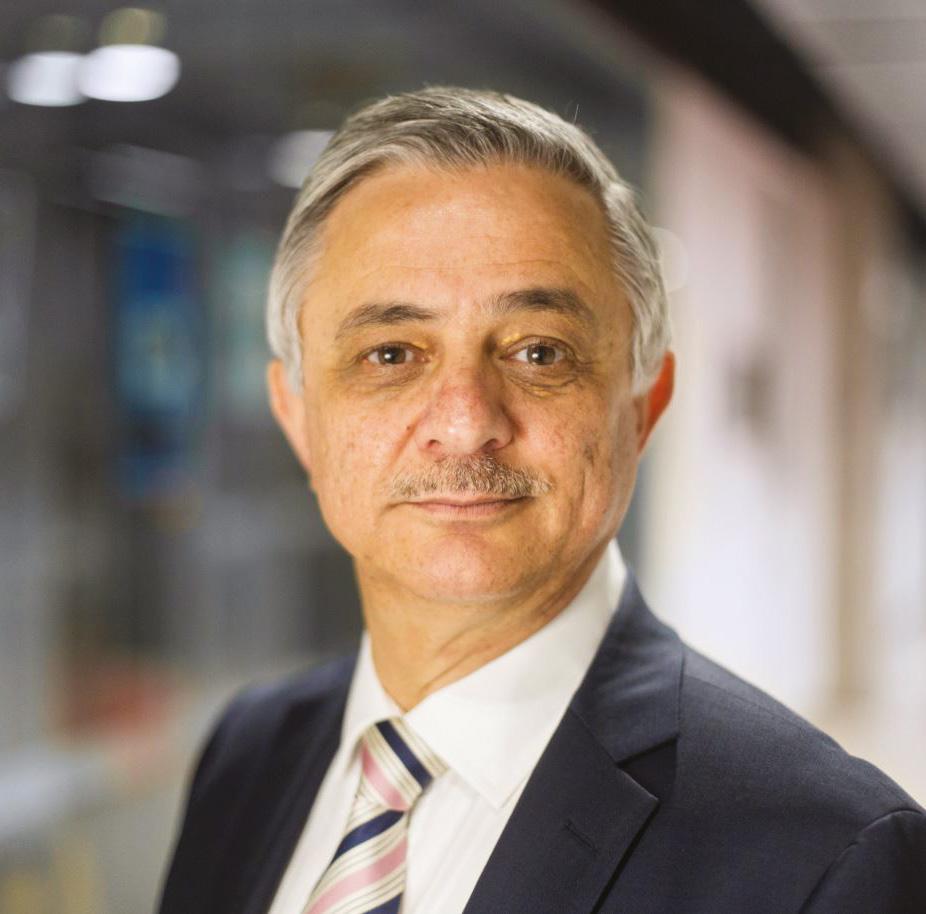
Mr Dia’s current work is focused on decarbonisation of urban transport and harnessing digital innovations to unlock opportunities for smart and sustainable mobility futures.
He is ranked in the Stanford University Global Scientist Citation Rankings in the top 2 per cent most cited scientists in the field of Logistics and Transportation. He is Fellow of Engineers Australia, Fellow of the American Society of Civil Engineers, and Fellow of the Institute of Transportation Engineers. He currently serves as Senior Editor for the international journal IEEE Transactions on ITS.
5 SECTION
Jon Phillips
Chief Executive Officer, GIIA
Dr Olabode Ogunmakinde
Senior Teaching Fellow in Bond’s Comparative Construction Research Centre
Adam Copp
Chief Executive Officer, Infrastructure Australia
REGIONAL VIC PACKAGE ANNOUNCED FOLLOWING COMMONWEALTH GAMES CANCELLATION
Commonwealth Games it was happy to help out, provided that the event delivered lasting benefits to the state.
“What’s become clear is that the cost of hosting these Games in 2026 is not the $2.6 billion which was budgeted and allocated,” Mr Andrews said.
After cancelling plans to host the 2026 Commonwealth Games in the face of skyrocketing costs, the Victorian Government has announced that the approximately $2 billion allocated to the Games will instead be used to deliver an improvements package across regional Victoria.
The event – which was to be held in three years’ time throughout regional Victoria – was set to not only provide a huge economic boost for the area’s regional communities, but be the catalyst for much-needed infrastructure construction for these communities.
In a press conference held on 18 July, Victorian Premier Daniel Andrews said that when the Victorian Government was approached in 2022 to host the
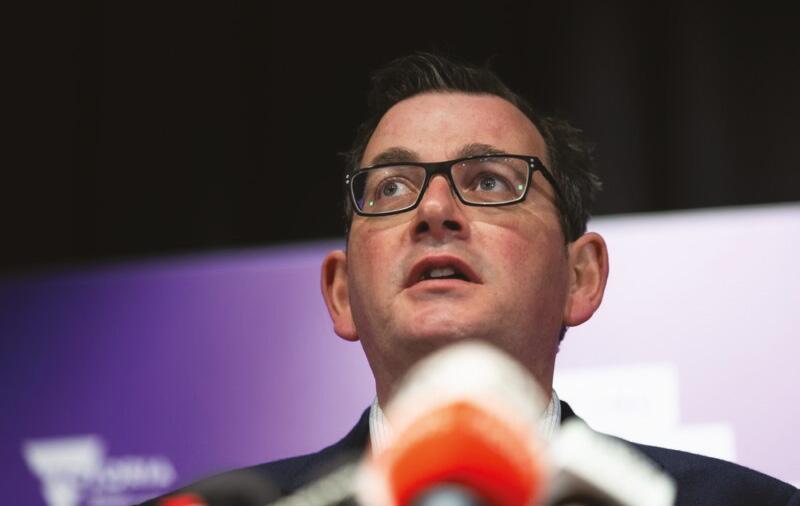
Mr Andrews said the true cost was likely to be closer to $6 or $7 billion and the state simply could not afford it.
“I will not take money out of hospitals and schools to host an event that is three times the cost estimated and budgeted for last year.
“I’ve made a lot of difficult calls, a lot of very difficult decisions in this job. This is not one of them. Frankly, $7 billion for a sporting event, we are not doing that.”
Mr Andrews said that while the Games would not go ahead, the over $2 million already allocated to the event will instead go toward a regional package that includes lasting infrastructure that the Games were set to provide.
“We will instead deliver all and more of the legacy benefits in housing, sporting infrastructure, tourism,” Mr Andrews said.
Mr Andrews said the details of these legacy benefits would be unpacked and released from 19 July onward.
“Each and everyone of the sporting facilities that were to be legacy benefits from the games will be built,” Mr Andrews said.
“There is a very substantial regional tourism fund, there will be a substantial package of support for community based sport, and perhaps most importantly there will be a $1 billion dollar boost for social and affordable housing right across regional Victoria, not just in those hub cities, but there will be at least 1,300 new homes constructed across regional Victoria.”
When a journalist asked Mr Andrews why the Games couldn’t have been held in Melbourne, rather than cancelled altogether he responded, “We have looked at every conceivable option”.
“All of them are far in excess of the $2.6 billion that’s been budgeted, so all of them represent more cost than there is benefit, and on that basis none of those options stack up and we’re not going to be hosting the Games in 2026.”
September 2023 // Issue 28 www.infrastructuremagazine.com.au 6 NEWS
New STRAILastic_mSW 730
mini soundprotection wall with high absorbing surface
The new version of the STRAILastic_mSW adds a higher wall to the product range. This version is used for train speeds of up to 120 km/h.
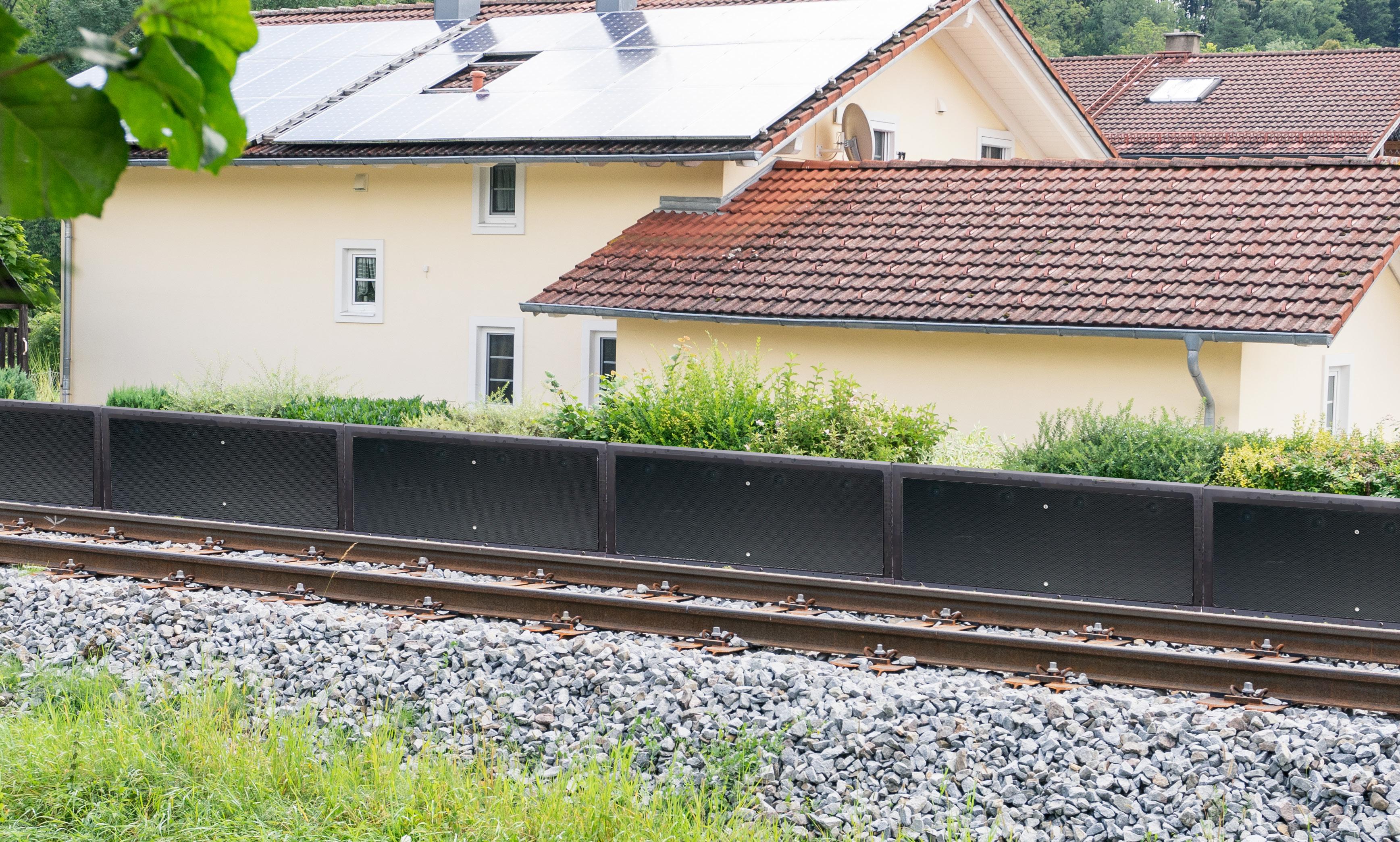

Benefits at a glance
¬ No foundation required for installation
¬ easy and quick installation
¬ Short delivery times > noise hot spots can be supplied with products quickly
¬ Closer to the noise source than any other sound protection
¬ Break-proof due to fibre-reinforced rubber compound with a cover layer of virgin rubber > UV and ozone resistant
¬ No material fatigue caused by vibrations or pressure and suction forces
¬ No problems with oversized loads
STRAILastic -
sound
protection
4 products - 1 result - silence
Due to the higher design, it gains even more effect in the area of the wheel.
STRAILastic_mSW 730 is fastened to both rails with an insulated, decoupled substructure or directly in the subsoil using ground screws.
STRAILastic_mSW 730 > mini goes maxi.
1. STRAILastic_mSW 730 new version of the mini sound protection wall
2. STRAILastic_IP the infill panel
3. STRAILastic_mSW the established mini sound protection wall
4. STRAILastic_A inox 2.0 rail dampers
STRAILastic Australia Pty Ltd // STRAILastic track damping systems 350 Botany Road | Beaconsfield NSW 2015 Sydney | www.strail.de/en/
More information can be found at www.strail.de/en/
1.
2.
3.
4.
New South Wales motorists have started to see progression on the Rankin Park to Jesmond section of the Newcastle Inner City Bypass, with construction already underway thanks to significant funding from the State and Federal Government.
NSW BYPASS CONSTRUCTION PROGRESSES

The Federal and New South Wales Governments are funding the $450 million Rankin Park to Jesmond section of the Newcastle Inner City Bypass.
Transport for NSW Region North Director, Anna Zycki, said, “This project will provide traffic relief to the surrounding road network, in particular the existing route of Lookout Road, Croudace Street and Newcastle Road, which is used by about 40,000 to 60,000 vehicles each day.
“The new bypass will remove up to 30,000 vehicles each day from the existing route which is a huge win for the community and freight operators.
Quest is 25!

This year marks the 25th year of operations for Quest in NZ. We would like to take this opportunity to congratulate Stephen Mansfield, the founder of Quest here in New Zealand for his vision and foresight in creating what has become the largest and fastest growing accommodation provider in New Zealand. Brand new properties Quest Mt Maunganui and Quest Hastings are now open! Book now via the Quest App. Also earn Air New Zealand Airpoints. Find out more at: questapartments.co.nz/about-quest/quest-app
“Once completed, motorists travelling on the new section of bypass will avoid up to eleven sets of traffic lights along the existing route.
“Road users will start to see work ramping up with the installation of safety barriers, line marking, and traffic signage will continue to support road realigning and adjustments.”

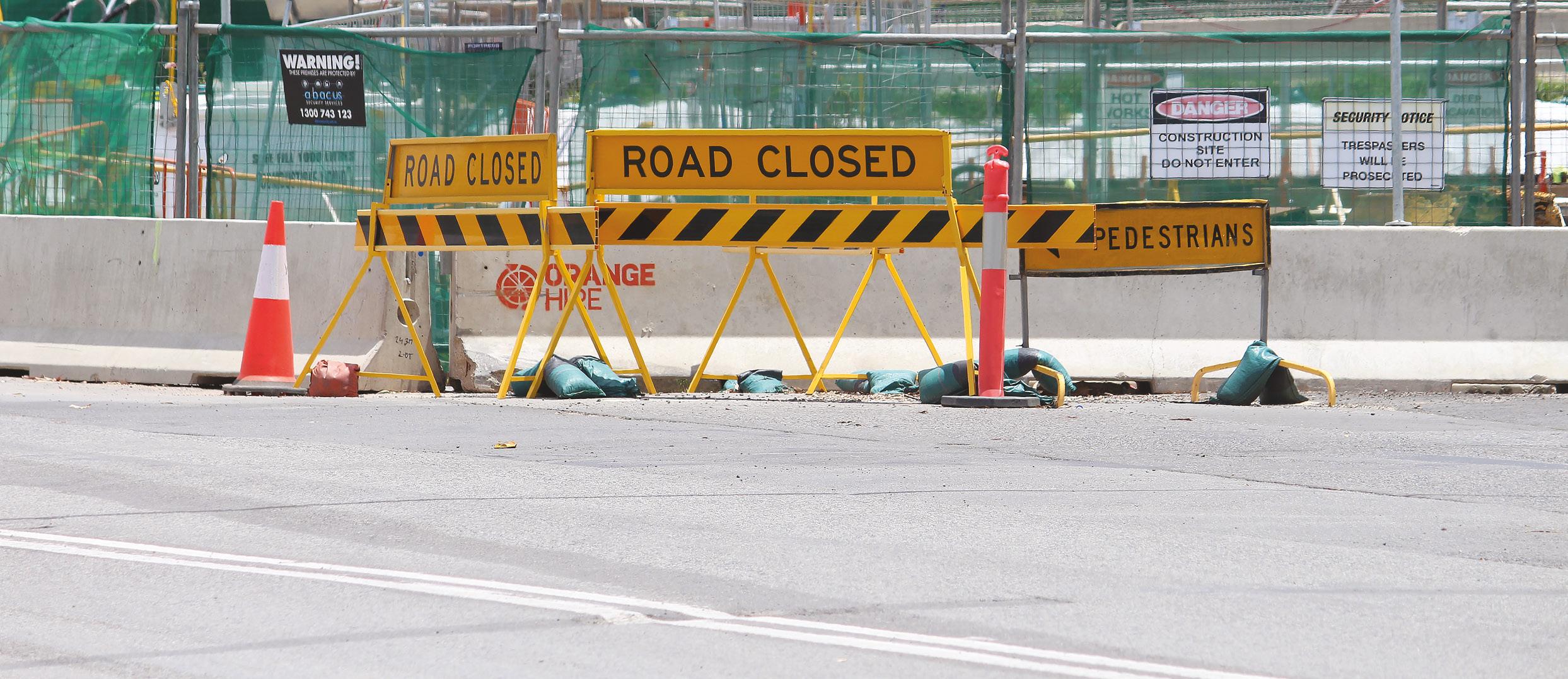
Ms Zycki said preparation is also underway for upcoming bridgework at the northern interchange.
“Piling rigs arrived on site in mid-June and bridge piling work has started,” Ms Zycki said.
“There are six bridges being built as part of the bypass and more than 60 piles will be installed for these bridges. Cumulatively, drill holes for the piles will be more than 1.2 kilometres deep, which is more than the Eiffel Tower stacked end to end four times.
“There’ll also be 190 tonnes of reinforcement used in the piles, equating to the weight of more than 32 elephants.”
The project is expected to be completed by the end of 2025.
ENTHOTEL S
September 2023 // Issue 28 www.infrastructuremagazine.com.au 8 NEWS
Q UESTAPAR T
CELEBRATI
M
N G 25 YEARS
The newly released South East Queensland Regional Plan draft outlines almost 900,000 new homes by 2040, to meet an expected 2.2 million new residents.

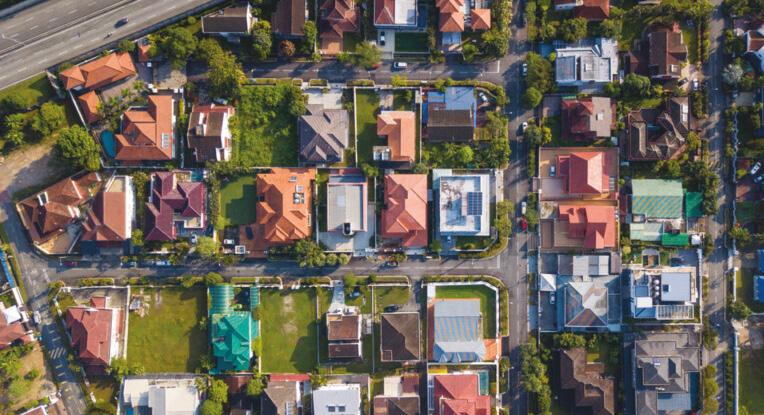
The plan will work with Queensland councils, allowing residents with more options as to where and how they want to live. For the first time, councils in the region’s 12 local government areas will be required to adjust their planning schemes to help deliver a mix of homes to offer more choice to the communities.
Well-located homes is a central focus of the plan, with thought and planning for an extra 100,000 properties close to transport and across well-serviced areas.

The plan also focuses on housing affordability, recognising the need for more social and affordable housing to be provided in the future.
Queensland Deputy Premier, Steven Miles, said “South East Queensland is booming, with almost six million people expected to call this region home by 2046.


“More housing is needed more than ever before, and we need a plan that ensures homes are delivered when and where they need to be whilst also protecting Queensland’s great lifestyle.
“We are committed to reviewing our plan for South East Queensland as a key outcome from the Housing Summit, and we are delivering on that promise.
“A lot has changed since the last plan was released, including record interstate migration. Our population isn’t just getting bigger; it’s changing, with household sizes, demographics and lifestyle trends shifting.
“Our $89 billion Big Build over the next four years will deliver the infrastructure needed to support our growing state with greater connectivity and better services.”
To manage the growth, the plan includes the SEQ Infrastructure Supplement which aims to ensure homes are well-served by transport and key infrastructure such as schools, hospitals and university precincts.
State Minister for Housing, Meaghan Scanlon, said that the SEQ plan and investment is the largest in the state’s history.

“With these new targets and requirements for social and affordable housing, government and industry will be clear on what is needed to help deliver for our future population,” Ms Scanlon said.
“It complements our $5 billion for social and affordable housing – the largest investment in Queensland’s history.
“Importantly, this plan isn’t just about housing affordability, it’s about affordable living. Making sure the right housing is available, at the right location, to maximise access to local services, transport and jobs is critical.
“People are flocking to the south-east region because it is one of the best places in the world to live, work, learn, and raise a family.
“We know that residents in Queensland, like elsewhere in the nation, are facing increased housing pressures that are impacting on affordability. But we can’t do this alone – it requires all levels of government, including councils, industry and our communities, to make this a reality.”
www.infrastructuremagazine.com.au September 2023 // Issue 28 9 NEWS Visit us online for more info toolkwippumps.com.au P: +61 3 8805 0500 E: sales@toolkwippumps.com Available in: NSW • VIC • QLD • SA • TAS ECO FRIENDLY PUMPING Pumping Solutions for the Utility Sector DEWATERING • SEWER BYPASS • BULK WATER SUPPLY S RANGE FEATURES + Auto-prime to 8.8m + Vortex impeller for superior solids handling + Run dry + Eco-friendly HYDRAULIC SUBMERSIBLE PUMPS HOSES & ACCESSORIES SEQ DRAFT PLAN PROPOSES 900,000 NEW HOMES
CONTRACTOR SHORTLIST RELEASED FOR FINAL VIC INLAND RAIL PROJECTS
Inland Rail has announced the contractor shortlist for its final eight Victorian projects, revealing the three contractors who will be competing for the major construction initiatives.
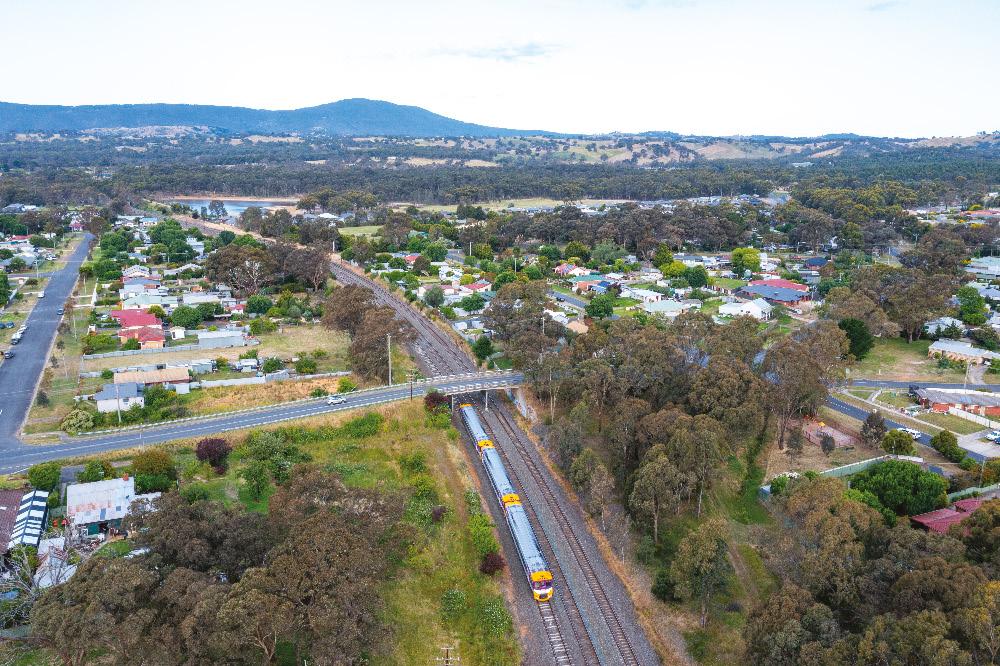
The three contractors – CPB Contractors, John Holland and McConnell Dowell – will now develop their final design and construct tender submissions for the Inland Rail Beveridge to Albury section for Tranche 2 works at Benalla, Euroa, Broadford, Wandong, Seymour, and Tallarook.
Inland Rail said that the Request for Tender shortlisting followed a rigorous expression of interest process, which drew a high standard of responses from local and interstate construction firms to deliver the Inland Rail.
In Victoria, work will be undertaken at 12 sites to enable double-stacked freight trains to pass safely and ensure everyday products can be delivered faster and more reliably around Australia.
McConnell Dowell is currently delivering four Beveridge to Albury Tranche 1 sites at Glenrowan, Barnawartha North, Wangaratta, and Seymour.
ARTC Victoria and South Australia Projects General Manager, Ed Walker, said that the remaining eight Victorian Inland Rail sites will be awarded to the very best available team and ARTC is now entering a formal Request for Tender phase to determine who will be chosen.
“The successful contractor for this portion of the work will be required to deliver initiatives and meet targets related

to industry participation, sustainability, employment, and workforce development, with the Inland Rail team working closely with them to achieve these targets,” Mr Walker said.
“The first four Tranche 1 sites are moving quickly, and it will be great to get the shovels in the ground for the remaining eight Tranche 2 sites.”
The preferred contractor will be announced in mid-2024, with Tranche 2 construction starting from 2025.
September 2023 // Issue 28 www.infrastructuremagazine.com.au 10 NEWS
Short St Bridge, Broadford, one of eight Inland Rail project sites in the Request for Tender. Image credit: Inland Rail.
The missing link in your B2B Marketing Strategy
While traditional trade publications have quality audiences and high levels of trust, they can lack the full range of services to guarantee a return on your investment. And while traditional marketing agencies offer the latest marketing techniques, they don’t have the audience or the industry understanding the B2B sector needs.
Monkey Media is the missing link that brings together a trusted brand and powerful audience, with a complete agency offering.

TO FIND OUT MORE SCAN THE QR CODE NOW
MAJORS ROAD INTERCHANGE CONTRACT AWARDED
The contract to design and construct the Majors Road Interchange Project – jointly funded with $120 million from the Federal and South Australian Governments – has been awarded.
Acciona Construction Australia has been awarded the contract, with the project involving the construction of new on/off-ramps for the Southern Expressway at Majors Road, with both governments committing $60 million each.
The project is expected to support approximately 245 full-timeequivalent jobs per year over the construction period.
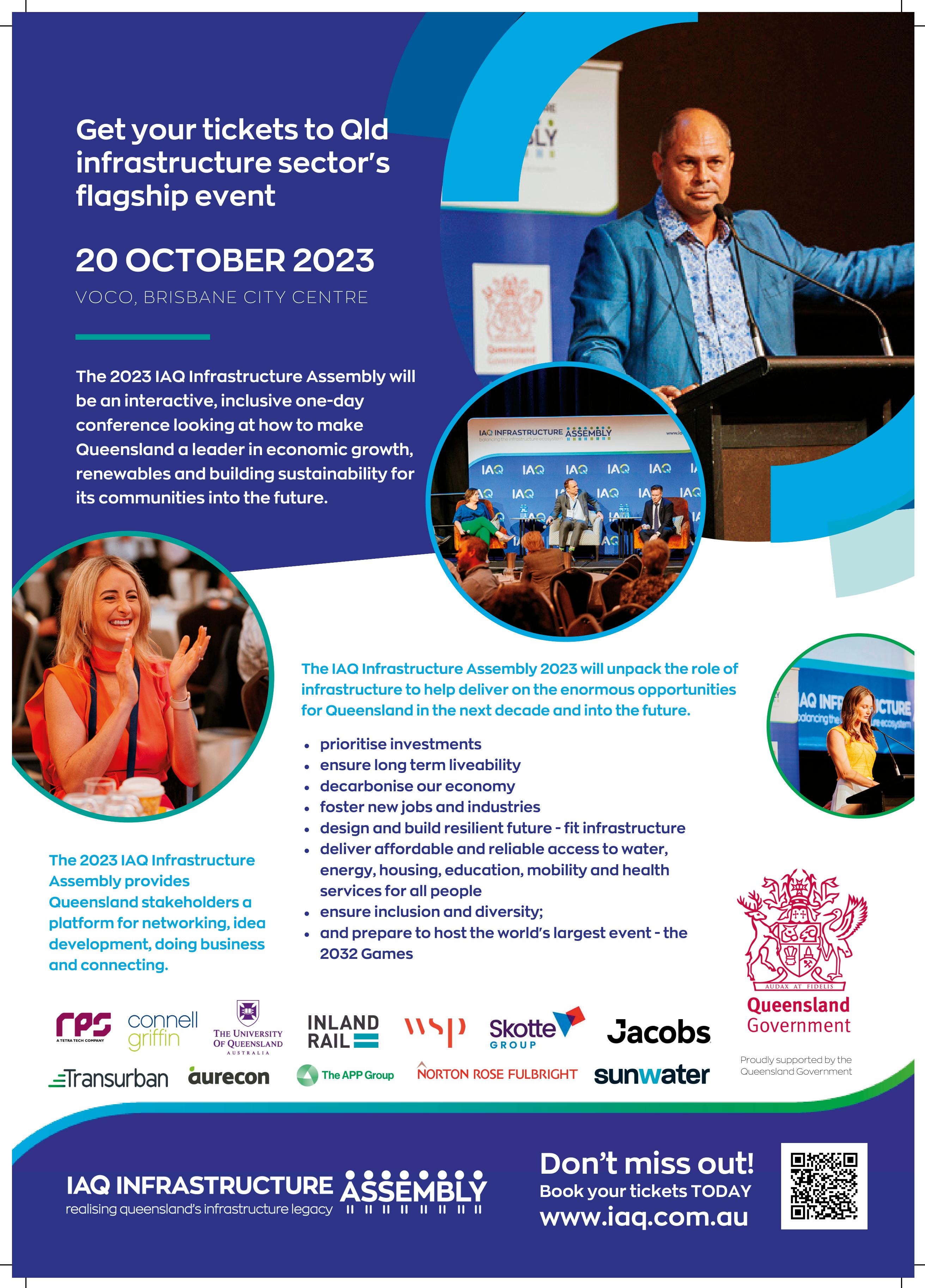
Federal Minister for Infrastructure, Transport, Regional Development and Local Government, Catherine King, said the Federal Government is jointly funding the Majors Road interchange project to ensure smoother and safer traffic flow.
“This project will provide commuters in Adelaide’s southern suburbs with better access to the Southern Expressway, while providing all commuters improved access to Glenthorne National Park – Ityamaiitpinna Yarta, the Sam Willoughby International BMX Facility and the Southern Soccer Facility from the Southern Expressway,” Ms King said.
The project team has worked closely with the Friends of Glenthorne, a local volunteer group, to improve environmental outcomes for Glenthorne National Park – Ityamaiitpinna Yarta both during and after the construction of the interchange.
As a result of this collaboration, a new plant nursery and garden area will be funded and built. The nursery will assist with the project’s vegetation offset requirements and continue to support the Friends of Glenthorne’s conservation and re-vegetation activities into the future.
South Australian Minister for Infrastructure and Transport, Tom Koutsantonis, said that while the current project design of the Majors Road Interchange ensures no impact to significant vegetation and minimal impact to the Glenthorne National Park – Ityamaiitpinna Yarta as a whole, the government is still working to give back to the environment.
“The Friends of Glenthorne do fantastic volunteer work to protect Glenthorne National Park –Ityamaiitpinna Yarta, and this plant nursery will empower them to do more great work, while helping the project to offset its environmental impacts,” Mr Koutsantonis said.
“This is a great example of how major infrastructure projects can take a collaborative approach to improve outcomes for local communities and the environment.”
Federal Member for Kingston, Amanda Rishworth, said the contract award is the next critical step in delivering this project, which will benefit drivers of the more than 13,000 vehicles who use Majors Road each day, a number that is expected to grow with the easier access to sports facilities and Glenthorne National Park.

“The project will also benefit the 74,000 vehicles using the Southern Expressway between Darlington and the Reynella Interchange each day,” Ms Rishworth said.
“The needs of the environment were placed front and centre in this project with increased support for the Friends of Glenthorne’s conservation and re-vegetation activities, which I hope will attract more people in the local community to get outside and enjoy the benefits of volunteering.”
Major construction on the Majors Road Interchange Project is expected to begin in the last quarter of 2023 and final project completion is expected at the end of 2025.
12 NEWS

HOW THE INDUSTRY IS WORKING WITH FIRST NATIONS COMMUNITIES
 By Adam Copp, CEO, Infrastructure Australia
By Adam Copp, CEO, Infrastructure Australia
The infrastructure industry is increasingly playing a significant role in delivering meaningful outcomes for First Nations communities, thanks to methodical and thought-out engagement frameworks.
September 2023 // Issue 28 www.infrastructuremagazine.com.au
14 A WORD FROM INFRASTRUCTURE AUSTRALIA
Every year, in the first week of July, Australia celebrates NAIDOC Week, which is a time to recognise the history, culture, and achievements of Aboriginal and Torres Strait Islander people.
The theme for the week was ‘For Our Elders’, which acknowledges that across every generation, Elders have, and continue to play, a significant role as stewards for their respective community’s history, traditions, customs, and cultural connections to Country.
It serves as a reminder about the important role Elders have with helping us engage with their communities and understanding their needs when delivering major projects.
Over the years, the infrastructure industry has started to make significant inroads into improving the way we engage with First Nations communities, especially in respecting the unique role of Elders, when looking to plan for and deliver major projects.
A WANT AND NEED TO ENGAGE
As the nation’s independent infrastructure adviser, Infrastructure Australia has observed State and Territory Governments undertake specific stakeholder engagement with First Nations communities in their major projects.
In fact, as part of our assessments of nationally significant projects, or where a proponent is seeking $250 million or more of Commonwealth funding, we see proponents regularly acknowledging the importance of undertaking engagement with these communities.
Better still, we see an expressed intention to engage with these communities, whether it be in metropolitan areas or in the regions.
While it is pleasing to see the acknowledgment and the intention of proponents to engage with these communities, what is more pleasing is the follow through with some strong examples of First Nations engagements that have been led by State and Territory Governments.
Right across Australia, State and Territory Governments have developed specific frameworks that ensure project delivery teams speak directly with key First Nations communities. These strategies go beyond simply helping embed their respective history and culture into the design of a project, or using a project to help preserve the cultural connection they have to the land.
They go further by facilitating Aboriginal and Torres Strait Islander involvement in the whole process of infrastructure project planning, decision-making and delivery, by making sure there are considerations given to procurement and employment.
EXAMPLES OF BEST PRACTICE
There are a number of examples across Australia where both companies and governments alike have developed effective engagement frameworks to include Aboriginal and Torres Strait Islander communities in infrastructure project planning, decision-making and delivery.
One example is the Western Australian Government’s engagement approach for its METRONET program.
The State Government has created an Aboriginal Engagement Strategy, which outlines their commitment to embed “genuine engagement with the Aboriginal community” across all METRONET transport infrastructure and station precinct projects.
Titled Gnarla Biddi, which translates to ‘Our Pathways’, the strategy sets out five streams of engagement running through each stage of the project life cycle.
These streams include Noongar Cultural Recognition, Noongar Cultural Input into Place Making, Aboriginal Procurement, Aboriginal Employment, and meeting legislated requirements for Land Access and Sites Management.
This strategy is implemented by requiring project delivery teams to prepare an Aboriginal Engagement and Participation Plan prior to a contract being awarded, that outlines how they intend to embed these engagement streams into their project delivery processes.
What this engagement strategy provides is a genuine opportunity to include First Nations people in the entire process.
Better yet, it offers an opportunity to include Aboriginal and Torres Strait Islander people in the procurement and employment needs of a project.
Another example is the New South Wales Government’s Recognise Country: Guidelines for development in the Aerotropolis.
This set of guidelines provides practical tools to deliver positive outcomes for the First Nations people in the Aerotropolis and Western Parkland City of New South Wales. More specifically, the guidelines set out the importance of meaningful consultation and responding to Aboriginal culture and knowledge, through the design process.
Among the objectives detailed in this document, is a need for anyone wanting to build in the region to undertake meaningful engagement with Traditional Custodians and knowledge holders.
This engagement is to ensure Aboriginal perspectives and needs in the built environment are met, while also ensuring their values are captured as well.
Included in the guidelines is also an overview of all the steps to be considered by including economic development opportunities. In fact, the document outlines that all development within the Aerotropolis should aim to promote economic development opportunities for Aboriginal people.
There are also countless other national and state-focused guides and policies on the importance of proper engagement with Aboriginal and Torres Strait Islander communities.
These include the National Indigenous Infrastructure Guide, Transport for NSW’s Beyond the Pavement policy, and the Victorian Level Crossing Removal Authority’s Indigenous Design Guidelines.
Most of us still have much to learn on how to engage with First Nations’ communities. What these plans, strategies, guidelines and policies provide is an important framework for us all to build on, to deliver meaningful outcomes for First Nations’ communities.
www.infrastructuremagazine.com.au September 2023 // Issue 28 15 A WORD FROM INFRASTRUCTURE AUSTRALIA
IS THERE A WAY OUT?
CONSTRUCTION INSOLVENCIES MUST STOP
By Shivendra Kumar, Principal Consultant, Shivendra and Co

In March of this year, Canberra-based PBS Building joined a growing number of major Australian construction companies that have collapsed – yet another sign that the industry needs to reform.
In a joint statement on 7 March 2023, PBS announced the decision to put its New South Wales, Australian Capital Territory and Queensland construction businesses into voluntary administration.

Company founder, Ian Carter, pointed to the challenges of material costs, fixed price contracts, labour and material shortages, extreme weather events and wars.
“We are the latest, but we won’t be the last construction group to buckle under the weight of a broken industry and way of doing business that needs urgent reform,” Mr Carter said.
Unfortunately, as someone who has made this industry my career for over two decades, I know Mr Carter is right.
PBS is just one of many who have fallen in the past twelve months, alongside companies such as Melbourne-based Interface Constructions Victoria – which entered external administration in early May.
Construction industry insolvencies have reached their highest levels in almost a decade, with recent figures from
September 2023 // Issue 28 www.infrastructuremagazine.com.au 16 INDUSTRY INSIGHT
ASIC showing companies going into external administration for the first time hit 1672, with 71 of those occurring in April.
While residential builders dominate the list, there are dark clouds over the civil and infrastructure sector. According to data and analytics company Equifax, in Q1 for FY23, the residential sector saw a 33 per cent downgrade of credit rating, followed by 32 per cent for commercial builders and 23 per cent for the civil and infrastructure construction businesses.
With these indicators, the industry must reform now or more businesses will suffer a similar fate.
WHAT NEEDS TO CHANGE
First and foremost, construction companies should not be treated like banks.
In a statement last year, Australian Constructors Association CEO, Jon Davies, said the industry has essentially had to bankroll projects on behalf of clients.
“Construction is one of the few industries operating under a cash negative payment regime where work is undertaken for third parties without payment until after materials have been ordered and fixed to site,” Mr Davies said.
“Airbus requires 20 per cent of the capital costs to be paid upfront before manufacture of a new plane and with a price tag of US$445 million – this is an investment that is comparable to a mid-range construction project.
“Construction projects are no different to any other significant purchase and should be financed through institutions that are appropriately set up to do this.”
In conversations I have with subcontractors, the biggest challenge they manage is cash. There is unanimous agreement that better payment terms will be an enabler – many hesitate in recruiting capable people, investing in technology and equipment as they fear they won’t be able to fund these areas long term.
CLIENTS HAVE A BIG ROLE TO PLAY
Governments must be transparent and encourage transparency on how project costs are allocated and what value head contractors ‘create’ versus value subcontractors –who perform the work – create.
Clients must relook at how they pay contractors and work in the best interests of the industry and not their own.
I discussed these issues previously in an interview with CEO of Civil Contractors Federation New South Wales (CCF NSW), David Castledine, and it’s worth repeating his thoughts on the issue here.
“In late 2021, CCF New South Wales undertook a survey of members to which 35 per cent responded. It found that 30 per cent of respondents – contractors – lost money. 25 per cent of that group made less than five per cent in profit. We’re seeing wafer-thin margins,” Mr Castledine said.
“In that 2021 survey, 40 per cent of our respondents had a decrease in revenue compared to 2018 and 16 per cent of them had cuts in revenue growth. That’s not a picture that’s synonymous with an infrastructure boom.”
I agree head contractors are not charities or not-for-profit organisations, but the same goes for subcontractors.
How can the industry drive accountability, especially when it comes to nation-building projects?
One way forward is to develop an industry index which tracks value created in the field, versus overall value of the project.
Similarly, the role clients play when businesses are involved needs to be assessed and reported.
A PIPELINE OF WORK LEADS TO LONG-TERM SUCCESS
An extended pipeline of work means businesses can invest in automation, technology, equipment and people, which enhances productivity and profitability consequently.
The industry currently invests on its own, with the uncertainty of current project performance and uncertainty of a pipeline, keeping them one decision away from success or failure.
Imagine awarding ten individual bridges over ten years or a major project with multiple smaller work packages over a few years to a group of construction companies – such an approach will enable investment in people, equipment, materials, methods, systems and even R&D.
Over time, investment in these areas makes business more viable, improves efficiency, reduces costs and scheduled overruns, and possibly keeps the cost of constructing infrastructure steady over longer periods.
ACKNOWLEDGE WHAT YOU DON’T KNOW
A lot of construction businesses are built on technical knowhow and not on business know-how.
Important fundamentals are often overlooked by business owners and non-technical expertise isn’t given sufficient value until a problem hits. There is inadequate attention on business plans, strategy, definition of business processes, alignment of roles and methodology behind investments.
While the above isn’t the primary reason why the big names fall, it definitely has an impact, we just don’t hear about it. Business owners need to engage the right expertise to help them build their business, just as they are engaged in the expertise areas of their business, and give it the necessary attention.
Otherwise, the same mistakes keep repeating.
Look at the urgency to meet tender or delivery deadlines versus the number of times a strategy review or a forecasting meeting is rescheduled.
Successful organisations, mainly outside of construction, have good vision, execute their strategy well and maintain rigid processes and methods throughout their growth periods. With challenges the construction industry deals with, these elements become more important.
For businesses that have struggled or even collapsed, their problems can be traced back to long before they ran out of cash. Most likely it started with lack of fundamentals such as capability development, risk management, business plans, decision-making hierarchies, recruitment and the absence of process controls in the formative years of business.
Expertise and guidance is available. Engaging the help of experts who can provide support for business fundamentals will be less painful than dealing with liquidators down the track.
From my own experience of helping growing businesses, these fundamentals have provided business owners and leaders with clarity, helped them identify and avoid risky opportunities, recruit the right resources and most importantly, create a positive culture that delivers business outcomes sustainably.
More insolvencies are expected, so businesses should take heed of what’s happening and turn their attention to creating an ecosystem of contractors and subcontractors working together to build Australia’s future. Opportunities exist – it’s what the industry, from the client to the supplier or subcontractor at the end of the value chain, decides to make of it.
www.infrastructuremagazine.com.au September 2023 // Issue 28 17 INDUSTRY INSIGHT
THERE’S A SOLUTION TO AUSTRALIA’S PRODUCTIVITY PROBLEM: DIGITAL BY DEFAULT
By Jonathan Cartledge, Chief Executive Officer, Consult Australia

In June, after Australia posted its largest fall in national productivity on record, federal Treasurer Dr Jim Chalmers noted that the solution was not “trying to make people work longer for less” but about “investing in their skills and their capacity to adopt and adapt technology”. This statement must come as a relief for the two thirds of people in the construction industry who reportedly already work more than 50 hours a week, and symbolises the need for change.
Everyone knows our industry must change. We can all see the consequences of being slow off the digital mark: three decades of sluggish productivity and priceless data lost in paper and PDFs.
But now, recessionary red flags and budget black holes mean we can’t build the way we thought we could. After years of record levels of infrastructure investment, governments are looking to reschedule or, worse, ‘reprioritise’ some projects in their pipelines.
The Federal Government is currently undertaking a strategic review of its infrastructure investment program to ensure projects contribute to a “more productive, sustainable and liveable Australia”. This is important.
At the same time, we know we need these projects. That’s why we prioritised them in the first place.
But reviews, rescheduling and reprioritisation do not support long-term business planning. Uncertainty is already causing industry confidence to waver. Consult Australia’s latest skills survey found businesses engaged in the design and delivery of infrastructure projects are hesitant to invest beyond the next six months.
This uncertainty has cascading implications for our workforce, skills development and business growth, and it plays out in everything from demand for office space, to investment in digital systems.
September 2023 // Issue 28 www.infrastructuremagazine.com.au 18 INDUSTRY INSIGHT
However, it doesn’t have to be this way. We can deliver the infrastructure we need now while investing in the skills and systems to build smarter next time.
A NEW SOURCE OF COMPETITIVE STRENGTH
Building smarter starts by embracing ‘digital by default’ – one of the recommendations outlined in the Australian Infrastructure Plan in 2021.
Within 10 to 15 years, Infrastructure Australia envisaged that all Federal Government projects would feature digital twins, a national digital infrastructure roadmap would be rolled out, and that digital asset ‘champions’ would be appointed to each project with a value of more than $50 million.
But can we afford to wait a decade or more for digital by default to take off?
Industry productivity today is lower than it was in 1990. The annual hit to the economy – from cost blowouts, program delays and legal disputes – is $47 billion a year, according to estimates from the Australian Constructors Association.
Can we afford to squander nearly half a trillion dollars in lost productivity over the next decade?
Digital technology allows us to work smarter, not harder, and to deliver broader benefits across the economy – and this is why Consult Australia is leading a new campaign, Digital by Default.
In June we launched a green paper for reform that outlines how Australia’s governments can increase productivity and produce better outcomes from infrastructure investment. It all starts with a new national office for Digital by Default in Infrastructure.
Businesses in the infrastructure sector are waiting for governments to set standards for digital working. Governments are waiting for market forces to determine the pathway forward. What we need is a national body that coordinates efforts and champions Digital by Default on every infrastructure project.
We think a national coordinating office is a common sense solution and a modest investment, given the Federal Government maintains a commitment to a $120 billion ten year rolling infrastructure pipeline. It makes sense to invest just a fraction to establish a forum for digital champions to share information and set national standards.
We cannot have eight different standards for digital infrastructure – that’s just revisiting the rail gauge problem that plagued the nation for 150 years. Instead, we can use our federation as a source of competitive strength.
DIGITAL AT SPEED AND SCALE
There are challenges ahead that can only be dealt with by digital technology. Net-zero is one challenge, and delivering affordable housing at speed and scale is another.
Some states are already driving a strong digital agenda, and this process gives us a platform to share best practice. The Victorian Government's Digital Asset Policy, for instance, sets minimum actionable digital practices and standards to improve productivity for project delivery.
The New South Wales Government is currently mapping the entire state for a spatial digital twin. Industry forums are also forging ahead, like the Australasian BIM Advisory Board and the Building 4.0 CRC.
But there is a reason why we have called our call to action ‘Digital by Default’. World-leading digital practice remains siloed and innovative ideas are not replicated across projects or states. A ‘digital by default’ mindset is not business-as-usual across the project lifecycle at the national level. As a consequence, Australia trails many other developed nations for digital capacity and readiness.
So, what happens next?
We are now calling for the industry's feedback, with roundtables around the country to confirm the consensus view and set the direction for national leadership before we launch the final plan before the year is out.
Rewind nine years and the Productivity Commission was about to release findings into the cost escalation of public infrastructure projects. The Productivity Commission argued that, without the right data and access to information, governments could “learn more slowly or not at all”.
Fast forward nine years and we’ll be gearing up for the Brisbane Olympic Games. Will we have captured the Olympic-sized opportunity to grow our digital skills base and promote innovation? Or will another once-in-ageneration opportunity have passed us by?
The best time to invest in digital capability was undoubtedly nine years ago. The next best time is today. There’s no time to lose.
www.infrastructuremagazine.com.au September 2023 // Issue 28 19 INDUSTRY INSIGHT
OPINION: BUILDING FOR A BETTER AUSTRALIA
By Senator the Hon Bridget McKenzie, Shadow Minister for Infrastructure, Transport and Regional Development and the Nationals Leader in the Senate
Australia’s population is forecast to grow by the size of the city of Adelaide in the next five years, according to the 2023-24 Federal Budget.
This rapid increase in migration is being used to shore-up our skilled labour market and support economic growth after the COVID-19 slow down. However, increasing our population by 1.5 million people without a plan for the necessary infrastructure is something I do not support.
The success of this migration effort must be accompanied with the supporting infrastructure to meet the demand of a larger population.
As the Shadow Minister for Infrastructure, I believe that a strategic approach to infrastructure investment is essential in supporting economic growth and boosting national productivity.
It is my primary objective to be constructive in this role to ensure that together we are building a more prosperous, sustainable, safe and strong future from the capital cities to the suburbs and remote corners of Australia.
My job is to collaborate and contribute to set an alternative policy direction as part of an economic blueprint for a future Australia.
However, it is also my responsibility as Shadow Minister to critique the government’s decisions and policies to ensure we strive for the best outcomes for the Australian public.
Rapid infrastructure growth should not come at the cost of worsening congestion, gridlocked streets and unsafe roads.
In government, the Coalition made record investments in infrastructure.
Prudently we were willing to invest when the cost of money was low, to deliver a much needed boost to the nation’s capital stock, and enhance the economic capacity of the regions which will be most affected in the transition to net-zero.
In times of challenging global economic headwinds, rising cost of money and increased State Government indebtedness, it may be tempting for the current Federal Government to pull back from an ambitious and bold infrastructure agenda.
It is my view that it is vital to economic growth to maintain the focus on delivering the economic infrastructure needed to support industry and a growing population.
To give infrastructure planning the certainty and continuity it needs, the Coalition put in place a $120 billion 10 year Infrastructure Investment Pipeline.
This pipeline ensures that local roads, key freight routes, ports and rail corridors are expanding in the right places and that proper planning can be made by industry.
Delivering projects requires long timelines for planning, design, and construction. As I have said on many occasions, the Minister announcing a project is rarely the Minister cutting the ribbon.
The Labor Government decided to conduct a review into more than 400 infrastructure projects in the Infrastructure Pipeline while making significant cuts to infrastructure spending in their first two budgets.

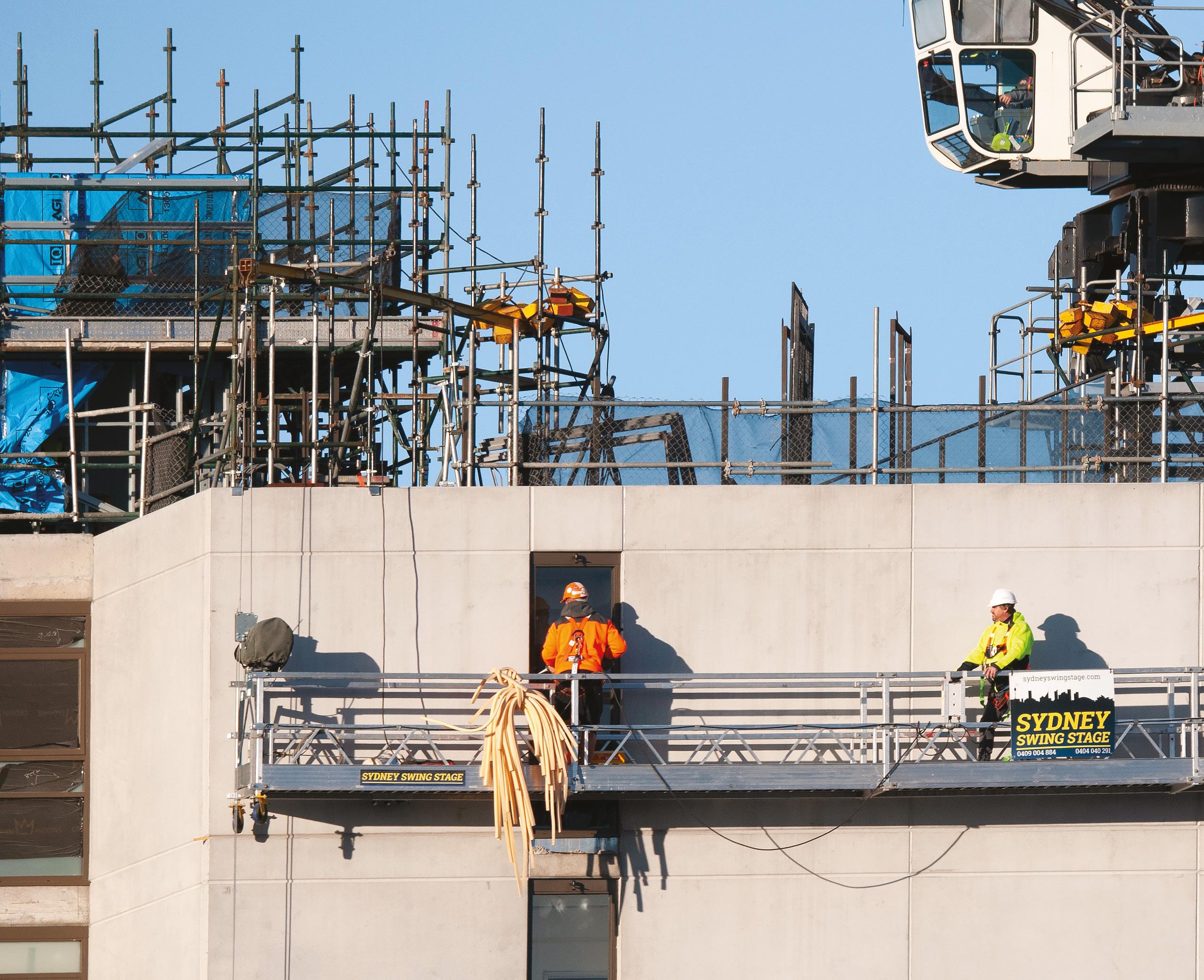
September 2023 // Issue 28 www.infrastructuremagazine.com.au 20
INDUSTRY INSIGHT
As a newly elected government, I respect the Labor Government’s right to conduct this review.
However, the review has resulted in considerable uncertainty which is being felt most acutely by businesses that had been contracted to deliver the projects that have been put on hold, along with communities who have been waiting for critical infrastructure projects to be delivered.
Construction companies that have secured materials, workforce, equipment and have scoped the delivery timeline, have been required to suspend operations with no certainty of continuing.
The cost of delays affects company profits which are already under pressure from inflation, supply and labour shortages.
Businesses require greater transparency and assurances from the government to allow them to minimise the cost fallout of delaying and halting projects.
Tier 2 and tier 3 contractors in particular bear the brunt of this uncertainty.
At a time when insolvency is running rife throughout the construction industry, business viability needs to be a key consideration of government.

A broader concern is that the 90-Day Infrastructure Review may also result in transport infrastructure projects of national significance being shelved or delayed significantly.

Examples include:
♦ The $12 billion Melbourne Airport Rail Link project put on hold by the Victorian Government. This project has been in the works since 2014 with the $5 billion committed by the Commonwealth and matched by the Victorian Government. If this project is not delivered, Melbourne will remain one of a tiny few major international airports without a rail link.
♦ Major upgrades to the M1 Pacific Highway in New South Wales, as well as improvements to bust congestion and improve freight efficiency on the M5, M7 and M12 motorways have been captured by the review.
♦ In Queensland, plans to build transformative new rail to the Gold and Sunshine Coasts are at risk of being scrapped, as well as future stages of the $13 billion Bruce Highway upgrade project.
♦ In South Australia plans to take trucks off the dangerous South Eastern Freeway and suburban streets by progressing a greater Adelaide freight route, starting with the Truro bypass, have been delayed.
In addition, ongoing road funding and road safety programs were referred to the review, raising concerns about the future availability of funding that councils have relied on for decades such as the Roads to Recovery program, Bridges Renewal Program and the Black Spot program.
Unfortunately, the new government’s response to the Coalition’s bold infrastructure vision that included Western Sydney International Airport, Melbourne Airport Rail, the Outback Way, Inland Rail and Middle Arm ports infrastructure has been a live music stadium, another AFL ground and an unfunded suburban rail loop costing over $200 billion.
The government of the day is entitled to make discretionary decisions and set the agenda. However, as the Shadow Minister it is my responsibility to scrutinise that agenda to ensure Australia benefits well into the future. It is a responsibility I take seriously.
21
www.infrastructuremagazine.com.au September 2023 // Issue 28 INDUSTRY INSIGHT
IN FOCUS: NAIF’S NEW BOARD MEMBER TALKS HISTORY, IDENTITY AND GROWTH
By Holly Tancredi, Contributing Editor
Australia has been defined by its past decisions, and so too will today’s decisions define its future. Through the northern regions of Australia, the Northern Australia Infrastructure Facility (NAIF), a Federal Government entity, works to facilitate growth through investing in major infrastructure developments and increasing private sector interest. The most recent appointment to its Board is Vanessa Elliott, a Jaru woman with over 30 years experience working across government, industry, and community.
Ms Elliott spoke to Infrastructure Magazine to discuss her new appointment, and how her work is influenced by her cultural identity.
“My life focus is nation building, sustainability, economic inclusion and above all else, being a devoted mum. For me, there is a lot to learn from the North,” Ms Elliott said.
Ms Elliott made clear the value of her own identity and history, and how it continues to influence and connect to her work.
“It is important that we embrace the total sum of our identity.
“So much of Australia was settled under duress. Some call it frontier conflicts, others genocide. Time continues over 100 plus years to unravel
its own story and on our watch; we must listen, linger, leverage opportunities for an inclusive nation. We must keep moving forward promoting care, unity and equality.”
Ms Elliott was straightforward in her description of Australia’s complex past and her personal feelings towards embracing inclusion. It is clear that her respect for the complexities of Australia’s history and the need for compassionate understanding will directly impact her newly appointed role.
“Our shared national history had past hurts that included displacing First Nations and rendering us invisible through Terra Nullius. We can learn from the past, and that’s why Australia now has Land Rights, Native Title, and Indigenous Land Use Agreements.
“I am equally comfortable with the many migrants who left a life to be something here. I know silence is also speaking and I am forever inspired by these stories and their contribution to regional and remote Australia.”
With historical roots from the Kimberley region of Western Australia, Ms Elliott also has family and cultural connections across the Western Desert, Central Australia and Northern Queensland, the very regions the NAIF covers.
“My grandfather was a drover and had Aboriginal Chinese heritage and my Jaja (maternal grandmother) was a cultural leader and historian with Aboriginal Irish heritage. The Irish link to the Durrack’s. My grandparents owned and ran their own cattle station during the rise of the Pastoral Industry. The Chinese link
September 2023 // Issue 28 www.infrastructuremagazine.com.au 22 DIVERSITY IN THE SECTOR
came from Hong Kong to Northern Australia during the Gold rush era,” Ms Elliott explains.
BUILDING OUT OF THE RUBBLE
As part of the NAIF, Ms Elliott’s role includes funding projects that deliver wide-reaching public benefits, while ensuring those projects provide strong indigenous outcomes and opportunities.
Ms Elliott said developing Northern Australia with the NAIF Mandate will lead the country in its “truth-telling and inclusion with global economic gains”.

“It is so important as a nation, we rise up from the rubble of our past – never deny it – but seek a way forward, to bring purpose to the past pain, and honour, to the healing process.
“I am acutely aware of racial, economic, environmental and geographical marginalisation.
“This includes how to make room, be balanced, how to design and be intentional about how we strengthen Northern Australia through NAIF’s Mandate.”
THE GROUNDWORK FOR SUCCESS
With ample experience behind her, Ms Elliott understands there’s a multitude of values and metrics that will form the basis of success in her new role.
Having a sense of place, at a localised level is a key interest of Ms Elliott, who places great importance on the “tenacity to be bold, to be global, to serve our local” while also building up Australia’s ecology and economy under sustainability tenets.
www.infrastructuremagazine.com.au September 2023 // Issue 28 23 DIVERSITY IN THE SECTOR
Ms Elliott with her Jaru Elders, Aunty Lizzy and Janet Jingle, at the Mangkaja Arts Centre, Fitzroy Crossing, Kimberley region of WA. Image: Vanessa Elliott.
“I believe economic development deliverables and infrastructure is the greatest pulse check of who we serve. It sums up a nation’s health especially the social determinants, its fiscal flows, and how they support diversified economies, and even circular economies, as a measure of inclusivity.
“My career was built on responding to development coming to regional and remote Australia and how we can derive mutual benefits. These range from the Aboriginal Art Centre in the early 1990s, to national road networks, rail lines, ports, headworks to mining, energy mega projects, and land use.
“This diversity has shown me the power of intentionality in a plan.”
Ms Elliott also said it will be a key priority for her to listen to the market and what it wants to lean into and share.
“My focus is always about what reaps a multiplier effect. What builds sustainable service systems, and logistics? What builds identity, purpose, belonging and branding to northern Australia?”
THE PRICE OF GROWTH
What makes the northern regions unique also creates challenges around movement and costs.
This cost, Ms Elliott said, is why the NAIF board exists.
“Growing up it was cheaper to fly around the world than to fly home to Halls Creek or Kununurra,” Ms Elliott said.
“The cost to do business in the North, the elements, and the need to keep pace with global demand whilst honouring the local – it’s the greatest challenge for us all.
“We must promote our pristine environments, wide open spaces and invest in the right network governance, industries, commodities and innovation to attract more investment and opportunity.
“The challenge is to meet demand and to support those who want to be a supplier of choice in Northern Australia.”
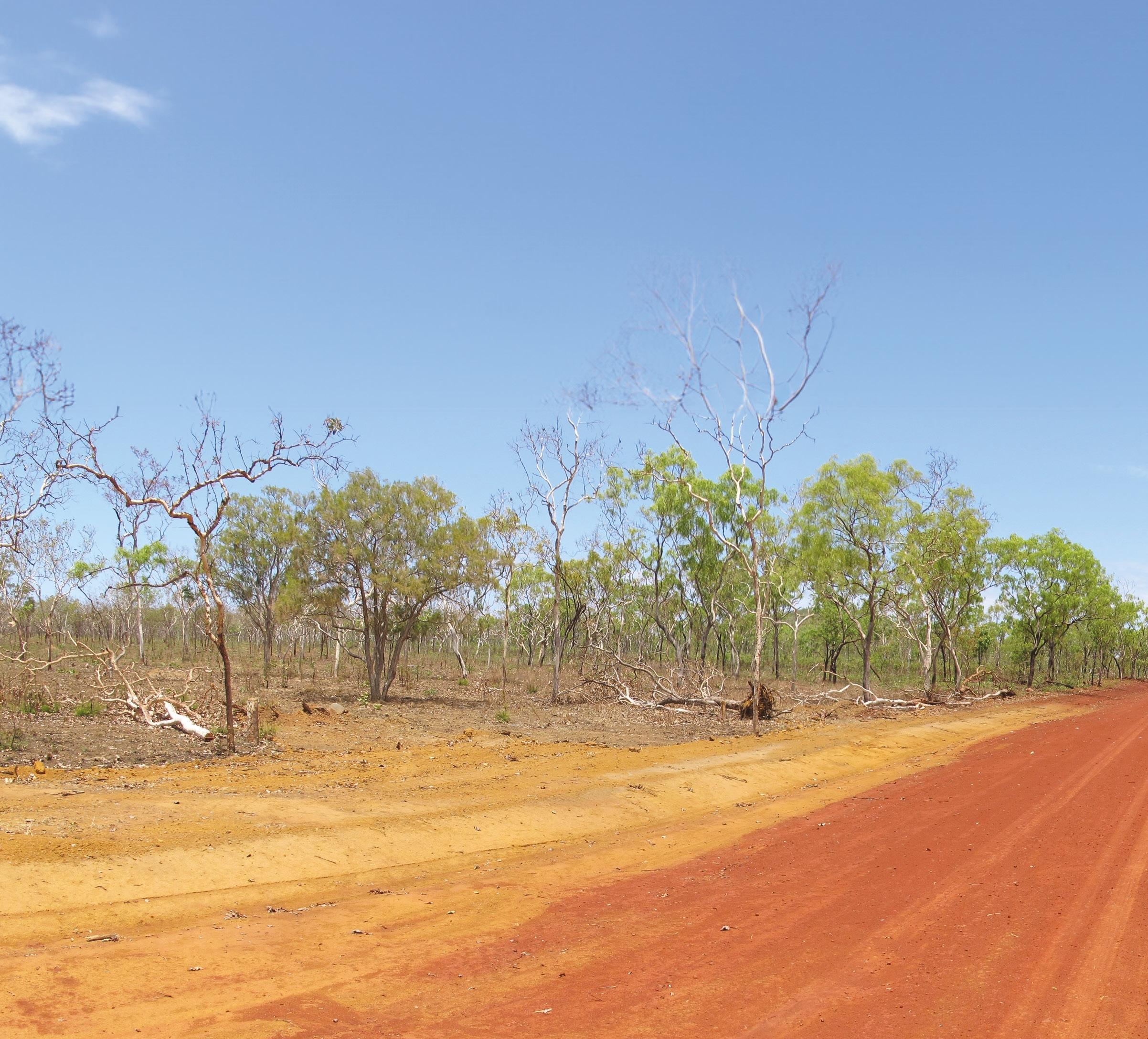
Looking ahead, Ms Elliott is determined to support the region to prosperity where “heritage is honoured, hope is encouraged and help is at hand”. “Change comes from those with the courage to facilitate change to be seen, heard and responded to.”
FUTURE GENERATIONS
Speaking fondly of her daughter, Ms Elliott reiterated a well-known but astute statement regarding the need for diverse representation: “We can only be what we see”.
“My daughter spent her early years in Halls Creek and now she is working in the USA,” Ms Elliott said.
“Economic development and infrastructure make permanent impressions on future generations and we need to prepare rites of passage for our young people to prosper.
“I have worked on many infrastructure projects and look forward to the day that the talent from human services, residential planning, and industrialised planning, work collectively in remote and regional areas to truly co-design, map, develop and deliver intergenerational life course opportunities for live, local communities.
September 2023 // Issue 28 www.infrastructuremagazine.com.au 24 DIVERSITY IN THE SECTOR
“Northern Australian children should be given every opportunity to be as innovative and courageous as the marketplace will empower them to be.
“I believe when we face our histories, we should make room for place based stories and honour.
Ms Elliott reflected on the importance of organisations such as the NAIF, with a final reminder that Australians should serve their communities, and help build a society and future that is representative and inclusive of all its residents.

“We shall be known best for how we serve our own.”
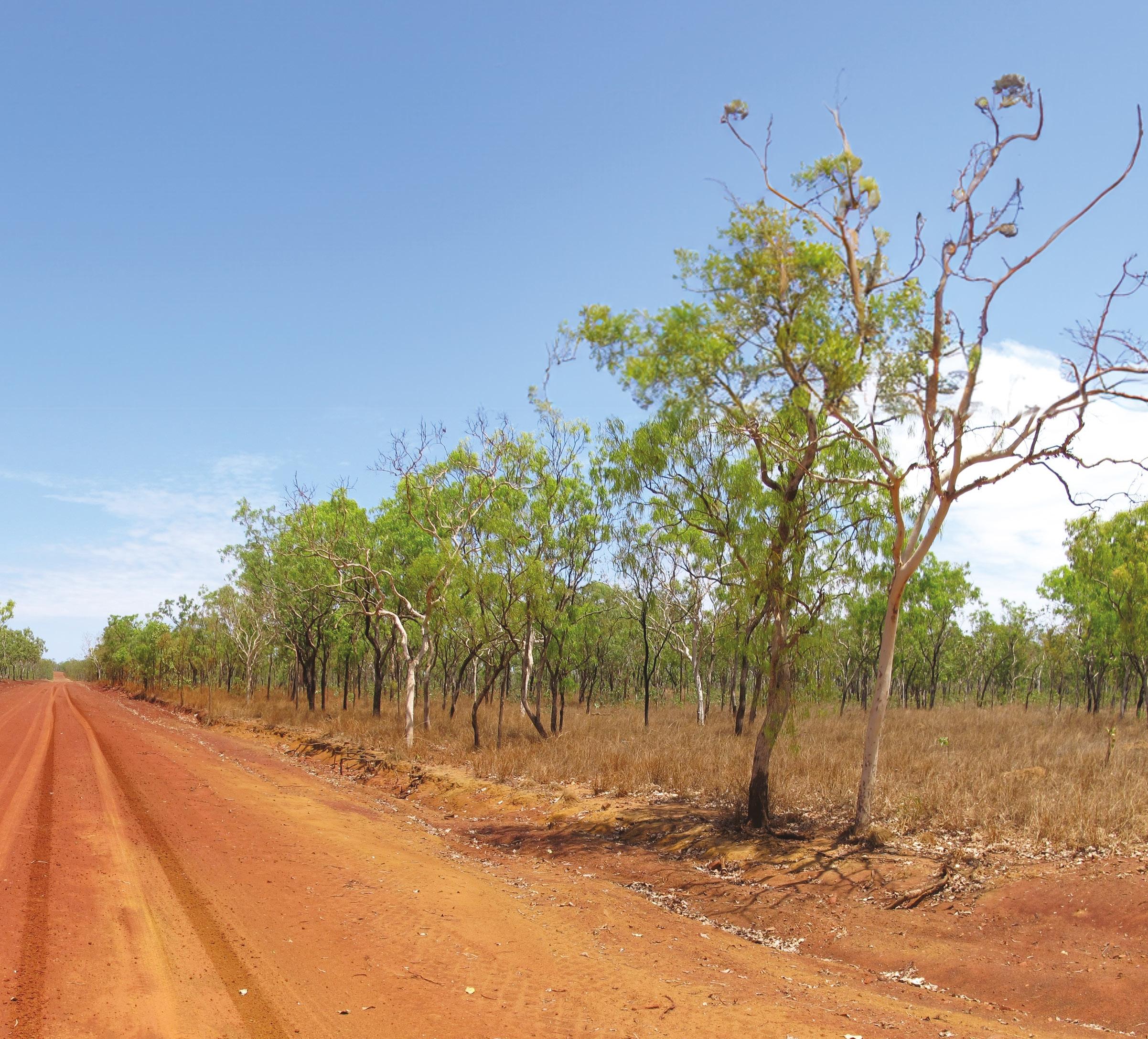
www.infrastructuremagazine.com.au September 2023 // Issue 28 25 DIVERSITY IN THE SECTOR
“It is an honour to be a NAIF Board member and a nice way to round off 30 years working for government, industry and community.”
THE THREE LINES OF DEFENCE: DIGITAL SECURITY IN AN INTERCONNECTED WORLD
In today's interconnected world, digital
which nbn – the driving force behind lifting the
knows more than most.
In 2009, the Federal Government established NBN Co with a distinct purpose: to construct, develop and manage a nationwide wholesale broadband access network for Australia.
The nbn network now provides digital connectivity to over 12 million premises around Australia, with the importance of cyber security rising sharply since 2009.
Australian companies encounter many cyber security challenges, encompassing conventional and emerging threats – anticipating the occurrence of data breaches or the precise timing of an impending threat is often a very complex task.
nbn has adopted an 'all hazards or converged' security model, which prioritises and aligns personnel, physical and cyber security to ensure fast and reliable connectivity and one that aims to create a safe and secure environment.

THE LAST WALL(S) OF DEFENCE
nbn's security model is based on a comprehensive understanding of security and follows the 'three lines of defence' principle to fortify its security measures:
♦ Line one comprises the operations team responsible for implementing and maintaining the security ecosystem, ensuring the availability and effectiveness of tools, processes, and controls
♦ Line two acts as an independent assessor and business partner of line one, identifying potential gaps, points of improvement or vulnerabilities, and then working with the line to continually improve our effectiveness
♦ Line three provides independent assurance of lines one and two, providing appropriate governance, alignment and accountability are maintained
During interactions with property developers, nbn aims to focus not just on current connectivity solutions but also on future-ready technology, to help ensure it's ready to meet the digital demands of tomorrow.
A VITAL PART OF THE COMMUNITY
As nbn extends its connectivity services to new developments and, by proxy, becomes increasingly important to many community services, such as electronic signage and public Wi-Fi, nbn's supply chain continues to play a vital role.
Like any property company, nbn faces the challenges of managing an extensive and complex supply chain.
The supply chain's crucial role in ensuring the security of nbn is maintained, and the ongoing focus the organisation places on working collaboratively with its partners, will ensure this happens.
September 2023 // Issue 28 www.infrastructuremagazine.com.au 26
security has become a paramount concern,
digital capability of Australia –
Find out more about nbn co, visit www.nbnco.com.au


Made with experience As one of Australia’s largest broadband networks, our dedicated and experienced nbn® New Developments team has delivered nbn network access to more than 1.2 million new development premises nationwide. Make nbn part of the plan Visit nbn.com.au/newdevelopments We can do more for your build
Q&A: NEW GIIA CEO DISCUSSES
SECTOR'S BIGGEST CHALLENGES, ECONOMIC OPPORTUNITIES
As the membership body for some of the largest infrastructure investors and advisors in the world, GIIA collectively represents US $1.6 trillion in infrastructure assets.
Now at the helm of this global powerhouse, Mr Phillips –who joined the organisation in 2016 and served as acting CEO from December 2022 – explains the biggest trends, and issues, in the sector presently and in the future.
HOW DOES THE GIIA HELP MEMBERS NAVIGATE THE INFRASTRUCTURE INVESTMENT ENVIRONMENT AND WHAT LED YOU TO TAKING THE HELM OF THE ASSOCIATION?
We were founded in 2016 out of recognition by some of the major players in the sector that it was time the asset class had a more coordinated voice and improved dialogue with policy makers, politicians and regulators.
Infrastructure usually sits at the interface of public sector policy and private sector delivery, so advocacy remains at the heart of what we do, but we also have a role to convene our members, share market insights and help build professional networks. We have an international programme of events and thought leadership designed to help members navigate the market.
Our aim is to play an important role in ensuring policy makers and regulators understand and take account of the implications of their plans when it comes to impacting investor confidence and investment opportunity. Working in a complementary way to sector-specific trade bodies, we
can bring the views of global investors that are sometimes overlooked, as we did with the Australian Energy Regulator (AER) in autumn 2022 in its consultation on rates of return.

Prior to joining GIIA in 2016, I led communications and stakeholder relations at the UK’s Nuclear Decommissioning Authority and before that at Heathrow Airport. Between the three roles, I’ve worked in infrastructure from an asset company, public sector and investor perspective, so I am delighted to bring that 360-degree understanding to the position of GIIA chief executive.
IN YOUR VIEW, WHAT ARE THE BIGGEST TRENDS IN THE INFRASTRUCTURE SECTOR IN AUSTRALIA AND ACROSS THE GLOBE?
The energy transition and net-zero investment opportunities, increased connectivity and long-term resilience are key focus areas for investment funds everywhere. The challenge is delivering on priorities against a backdrop of rising costs, high borrowing rates, supply chain pressures and skills shortages.
In addition, with geopolitical uncertainty weighing on the minds of policymakers, we’re seeing increased scrutiny of inward investment. There’s a balance to be struck here between deterring malicious actors and securing the legitimate investment needed to make net-zero a reality. Governments need to balance their legitimate concerns in this area with the need to remain attractive in the competition for international capital.
September 2023 // Issue 28 www.infrastructuremagazine.com.au 28 ASSET MANAGEMENT
The Global Infrastructure Investor Association (GIIA), which represents many of the world’s leading institutional investors in infrastructure, announced in early June the appointment of Jon Phillips as Chief Executive Officer (CEO). Infrastructure Magazine sat down with the new CEO to discuss GIIA’s role in the sector, the upcoming challenges and how it is imperative that the industry reduces its emissions globally.

The new Register of Foreign Ownership of Australian Assets introduced by federal authorities in July will, for example, increase the time and money that funds must spend on admin when they wish to bring new investment to the country. If requirements are too burdensome, they will likely seek opportunities elsewhere.
WHERE ARE THE BIGGEST CHALLENGES AND OPPORTUNITIES FOR THE SECTOR?

This is no more evident than in a country like Australia, where growth has historically been spurred by fossil fuels, but where great strides are now being made in upping renewable energy capacity.
The strides can’t come soon enough, with the Australian Energy Market Operator (AEMO) forecasting that two-thirds of coal power generation will be removed from energy markets by 2030, meaning a huge amount of renewable capacity needs to be delivered in just seven years.
Over the past 12 months, $5 billion worth of private investment in greenfield – that is, new renewable energy projects – have been signed off across Australia. That’s more than other major economies like Japan and Saudi Arabia, but represents only a fifth of that secured in the US. More will be needed, and at a much faster rate, to make net-zero possible. Private capital will need to play a major role if Australia is to meet its ambitions, and that will require policies designed to attract private investors.
Promisingly, If you look at a subsector like offshore wind, progress is poised to accelerate. The Federal Government established an important National Regulatory Framework for offshore wind last year, designating six offshore wind zones. At the state level, Victoria is now targeting 2GW of offshore power generation capacity by 2032.
Australia secured £13 billion in total private investment in greenfield infrastructure projects over the past year, putting it behind the likes of India and Brazil. As such, there’s a big opportunity for governments at all levels to increasingly harness the benefits of private investment to improve delivery and take pressure off public balance sheets.
Australia already has the experience to make this possible. Its asset recycling model – whereby governments sell or lease
infrastructure assets to investors and use the proceeds to reinvest into new projects – is one we point to in other markets as an example of good practice.
Equally, public private partnerships (PPPs) have been utilised in the past across the nation, but not to the extent of other developed economies with strong infrastructure networks, such as Norway. Historically, cost overruns and time delays stand at 18 per cent and 26 per cent respectively for traditionally procured projects across Australia. For PPPs, the same figures stand at four per cent and one per cent.
IS THERE ANYTHING AUSTRALIA CAN LEARN FROM OTHER COUNTRIES IN ITS APPROACH TO THE INDUSTRY?
The global race to attract sustainable inward investment is ramping up. In the US, that’s taken the form of close to USD $1 trillion in new infrastructure spending and investment incentives. The EU has responded with its Green Deal Industrial Plan, targeting permitting reforms, greater government access to funding for infrastructure projects and skill development.
There is a lot to learn from developments like these where attracting investment is concerned. The US’ efforts are proving especially effective.
The Federal Government has dedicated a welcome $4 billion to supporting renewable capacity, including AUD $2 billion for its Hydrogen Headstart programme, as part of its Budget for 2023. What is not yet clear is how it intends to maximise investment by leveraging the private sector as it has previously done so well.
Australia has lessons to teach when it comes to infrastructure investment too. If you look at what’s happening in the UK currently, the UK Treasury is introducing measures aimed at increasing the kind of pension fund consolidation that has already been achieved across Australia. That consolidation increases the capacity and efficiency of funds, making them more able to invest in the infrastructure networks we all rely on every day, while improving returns for the savers they represent.
www.infrastructuremagazine.com.au September 2023 // Issue 28 29 ASSET MANAGEMENT
AN EASY GUIDE: ACHIEVING ‘HAZARD FREE’ LEVELS OF RESPIRABLE CRYSTALLINE SILICA
Construction employers throughout Australia may be considering their workplace policies around respirable crystalline silica (RCS). Especially since Safe Work Australia and Breathe Free Australia both recommend product substitution as a highly effective measure to protect workers from exposure to silica dust.
As a leading manufacturer of concrete repair mortars, Fosroc ANZ committed to reducing the levels of respirable crystalline silica in its concrete and grout products.
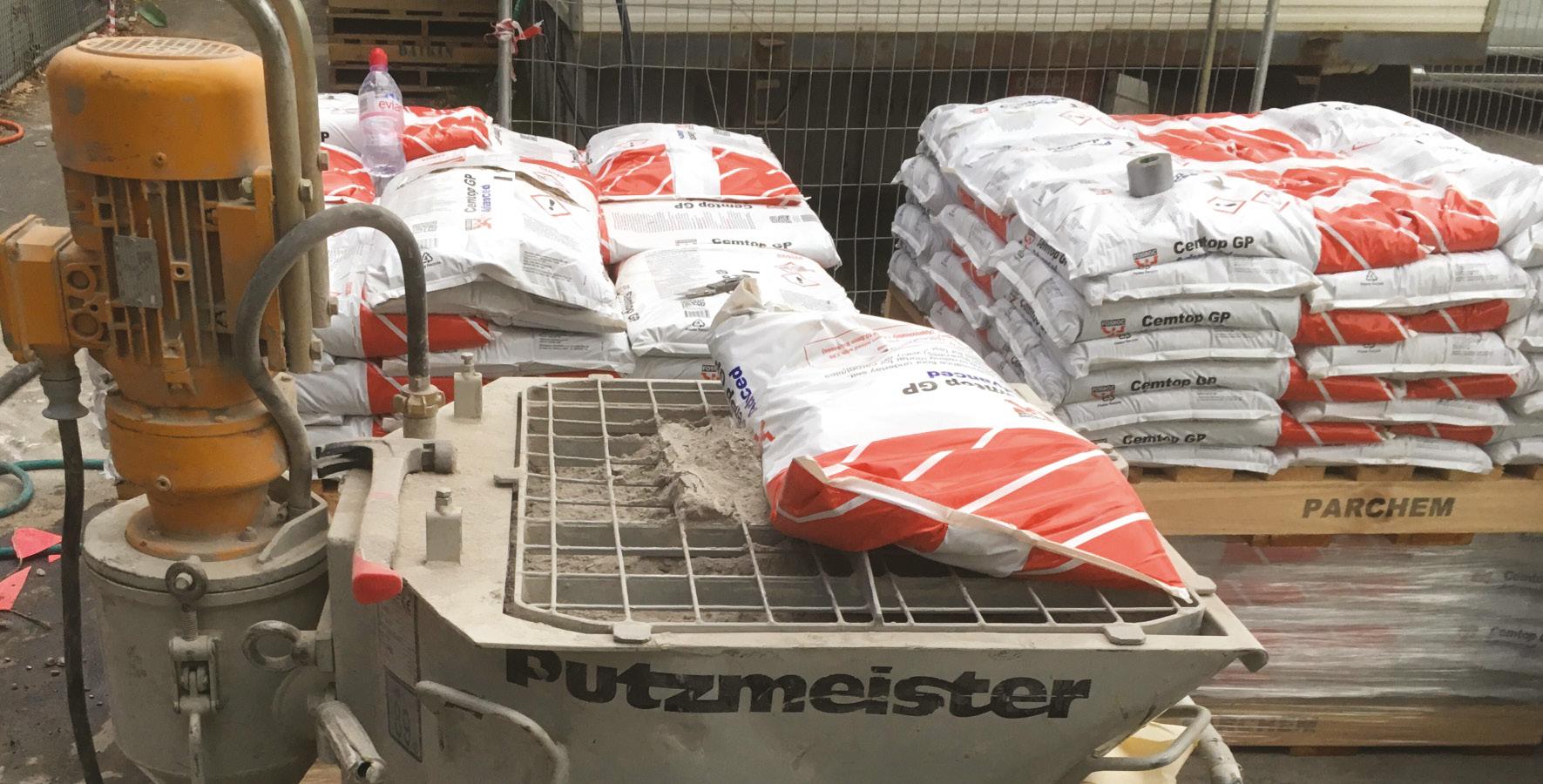
Fosroc's Renderoc, Patchroc, Paveroc, Conbextra and Construction Grout ranges are now classified as RCS hazard free.
Being classified as RCS hazard free means products contain less than 0.1 per cent respirable crystalline silica and are therefore non-hazardous in accordance with the Australian Inventory of Industrial Chemicals.
Vin Brereton, Fosroc ANZ General Manager, said, "Fosroc invested in significant research and development to reduce the level of RCS in our concrete and grouting products – without compromising product performance.
"In saying that, we have always advocated for wearing the correct PPE and this is inherent in our safety documentation and recommendations."
DO CONCRETE MORTARS AND GROUTS CONTAIN RCS?
Yes, silica is still present in cementitious mortars and grouts sold in Australia and New Zealand.
In the case of concrete and grout products that contain RCS, the silica dust can be released into the air during the mixing of dry powders with water. These particles can lodge deep in the lungs and lead to respiratory diseases, including silicosis, lung cancer, and chronic obstructive pulmonary disease (COPD).
While RCS levels in concrete mortars and grouts are much lower than those in engineered stone, mixing cementitious powders with water can release these tiny dust particles into the work environment.
HOW DO I KNOW IF A PRODUCT IS RCS HAZARD FREE?
When purchasing and using cement-based mortars and grouts, Fosroc recommends checking the SDS and product packaging to confirm RCS content. Products sold in Australia
that contain respirable crystalline silica in quantities >0.1 per cent are required by law to include the statement ‘H350 May cause cancer’ on the SDS and packaging.
Unfortunately, products manufactured overseas might not include this warning.
HOW CAN WORKERS BE PROTECTED FROM SILICA DUST?
According to workplace exposure standards set out by Safe Work Australia, workers must not be exposed to levels of silica dust greater than 0.05 mg/m3 over an eight-hour working day, for a five-day working week. Each state and territory is responsible for enforcing this work health and safety law in its jurisdiction.
Safe Work Australia outlines control measures to protect workers from exposure to silica dust, including substituting products with a less hazardous alternative.
Ventilation and personal protective equipment (PPE) are also critical safety measures.
DO I NEED TO WEAR PPE WHEN USING FOSROC MORTARS AND GROUTS?
Yes. While Fosroc's concrete mortars and grouts are classified as RCS hazard free, we always recommend safety precautions to avoid inhaling dust. While mixing cementitious powders, always wear a dust mask and work in well-ventilated areas. Safety directions and PPE requirements are outlined on the SDS for every Fosroc ANZ product.
September 2023 // Issue 28 www.infrastructuremagazine.com.au 30
ASSET MANAGEMENT // SPONSORED EDITORIAL
Fosroc ANZ
for more information, or find out more
and fosroc.co.nz
Check with your
Sales Representative
at fosroc.com.au


SIX STEPS TO CHOOSING THE RIGHT CONSTRUCTION SITE SURVEILLANCE
Construction sites are high-risk workplaces. In addition to risks of on-site injury, managers must be constantly vigilant about protecting a site from theft, vandalism and intruders, and choosing the right security system can mean the difference between being able to deliver a project on time and on budget. Here, we outline the six critical factors construction managers need to consider before selecting a site surveillance solution.
Given how much is at stake for a high-value construction site, choosing the right security system can feel overwhelming. The following questions will help identify the most important considerations when choosing the right security system for a site.
1.
DOES THE SYSTEM NEED GRID POWER?
Many traditional security systems rely on access to grid power, meaning that they are unable to operate in remote or temporary locations. But because grid-powered cameras need to be near a power source, they have limited options for placement around a site and are easily compromised by power interruption. As a result, managers often have no choice but to accept that certain areas of the sites will be unmonitored and vulnerable to theft or vandalism.
In contrast, unwired systems – like those offered by Australian surveillance and security experts Spectur – offer flexible placement around a site. Because these cameras don’t need to be placed near a power connection, they can monitor areas of a site which would be challenging for grid-powered cameras. They can also be moved quickly and easily as construction progresses.
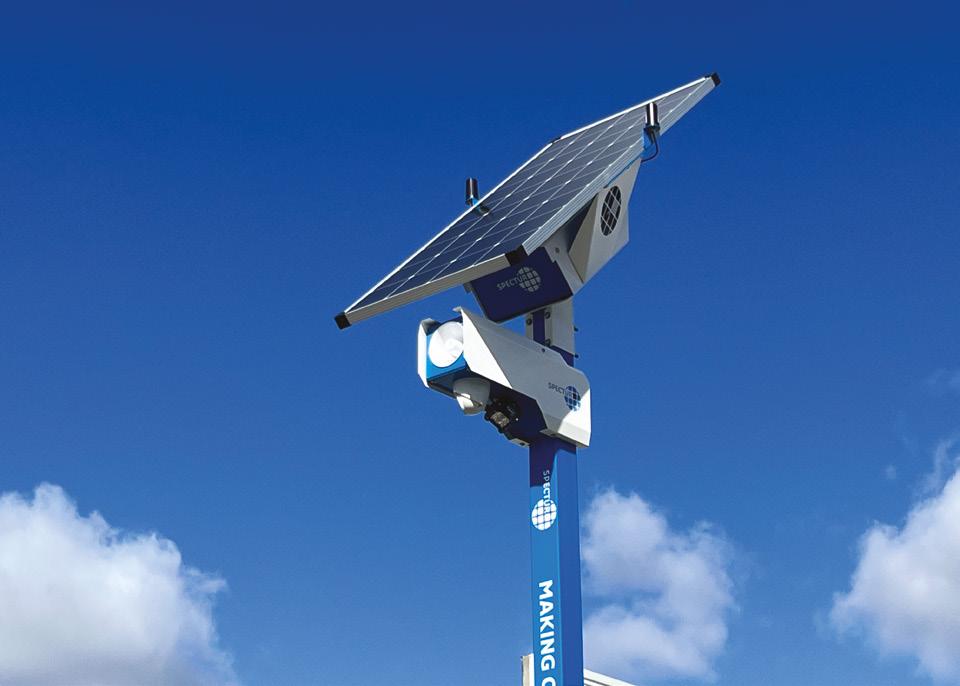
2.
WILL THE SYSTEM ACTIVELY DETER CRIMINALS?
Traditional security systems are reactive in nature, using cameras to simply record security breaches and retroactively provide evidence of the incident. However, an active surveillance system with advanced intelligence can go a step beyond, responding to criminal activity in real-time with deterrence.
Paired with artificial intelligence, edge and cloud computing, Spectur’s security system is able to sense threats, analyse data to assess the situation, and actively deter the threat by responding with an appropriate action, such as triggering an alarm.
3.
HOW DOES THE SYSTEM STORE AND MANAGE DATA?
Surveillance systems typically store captured data through cloud or edge computing. Cloud computing allows data to be shared and remotely accessed; while edge computing stores and processes data locally, allowing for a faster response in real-time applications and reducing the consumption of data transmitted over wireless networks.
Spectur’s systems offer the best of both worlds, combining cloud and edge computing in an optimised form known as fog computing. The system uses edge devices to process and store high volumes of data, and transfer limited, curated information to the cloud for further processing and long-term storage.
4. WHAT ARE THE SET-UP COSTS?
Aside from the costs of a surveillance system, grid-powered cameras often have additional costs of trenching or digging for cable installation. On the other hand, wireless cameras can completely eliminate these costs.
And while 24/7 surveillance of a construction site is ideal, employing an on-site security guard can be prohibitively expensive. For the same cost, a user could have more than 30 independently operating Spectur systems on hire, or they could save even more in the long-term by purchasing outright. Through deterrence and warning systems, including flashing lights, spoken warnings and sounds, Spectur cameras can give the impression that security personnel are on site, even if they are not physically present.
5. WHAT ARE THE OPERATING COSTS?
Spectur’s systems are optimised for low power and data usage, and are designed to maximise the number of devices and computing power each unit can support. One platform can support up to four cameras, offering a 360-degree view of an area in 4K, high definition and thermal images. When fully charged, each station of four cameras can operate for up to five days of fully overcast conditions.
6. DOES THE SUPPLIER OFFER INSTALLATION AND AFTERMARKET SERVICES?
Partnering with a supplier that can offer repair, maintenance and installation services ensures that security systems are working to their fullest potential, providing the highest standard protections for a site. With low-intrusion installation, Spectur offers ongoing services to suit the unique needs of the site, with flexible and customisable services that can adapt to your needs.
32 September 2023 // Issue 28 www.infrastructuremagazine.com.au
AI AND MACHINE LEARNING // SPONSORED EDITORIAL
For more information on using Spectur’s solar-powered camera systems, call 1300 802 960 to find the right solution for your unique onsite challenges.
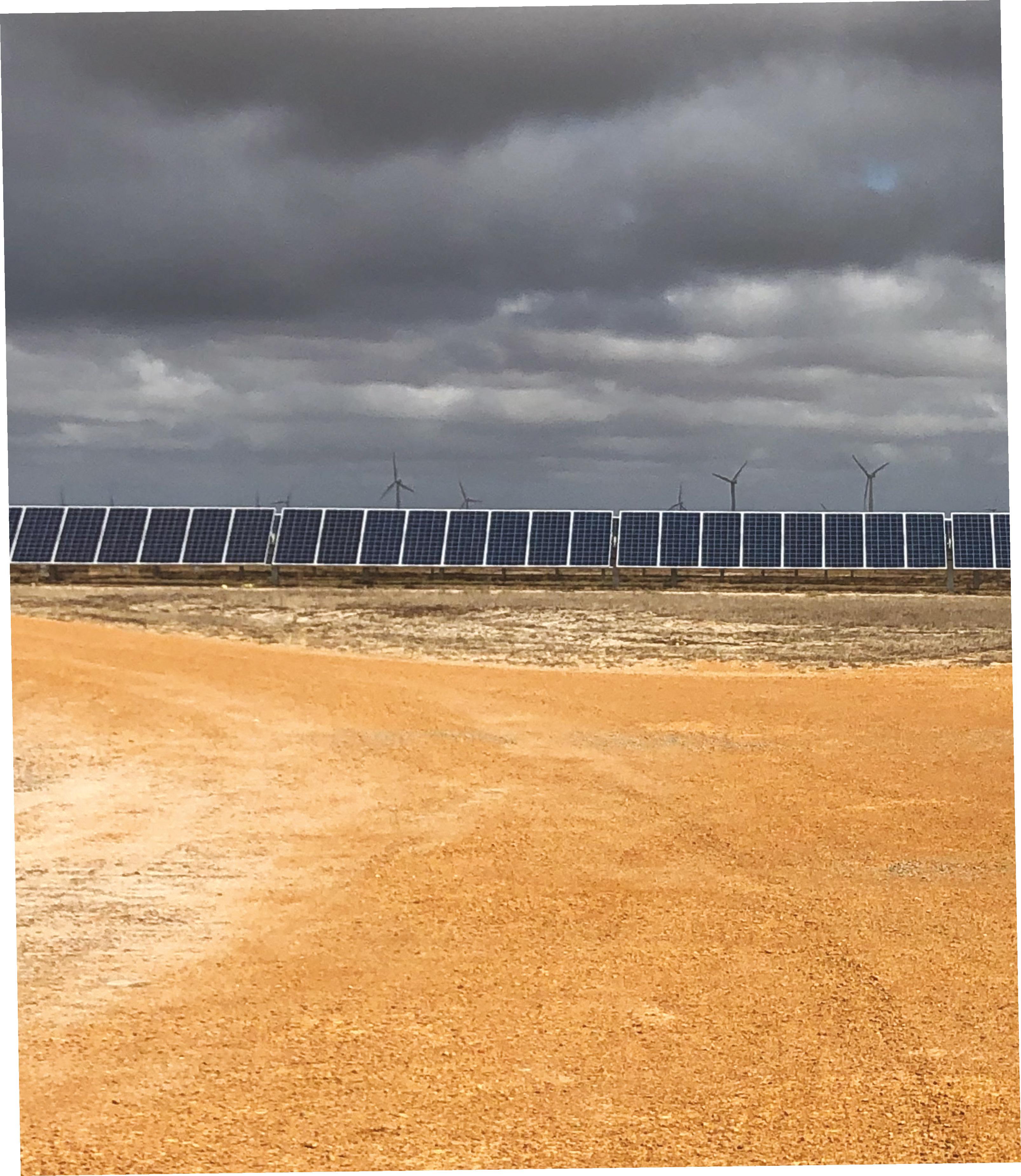
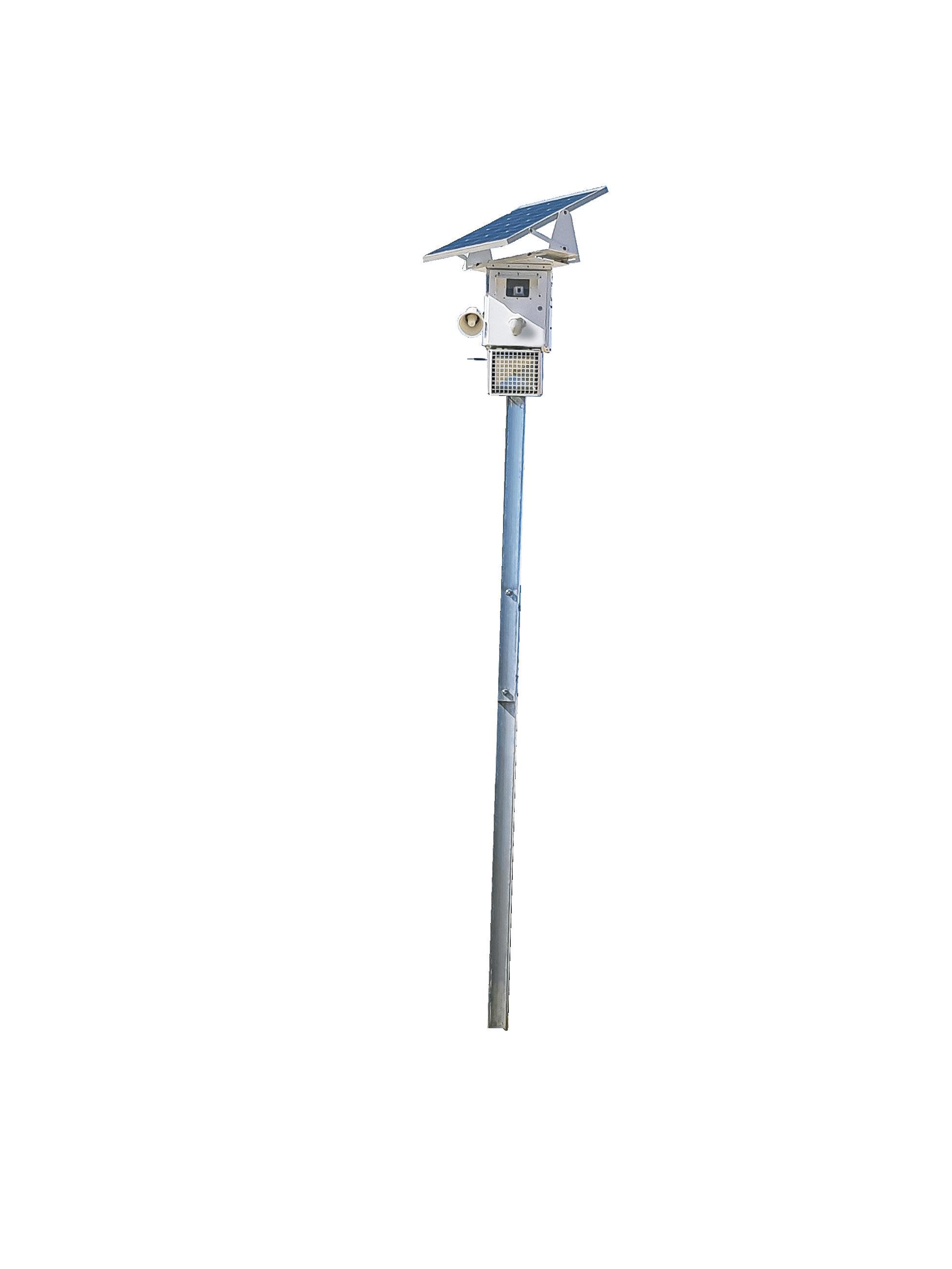
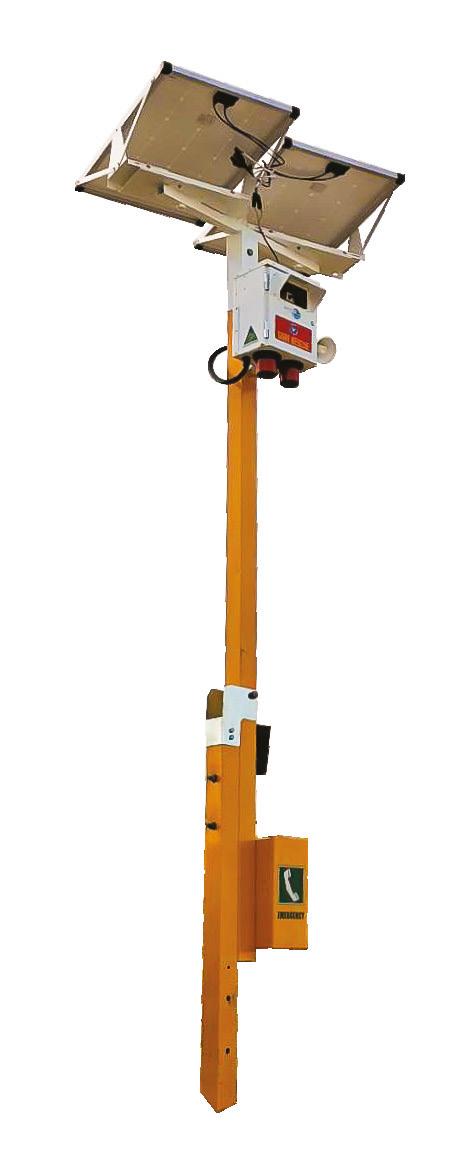

eillance Communications e… he power esources to onomous sensing, hinking and action available nytime... re information 1300 802 960 w.spectur.com.au
By Dr Ehsan Noroozinejad, Senior Research Fellow at Urban Transformations Research Centre (UTRC)

34 September 2023 // Issue 28 www.infrastructuremagazine.com.au
ENHANCING INFRASTRUCTURE MONITORING IN AUSTRALIA: EXPLORING DRONE-BASED AUTONOMOUS INSPECTION USING AI AI AND MACHINE LEARNING
Infrastructure
monitoring is crucial in ensuring critical structures' safety and efficient functioning. This is especially true in Australia, a country known for its diverse and challenging environment, which requires robust monitoring systems to address the unique infrastructure needs of the country.

AI AND MACHINE LEARNING www.infrastructuremagazine.com.au September 2023 // Issue 28 35
In recent years the construction industry has experienced a significant transformation, with advancements in Artificial Intelligence (AI) and Machine Learning (ML) promoting innovation in the sector.

This article will explore the potential of drone-based autonomous inspection and monitoring, empowered by AI, to enhance infrastructure monitoring in Australia.
In recent years, various researchers and civil engineering applications have successfully utilised convolutional neural networks (CNNs) for image classification and object detection. Metal surface defects detection, post-disaster collapse classification, joint damage detection, concrete crack detection, pavement crack detection, and structural damage detection are just a few examples of the wide range of applications.
These studies have demonstrated the effectiveness of CNNs in analysing visual data and extracting meaningful information. Object detection, which involves classifying and localising objects, has also seen significant advancements with the introduction of CNNs.
Traditional methods like the histogram of oriented gradients have been replaced by region-based CNNs (R-CNNs). These methods utilise region proposal functions to localise and segment objects, improving performance and accuracy compared to previous approaches. Faster R-CNN is a notable advancement that further enhances speed and accuracy in object detection.
In the field of civil engineering, region-based CNN methods have been successfully implemented. Studies have used Faster R-CNN to detect structural damage types, including steel delamination, corrosion, and concrete cracks. The efficiency and effectiveness of Faster R-CNN have been demonstrated in various scenarios, such as shield tunnel lining defect detection and concrete defect detection with geolocation.
THE ROLE OF AI AND ML IN THE CONSTRUCTION SECTOR
AI and ML technologies have revolutionised the construction industry, increasing project completion efficiency and safety. Real-time data analysis provided by AI helps in construction
planning, enabling informed decisionmaking and risk mitigation. By optimising processes, reducing errors, and improving project timelines, the integration of AI in construction operations has proven highly beneficial. One emerging field – robotics construction – leverages AI to enhance productivity and safety by deploying autonomous construction vehicles and robotic systems capable of performing complex tasks with precision.
AUTONOMOUS MONITORING OF INFRASTRUCTURE
An area where AI has made remarkable strides is in the autonomous monitoring of infrastructure. Traditional inspection and monitoring methods are often time-consuming, expensive, and pose risks to personnel.
However, the utilisation of drones equipped with sophisticated sensors and AI algorithms presents a
revolutionary solution. In Australia, with its vast landscapes and remote areas, drone-based autonomous inspection and monitoring systems offer an efficient and cost-effective approach to infrastructure management.
ADVANTAGES OF DRONE-BASED AUTONOMOUS INSPECTION AND MONITORING
Drone-based inspection and monitoring systems powered by AI bring numerous advantages to infrastructure management in Australia. Drones possess the capability to access hard-to-reach areas, such as bridges, pipelines, and power transmission lines, without compromising the safety of human inspectors.
Equipped with high-resolution cameras and LiDAR sensors, drones capture accurate and detailed data, which is then analysed using AI algorithms. This data enables the
36 September 2023 // Issue 28 www.infrastructuremagazine.com.au AI AND MACHINE LEARNING
identification of potential structural issues, such as cracks, corrosion, or deformations, with greater accuracy and efficiency.
Moreover, drones facilitate rapid data collection over large areas, reducing the time required for comprehensive inspections. Real-time data processing provides timely insights, enabling proactive maintenance and repair strategies.
By integrating ML algorithms, the system can learn from past inspections, enhancing its ability to identify anomalies and predict maintenance needs, ultimately leading to more efficient infrastructure management.
AI AND CARBON NEUTRALITY: ACCELERATING DECARBONISATION EFFORTS
AI-powered drone-based autonomous inspection and monitoring systems have the potential to accelerate
decarbonisation in Australia's built environment.
Energy inefficiencies can be identified and retrofitted by leveraging thermal imaging and AI algorithms to reduce emissions. Drones can also assess the suitability of renewable energy infrastructure and optimise construction processes to minimise waste and energy consumption—AI’s ability to analyse data on materials' environmental impact aids in selecting sustainable options. Additionally, drones can monitor green infrastructure and provide real-time emission monitoring, supporting the transition to a carbon-neutral future. Integrating AI into infrastructure monitoring empowers evidence-based decision-making and drives the adoption of sustainable practices.
Australia can leverage AI technologies to enhance infrastructure monitoring while advancing its carbon neutrality goals.
CIRCULAR ECONOMY AND AI-ENABLED DESIGN PROCESSES
Australia's commitment to a circular economy, aimed at eliminating waste and promoting sustainable resource use, aligns perfectly with the integration of AI in infrastructure monitoring. AI can accelerate the development of circular economy principles by enhancing the design and development of products, components, and materials.
Through iterative machine-learningassisted design processes, AI enables rapid prototyping and testing, facilitating the creation of environmentally friendly and economically viable infrastructure solutions.
WHAT DOES THE FUTURE HOLD?
Drone-based autonomous inspection and monitoring systems, bolstered by AI, hold immense promise for enhancing infrastructure monitoring in Australia.
By harnessing the power of AI and ML, Australia can benefit from efficient and cost-effective monitoring of critical structures. These technologies offer timely and accurate data, enabling proactive maintenance strategies and supporting the country's commitment to a circular economy.
As Australia prioritises the safety and sustainability of its infrastructure, embracing the potential of AI-driven monitoring systems is a crucial step towards building a resilient and futureready environment.

While ANN-based classification has shown reasonable accuracy in civil engineering applications, more training data is needed. Proper pre-processing of training data is crucial to identify localised damage accurately. Images often contain multiple damage states, and it is essential to pre-process the data to differentiate between damaged and undamaged areas effectively.
In conclusion, AI and ML technologies have proven to be powerful tools in civil and infrastructure engineering, enabling accurate image classification and object detection. Integrating these technologies with drone-based autonomous inspection and monitoring offers tremendous potential for enhancing infrastructure monitoring in Australia.
By harnessing the capabilities of CNNs and advanced AI algorithms, Australia can achieve more efficient and costeffective infrastructure management, ensuring the safety and longevity of critical structures.
AI AND MACHINE LEARNING www.infrastructuremagazine.com.au September 2023 // Issue 28 37
MAKING THE SWITCH TO CLOUD-BASED GEOTECHNICAL INFORMATION MANAGEMENT
Across the globe, every industry is grappling with how to best redefine data use and storage – and geotechnical engineering is no exception.
Data volumes are exploding, flexible and remote working is on the rise, compliance requirements are mounting, and clients expect more value on a tighter turnaround.
HOW CAN YOU BETTER CONNECT YOUR TEAMS WITH DATA TO ENABLE FASTER DECISION-MAKING?
A move to the cloud is the next step, but finding the right partner, updating processes and systems – and training a team – can seem like a daunting task.
Anton Wu, OpenGround Solution Specialist, Technology Cloud Engineering, Seequent, said,“When you’re making the switch to a cloud-based geotechnical information management solution OpenGround can help.”
Mr Wu has over seven years of geotechnical engineering experience across major local and international transport infrastructure projects, and understands that having the right tool for the job is crucial.
THE POWER OF OPENGROUND
Seequent’s secure, scalable, cloud-based OpenGround software brings together every stage of the information gathering process in one connected data environment.
It’s the next generation of data management solutions to help geotechnical teams effectively collect, report, manage, visualise and analyse data.
“A typical day for a geotechnical engineer could be out in the field collecting data, drilling holes or performing analysis on the data,” Mr Wu said.
“Typically, data is collected using the traditional pen and paper approach, digitised onto an offline desktop application and then transferred to a preferred analysis tool.
“This not only introduces the issue of double-handling information and human error but, with more engineers working remotely, the data they’re working on needs to be live, accessible and accurate at all times.
“When you manage your data using OpenGround, it removes many friction points from your geotechnical workflow. And helps address many of the logistical problems that geotechnical engineers are all too familiar with, enabling engineers to focus on their engineering.”
OPENGROUND IN ACTION
Creating a one-stop shop for their geotechnical data has helped CMW Geosciences’ improve analysis, be more competitive, and increase value.
The specialist geotechnical consultancy serves global clients across the mining, construction, and civil engineering industries, working from offices in Australia and New Zealand.
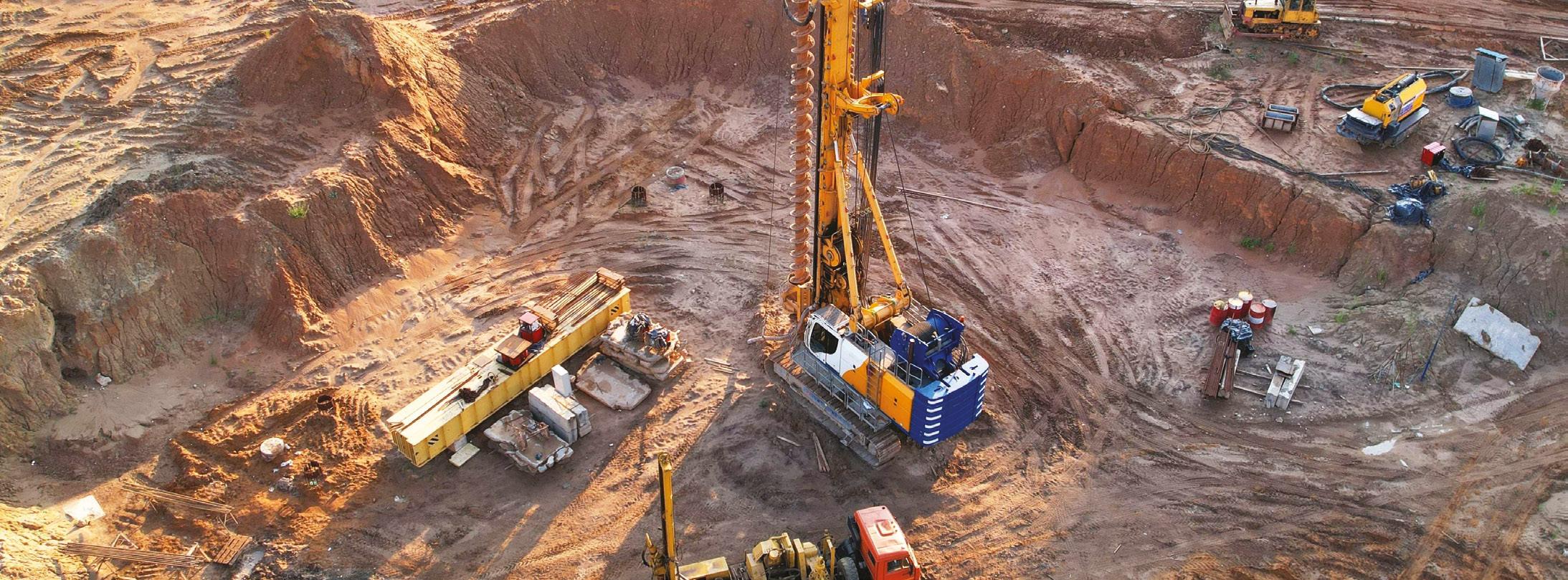
Fast, organic growth meant they were unable to easily replicate services across multiple offices. Many activities were performed manually, often leading to repetition or delays, and making the team vulnerable to error. Server failures or fires were among other potential risks flagged.
CMW decided to completely transition to OpenGround. By 2022 they had 68,000 boreholes and 671,000m of drill logs all held centrally in the cloud, and their teams are now more connected and can seamlessly collaborate with their securelystored data.
“When you equip yourself with the right tools to make the necessary move to the cloud, you’ll be in an excellent competitive position going forward,” Mr Wu said.
With OpenGround, GeoStudio and PLAXIS, Seequent offers a world-leading suite of geotechnical analysis and information management solutions.
38 September 2023 // Issue 28 www.infrastructuremagazine.com.au
Finding better ways to efficiently manage subsurface data should be high on the to-do list for most geotechnical engineering companies. But why?
AI AND MACHINE LEARNING // SPONSORED EDITORIAL
Over 3 million boreholes are already managed in OpenGround. Ready to make your move? Find out more by visiting seequent.com/groundtocloud
Make borehole log production seamless
OpenGround is the cloud evolution of gINT, designed to replace clunky and error-prone manual processes to make site investigation more efficient and accurate.
OpenGround is a secure, cloud-based geotechnical information management (GIM) platform for collecting, reporting, managing, visualising, analysing, and accessing geotechnical data.

Seequent, The Bentley Subsurface Company seequent.com Download eBook
AI IN THE INFRASTRUCTURE SECTOR: WHAT DOES THE FUTURE HOLD?
By Stephanie Nestor, Assistant Editor, Infrastructure Magazine
Around the globe many industries are already making use of artificial intelligence (AI) systems to automate operations. As this technology develops, there are plenty of opportunities for the construction, utility and transport sectors to save time, money and manpower. So what can AI offer the infrastructure sector?
Artificial intelligence (AI) technology is becoming widely adopted in a range of sectors as a tool to automate processes and services. In the infrastructure sector, AI systems are already being used for maintenance, security and unmanned operations.
AI is the ability of computers to replicate human thought by analysing data, making decisions and improving capabilities through experience. Creating an AI system involves machine learning, where AI utilises algorithms to identify patterns and gain insights from data, then uses that information to predict outcomes.

AI technology promises to help make better informed decisions faster, to improve planning, resource allocation, security, customer service and more, but AI is still an everevolving technology.
Despite its potential, there are still plenty of risks and concerns alongside its capabilities. As the technology develops and becomes more regulated, what role will AI play in the infrastructure sector’s future?
NEW TOOLS TO PLAY WITH
Businesses and organisations in the infrastructure sector are already experimenting with, and integrating, AI systems into their daily operations. Whether it is enhancing surveillance, generating content or assessing data, there are plenty of opportunities to use the technology.
For many sectors, language tools like ChatGPT can assist daily operations and decision-making by collecting and analysing vast amounts of data, generating copy, searching the internet, writing code, summarising information and more.
However, for the infrastructure sector, the most common application for AI is what is known as computer vision, where an AI system is combined with imagery or video – such as drones, cameras or sensors – to identify objects, collect information and respond to stimuli.
These systems are already in place across different sites and projects.
40 September 2023 // Issue 28 www.infrastructuremagazine.com.au
AI AND MACHINE LEARNING
For example, over 2,400 sensors have been deployed on the Sydney Harbour Bridge to monitor cracks and identify their causes – including vibrations, temperature or the weather. Additionally, Brisbane and Botany Bay Ports have incorporated automated straddle carriers to move containers onto the back of trucks, without endangering any workers in the process.
While this is only the beginning for AI technology in infrastructure, there are plenty of possibilities for the future.
ASSISTING THE CONSTRUCTION INDUSTRY
AI can be incorporated into almost every phase of the construction process, from design to operation. AI tools can ensure knowledge is always current and up-to-date, even alerting developers with the latest information on products, features and regulations.

With its predictive capabilities, AI can assist during the bidding process by evaluating bidding documents, predicting the price of raw materials, analysing previous projects to ensure the contract is awarded to the right company, and ensure accurate estimates for budgets and timelines.
Once a project reaches the operation and maintenance phase, ensuring safety and efficiency is crucial. When utilised alongside cameras or sensors, AI can help with monitoring for performance issues, safety concerns or sudden faults – to prevent problems from getting out of hand on a project.
IMPROVING SAFETY IN TRANSPORTATION
Implementing AI into transportation has the potential to improve safety, efficiency and maintenance. While self-driving vehicles are decades away, in the immediate future, AI can identify threats on the road and prevent accidents, keeping freight drivers and public transport passengers safe.
For freight and logistics, insights from data collected by AI systems can improve the frequency and efficiency of goods transported by vehicles – with a better understanding of weather and road conditions, drivers will know the best route to avoid delays.
Additionally, with AI systems monitoring the integrity of trucks, it can encourage predictive maintenance to ensure issues are caught before a vehicle is forced to be taken off the road and potentially cause further damage.
AI AND MACHINE LEARNING www.infrastructuremagazine.com.au September 2023 // Issue 28 41
ENHANCING CUSTOMER SERVICE AT AIRPORTS
For airports, this technology can greatly benefit customer service. With better insights into weather conditions and equipment functionality, unexpected delays caused by storms or technical faults can be minimised by updating passengers sooner rather than later.
With more automated processes from check-in to boarding, this will help reduce overall waiting times for passengers, taking the weight off airport staff to deal with long queues and unexpected issues.
Additionally, when paired with video monitoring, AI can detect threats, such as intruders or weapons, and respond accordingly in real-time. For a human, it can be hard to discern a potentially dangerous individual in a huge crowd, but for AI, it is possible to scan crowds and make decisions in mere seconds.
OPTIMISING PORT OPERATIONS
AI is already being used in port management systems to automate cranes and container trucks. With the evolution of AI technology, more ports around Australia will adopt smart systems to optimise daily operations.
AI’s predictive capabilities can deliver better weather forecasts and estimated departure and arrival times. Even in terms of maintenance, AI can be used alongside a digital twin to regularly monitor port infrastructure and keep on top of maintenance.
MAINTAINING RELIABLE UTILITIES
For utilities, AI has the potential to improve customer experience and asset management for energy and water providers. AI can be used to personalise customer service to understand how individual households and businesses use their energy and water, with algorithms to track monthly smart meter readings.
With accurate data, AI can assist with regulatory compliance to ensure providers are keeping on top of requirements by alerting them to possible faulty equipment, accidents or unplanned outages.
Particularly for underground assets, it can be difficult to monitor deterioration or faults given the difficulty and costs associated with reaching those assets. Predictive maintenance using AI means utilities can save costs in the long-run by taking proactive measures to prevent damage.
BUILDING BETTER CITIES
With data collection and pattern recognition, AI can help urban planners design public spaces and buildings that are data-driven and meet the needs of communities.
Urban planners often have to handle large amounts of data and take into consideration the various needs of communities and industries, from transportation and traffic, to entertainment and recreation.
AI has the ability to process and analyse enormous amounts of data to find the optimal solution for designing public spaces and centres. It can also determine the best routes for traffic management, implement sustainable strategies, utilise smart utilities and create responsive environments.

Also, with predictive analysis, cities can be planned to account for population growth trends, environmental changes and changing infrastructure right from the beginning.
NAVIGATING THE RISKS
As a continually-developing technology, there are inevitably risks and concerns associated with using AI. The ones that could affect the infrastructure sector include physical safety, privacy, financial performance, security and costs.
According to the Equinix 2023 Global Tech Trends Survey, 42 per cent of IT leaders around the world are reluctant to integrate AI technology1. This independent study surveyed almost 3,000 IT specialists around the world and found that
1 “Equinix 2023 Global Tech Trends Survey”. Equinix. 2023. https://www.equinix.com.au/resources/infopapers/equinix-tech-trends-survey?ls=Public%2520Relation s&lsd=23q2__digital-infrastructure--_/resources/infopapers/equinix-tech-trends-survey/_pr-equinix_pr-newswire_press-release__us-en_AMER_global-tech-trendssurvey_awareness&utm_campaign=us-en__press-release_global-tech-trends-survey_pr-equinix&utm_source=&utm_medium=press-release&utm_content=digitalinfrastructure
42
AI AND MACHINE LEARNING
many were not ready to adopt AI solutions because of a lack of necessary infrastructure, training, regulations and costs. In Australia, there is a little more optimism with 35 per cent of IT leaders feeling unprepared to introduce AI systems2.
Implementing AI systems is not cheap, with digital systems often requiring considerable costs for businesses that only become more expensive with large infrastructure sites and projects. Incorporating this new technology into construction, utilities, and more, will require upgrading old systems, which limits the feasibility of delivering AI solutions across industries.
Additionally, an overreliance on AI can lead to injury or harm as it is not at the stage where it can respond appropriately to all new stimuli. A wrong judgement from an AI system could injure a worker, miss signs of faulty equipment or put the public at risk, which is why it is important for humans to monitor these systems.
Particularly for transportation and using heavy machinery, accidents are still likely to happen, – with or without AI systems – due to the danger that comes with using heavy vehicles and equipment.
Incorporating AI systems into an already precarious environment will require skill training and rigorous risk assessment to prevent accidents from happening.
KEEPING DATA SECURE
Privacy is another big concern as AI must be trained on data, which may not always be publicly available or legal to use.
If a customer’s private information is used to train AI systems without consent, organisations can be found liable in court of breaching privacy laws. But for organisations and businesses using their own data, there is always the risk that this information is not securely stored when incorporated with AI systems.
While AI can help make data-driven decisions, they are not guaranteed to be the best decisions. If data collected by AI systems is not current or accurate, this can lead to poor decision-making and potential financial losses.
Additionally, many organisations are involved with government agencies to oversee significant infrastructure projects. If data is compromised, or the wrong person utilises AI systems, that could possibly threaten national security.

THE THREAT OF AUTOMATION
While costs, security and safety are key concerns for the infrastructure sector, the main concern for all industries when it comes to AI is the loss of jobs to automation.
Fortunately for the infrastructure sector, AI is not much of a threat to jobs, as most positions cannot be completed with AI alone.
Goldman Sachs released a report that predicts generative AI has the potential to automate over 300 million jobs in Europe and the US3
While legal, IT, administration, marketing, architecture and other similar jobs are expected to be automated, jobs in the infrastructure sector are mostly safe, with jobs in maintenance, utilities, agriculture, mining and manufacturing to be the least impacted.
NEW FUTURE OF POSSIBILITY
Encouraging different employment opportunities and skillbuilding will ensure workers are not replaced but assisted by AI systems. In fact, there will be more opportunities in the future for AI specialists who can set up and manage systems.
AI is still in its infancy, but in the next few years and decades, AI will become incorporated into more processes and operations in the infrastructure sector.
Ensuring AI is a tool that can be used effectively and safely, without replacing workers, will require more development, experimentation, regulation and investment.
The future – and the potential of AI – is just around the corner.
2 https://www.equinix.com.au/newsroom/press-releases/2023/06/thirty-five-per-cent-of-australian-it-leaders-doubt-digital-infrastructure-s-ai-readiness
3 “The Potentially Large Effects of Artificial Intelligence on Economic Growth”. Joseph Briggs, Devesh Kodnani, et al. Goldman Sachs Economics Research. March 2023. https://www.key4biz.it/wp-content/uploads/2023/03/Global-Economics-Analyst_-The-Potentially-Large-Effects-of-Artificial-Intelligence-on-EconomicGrowth-Briggs_Kodnani.pdf
AI AND MACHINE LEARNING 43
LOOKING DEE PER: SOLVING THE PROBLEM OF UNDERGROUND UTILITY RISK
When construction or new asset installation impacts underground utilities such as gas, water or power mains, the consequences can be expensive, and even deadly.
According to Reveal, utility strikes cost New Zealand $89 million annually in direct costs and $2.5 billion per year in indirect costs – a staggering 1.17 per cent of GDP.
Reveal CEO and Founder, Sam Wiffen, said Reveal provides a solution to what has been a long-standing issue across the construction and infrastructure sectors.
“I have an engineering background and used to work on large upgrades of buildings and electrical substations across the civil construction and heavy electrical sectors. We kept on hitting objects underground, primarily because we didn’t have accurate information and records on what was underground,” Mr Wiffen said.
Reveal started as a traditional ‘boots on the ground’ utility locating services business, but Mr Wiffen was eager to build a foundation of technology and innovation in an industry notorious for being slow to modernise.

“Locating underground utilities is really hard. Our thinking was, ‘How do we make that job easier?’ When you think about Superman, having x-ray vision, that would be amazing. But what if everyone was Superman or Superwoman?”
Existing geophysical tools can provide insights into the hidden environment
of the subsurface and indicate the presence or absence of underground utilities. But historically, this information has been difficult to visualise or make accessible to non-specialists.
“If we could ensure that contractors and project owners could accurately and easily implement subsurface data, we could reap huge efficiency gains at every stage of the project lifecycle, from the concept and design phase through to construction,” Mr Wiffen said.
A DIGITAL UNDERSTANDING OF THE UNDERGROUND
The Reveal platform combines the best-practice utility locating standards in an intuitive cloud-based collection of tools that allow engineers, contractors and asset managers to understand the risks of a given project site, and make informed decisions.
The platform collates all existing information about the underground; utility plans, geophysical detection data, observation and aerial data, and photographic evidence from 360-degree cameras, Lidar and photogrammetry tools.
The platform allows users to create a Unified Utility Model that synthesises all these data sources and produces the most accurate picture of the subsurface infrastructure, with associated risk scores and quality levels clearly indicated.
“We’re helping people to not just take the existing records of utilities and combine those before making a design, we’re providing an understanding through a subsurface utility engineering
process to identify where these risks lie,” Mr Wiffen said.
Reveal’s platform has already been utilised on crucial works during the Christchurch earthquake rebuild, as well as infrastructure works such as the Let’s Get Wellington Moving transport project and Riverlink urban revitalisation project in Lower Hutt.
STRENGTH IN DIVERSITY
Reveal’s development and services are backed by a diverse team originating from a wide range of industries. Mr Wiffen said this diversity has greatly supported both idea generation and innovation throughout the company.
“We’ve got people who are masters of their craft, people that are geophysicists, geologists, engineers, technologists, project managers, accountants, economists, you name it, all working side-by-side.
“Everyone is treated as an equal and this culture has been huge for us. What’s been really special to me is that as the company has grown, it’s given us more resources to invest back into our staff through different training and development programs.”
Reveal recently celebrated its eleventh anniversary, and is beginning to push further into international markets, with key customers secured in Australia and Singapore, and a partnership agreement with a major US construction insurer.
44 September 2023 // Issue 28 www.infrastructuremagazine.com.au
A New Zealand-based utility locating company is breaking new ground in the visualisation of underground utility risks.
AI AND MACHINE LEARNING // SPONSORED EDITORIAL To find out more, go to https://www.reveal.nz
REVEAL
ARE AUSTRALASIA’S INNOVATIVE SUBSURFACE EXPERTS.
With Reveal, you can eliminate subsurface risks, deliver infrastructure projects faster and minimise cost blow-outs and variations.

If you need to understand your underground, get in touch with the world’s leading subsurface experts.
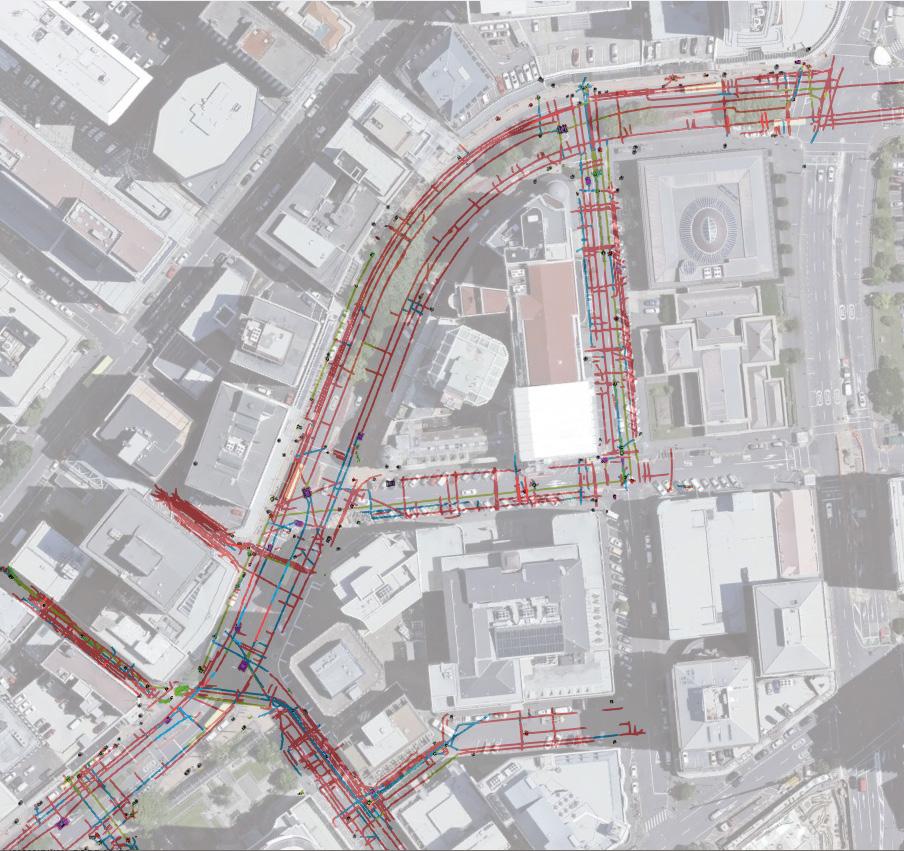
WWW.REVEAL.NZ
DRIVING AUSTRALIA’S TRANSPORT SECTOR WITH ITS

 By Tess Macallan, Journalist, Infrastructure Magazine
By Tess Macallan, Journalist, Infrastructure Magazine
Digital innovations in transport and freight can increase efficiency, reduce costs and create new job opportunities. In Australia, however, the transport sector is lagging behind other OECD countries when it comes to digitalisation and automation trends. A recent report by Swinburne University of Technology, funded by the iMOVE Cooperative Research Centre and the Department of Infrastructure, Transport, Regional Development, Communications and the Arts, sheds light on the challenges and opportunities that lay ahead in adapting to this ever-evolving landscape.
46 INTELLIGENT TRANSPORT SYSTEMS (ITS)
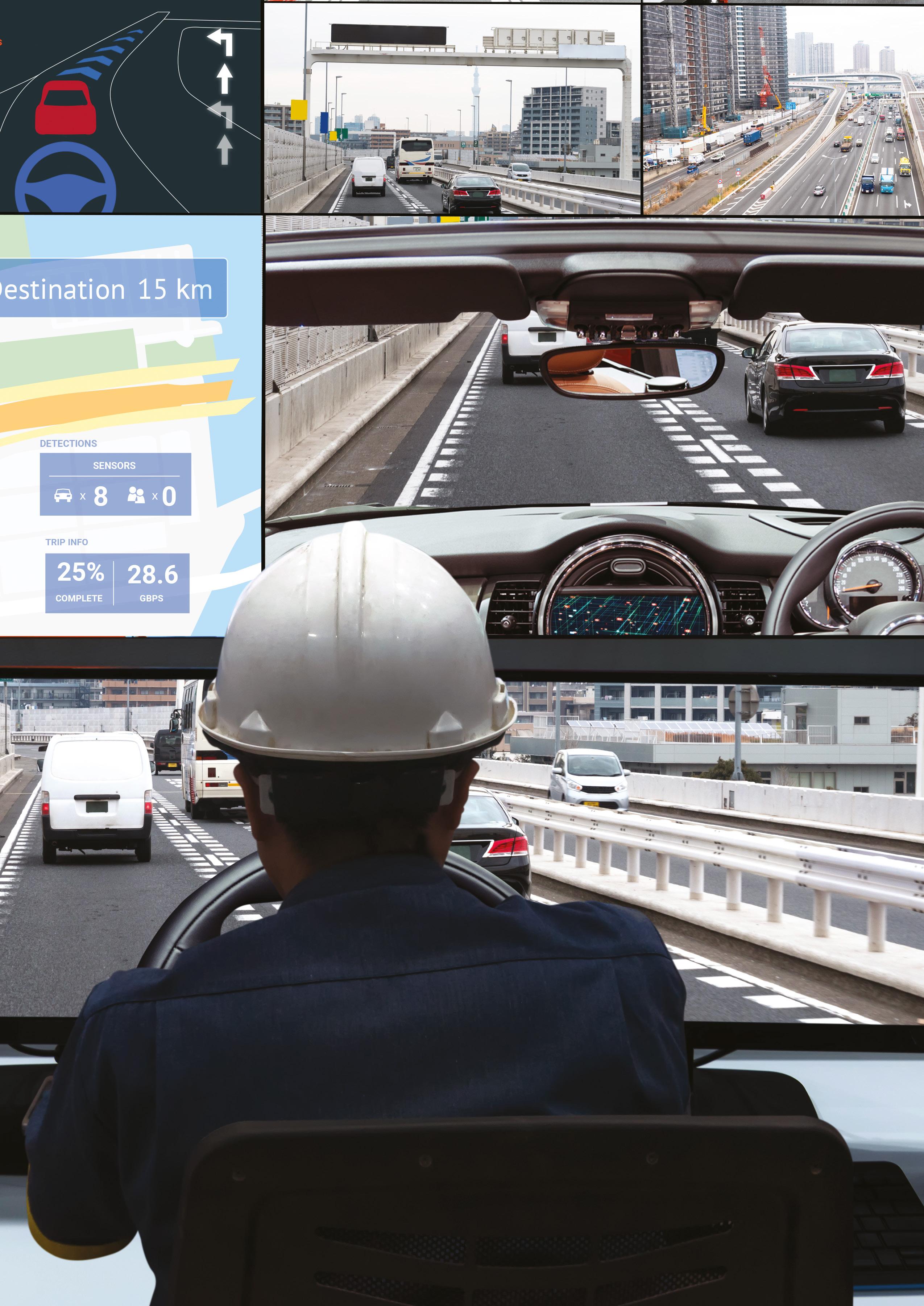
47 INTELLIGENT TRANSPORT SYSTEMS (ITS)
Once a concept confined to science fiction movies, robo-taxis are currently being trialled in cities across the world. These autonomous ride-sharing vehicles are just one example of the way the transport sector is rapidly evolving, offering new opportunities for performance improvement whilst also creating concerns surrounding the implications of digital innovations.
This year, Swinburne University published Creating our future transport and mobility workforce: understanding the workforce implications of transport digitalisation and automation in Australia, outlining how Australia can take advantage of technology solutions to enhance efficiency in this vital sector of the economy.
Professor of Future Urban Mobility at Swinburne University of Technology and co-author of the report, Hussein Dia, said there are numerous opportunities for digitisation and automation in the transport sector in Australia.
Mr Dia said these solutions include advancements in connected and automated vehicles, warehouse digitalisation and automation, vehicle electrification, and not only electric private vehicles, but also electrification of freight vehicles, internet of things, mobile and cloud computing, the technologies for sharing economies and mobility as a service.
“Most importantly, the biggest opportunities are appearing in artificial intelligence solutions.”
Mr Dia said while all these technologies hold individual importance, “there will come a point in time when their influences are going to converge and this is when we see that they will provide a lot of value.”
THE AGE OF AUTOMATION
Technologies such as navigation apps, ride-sharing services and real-time public transport schedules currently provide significant benefits to people’s lives.
The prospect of autonomous vehicles fuels expectations that the transport system will evolve to offer safe, more sustainable and convenient travel options.
“People are already expecting higher standards of the transport system,” Mr Dia said.
“These technologies are going to provide opportunities to reduce the cost of travel, especially in the future when we have autonomous vehicles like robo-taxis.
“Once you remove the driver from the equation, the cost of transport is going to be much cheaper.”
Mr Dia said people might not want to own cars anymore as they can meet their travel needs using shared vehicles.
“I would say maybe in 10 to 15 years we are going to start to see more automation in not only taxis, but also the bigger opportunity is in freight and autonomous tracking.”
In the trucking industry, autonomous vehicles will provide the solution for keeping freight on schedule. It will solve some of the issues associated with human operation, making it safer and more affordable. The same benefits will apply to other professional driving jobs.
“Another opportunity is automated buses, because these operate on single lanes or lines that are much easier to map out,” Mr Dia said.
“As for private vehicles that are expected to go anywhere at any time, under all weather conditions, we are not there yet.”
LABOUR MARKET DISRUPTION
As with any automation of roles once completed by humans, there are bound to be impacts on employment. Job loss due to autonomous vehicles remains subject to debate, but the Swinburne report found that it is very likely in the near future the market will favour an increase in skilled jobs and a decrease in unskilled or low-skilled jobs.
“Technology is definitely going to impact jobs and the work we’ve done, we found that it will particularly impact truck drivers at first and taxi drivers later on,” Mr Dia said.
“At the same time, it’ll open up new opportunities. Technology will not eliminate work. There's still going to be work that needs to be done. And we need to start now to think about how we transition those impacted jobs to higher quality and higher paying jobs.”
The Swinburne report found that new technologies can create new jobs, improve the quality of existing jobs, and bring previously underrepresented groups into the labour market.
Low-skilled jobs are more at risk of automation, but lowquality jobs such as mileage-based driving jobs could be improved and replaced by higher quality and skilled jobs. These would include more non-driving tasks, such as maintenance, safety control, inspection, which offer a safer and healthier work environment.
Before fully-automated driving becomes a reality, automation supervision and safety-driver roles will be crucial. Remote management roles will bring drivers into control rooms and require new skills of working with automation.
In the future, autonomous on-demand fleet operators could hire licensed and experienced truck drivers to monitor and control AV trucks remotely to travel through construction sites, or areas where the self-driving software may not be able to navigate the road network.
“Our research found that actually the transition could improve the quality of life for those impacted positions because it means better job opportunities, better paying jobs and also more flexibility,” Mr Dia said.
“With the right set of strategies and policy settings and interventions, once we have committed leadership partnerships between industry, government and education institutions providing incentives, these impacts can be managed, but we need to be quick and start early in order to realise the benefits.”
PREPARING THE WORKFORCE
As some roles disappear, there will also be opportunities to upskill workers with jobs relating to technology. A variety of skill sets are needed for automated vehicles, including IT, cybersecurity, civil engineering, mechanical engineering, and transport system design.
“The key skills that are expected to be in high demand include knowledge of autonomous robots,” Mr Dia said.
“This not only applies to autonomous vehicles, but also if we look at the freight and logistics industry, this is automation of warehouses and automation of other activities, simulation tools, digital twins and internet of things, solutions and architects.”
Cybersecurity will continue to be important, and artificial intelligence will have the greatest impact, explains Mr Dia.
As part of the study, Mr Dia said he and his colleagues conducted industry stakeholder consultations.
September 2023 // Issue 28 www.infrastructuremagazine.com.au 48 INTELLIGENT TRANSPORT SYSTEMS (ITS)
“They communicated the importance of soft skills. So that could accompany the digital skills, things like critical thinking, communication and complex problem solving.”
In order to support these new technologies and the workforce, education pathways may need adjusting, with more on the job training required.
“Some of these areas, particularly if you’re talking about warehouse automation, you might not need a degree from a university, probably you might need a TAFE qualification, but employers keep saying that what would be more beneficial is on the job training. So there could be opportunities to do more of that.
“Micro-credentials are also becoming quite important. Instead of asking someone to come and spend a full year to do a degree, for example, they can do the micro-credentials at their own convenience. They would do four of them to get a certain qualification. Part of it could be online in addition to face-to-face and on the job training.”
A NEED FOR LEADERSHIP
For the transport sector to move forward successfully, governments will likely have to intervene by developing new policy and collaborating with industry stakeholders.
“I think the first important policy change is to develop a national vision for intelligent transport systems,” Mr Dia said.
“Through the consultations we’ve done, the consensus was that Australia has a leadership vacuum at the national level. This needs to change.
“We also need national commitment to occupational digital literacy and national standards in place for industry specific digital upskilling programs.”
The Swinburne report found there are opportunities to invite the private sector to be involved in the development of the training programs, because they know where training is required.
“A partnership between universities, the Commonwealth, State Governments and the private sector to come up with targeted digital innovations training programs would be highly beneficial.
“In other countries, policies that provide incentives for private investments in digital skills have worked well.
“For a lot of companies, sending someone away for half a year to get a qualification will impact their bottom line. Many countries are providing incentives or tax credits for work-based learning programs and encouraging the industry to also look at next generation training models for their transport workforce.”
CHARTING THE PATH AHEAD
Intelligent transport systems are becoming an increasingly important area for governments, but Mr Dia said it hasn't been elevated high enough on the national agenda yet.
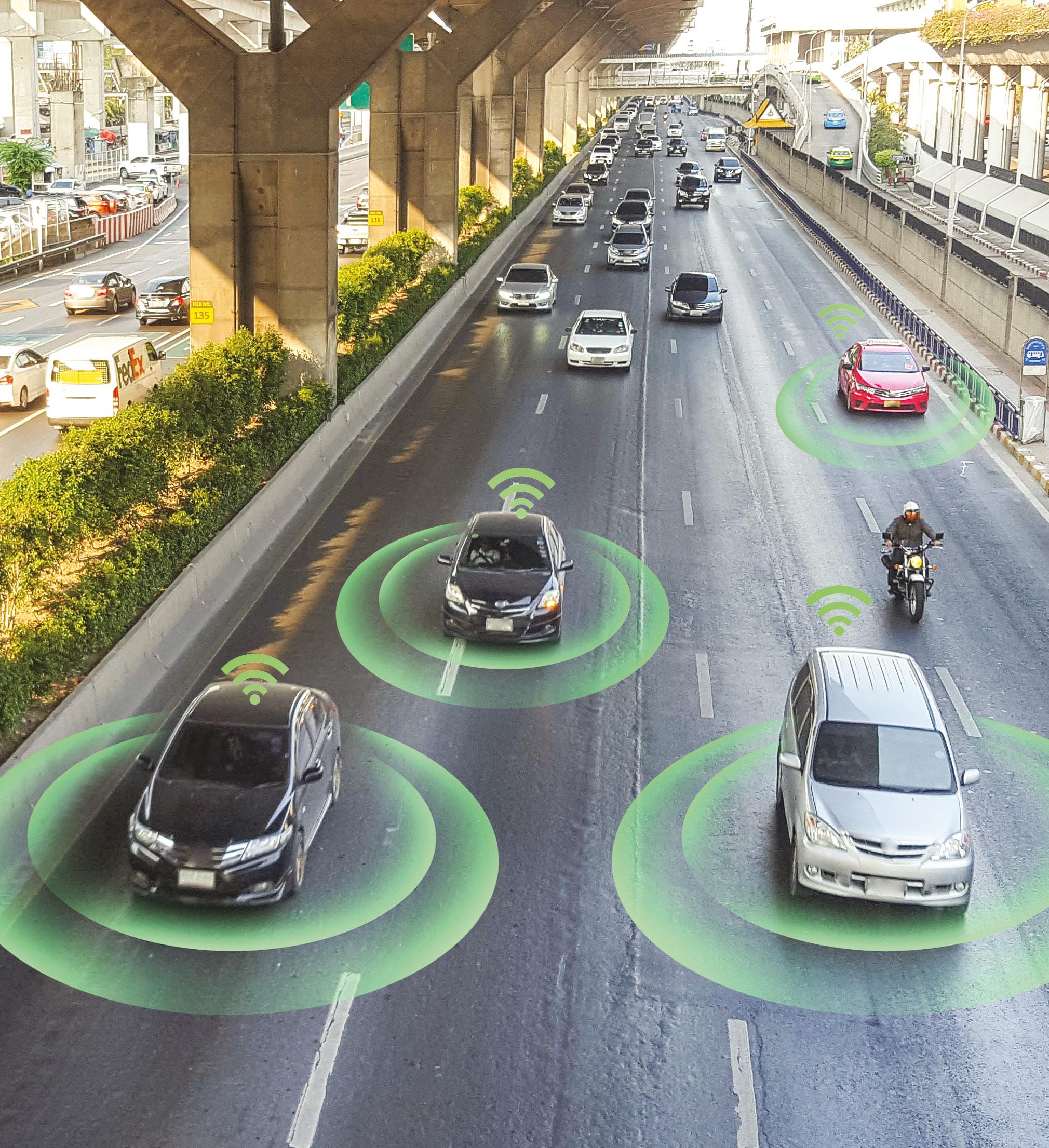
“Through our project, we found a genuine concern about Australia lagging behind the application of these technologies and particular workforce development.”
Alongside a collaborative approach between governments, education and the private sector, getting the community engaged is vital.
“Assessing what the community sees as priority needs for the industry, as well as what it is we need to do with transport, what are the key pain points and how do we target resources, those will help address the challenges.
“There is a lot of goodwill, but I think it is time to maybe bring these stakeholders together. We have suggested a national summit to bring together all the stakeholders to look at strategies and to look at what the community wants in addition to other key stakeholders.
“The industry is looking for direction and in the absence of direction, they're doing their best guess estimates, if you like, of what needs to be done.
“This technology is developing very fast and policies need to be in place to guide it. We are lagging behind, but we have the potential and the goodwill to move forward.”
www.infrastructuremagazine.com.au September 2023 // Issue 28 49 INTELLIGENT TRANSPORT SYSTEMS (ITS)
THE POWER OF EDGE COMPUTING IN INDUSTRIAL ENVIRONMENTS
It sounds simple, but the edge computing approach has huge potential for many industries, especially in industrial settings where fast processing, minimal delay, and strong connections are crucial.
THE HISTORY
Edge computing has been used in IT environments for several years, with its origins dating back to the early 2000s. However, it has gained significant attention and widespread adoption in recent years due to the exponential growth of connected devices, the Internet of Things, and the increasing demand for real-time data processing and analysis.
WHAT IS EDGE COMPUTING?
Edge computing refers to a decentralised computing infrastructure where data processing and storage occur at the network edge. Unlike traditional cloud computing models, which rely on central data centres, edge computing empowers organisations to process data locally, reducing latency and enhancing real-time decision-making capabilities.
By enabling data analysis and processing at or near the point of origin, edge computing minimises the need to transmit vast amounts of data to distant cloud servers, in turn optimising network bandwidth and improving overall system performance.
WHERE IS THE ‘EDGE’?
As hinted at earlier, the edge typically refers to the "edge" of the network. However, the ‘edge’ in edge computing can be physically distributed across various locations, depending on the application and requirements. It can exist within a water processing plant, on a remote oil rig, or within smart city infrastructure. The exact location of the edge is determined by the need for low latency, local processing, and proximity to the data source.
In essence, the edge is wherever the critical data generation and processing occur, ensuring rapid response times and reducing reliance on centralised cloud infrastructures.
IT AND OT INTEGRATION
Despite its increasing importance in both IT and OT environments, there are distinct differences in their focus
and applications. The adoption of edge computing in the IT environment has surged ahead, but because OT environments prioritise real-time control, safety, reliability, and maintaining operational continuity, integrating edge computing into the OT environment has been a slower process.
Nevertheless, leveraging edge computing in OT enhances operations by enabling faster, more efficient data analysis, predictive maintenance, and improved decisionmaking capabilities.
WHAT ARE THE APPLICATIONS IN INDUSTRIAL ENVIRONMENTS?
Edge computing has found significant applications across various industrial sectors, including resources, smart cities and infrastructure, utilities and transport.
For smart cities and infrastructure, edge computing enables operators to collect and process real-time data from various IoT devices and sensors, including traffic patterns, air quality, waste management, and energy usage.

This instant data processing allows for immediate responses and informed decision-making.
WHAT ARE THE DIFFERING EDGE TECHNOLOGIES?
Edge computing encompasses a range of technologies that work in tandem to deliver efficient and scalable solutions. These technologies include edge servers, edge gateways, edge analytics, and edge devices. Edge servers, often located near the data source, handle data processing and storage tasks, providing computing power at the edge of the network.
Edge gateways act as intermediaries between edge devices and cloud services, enabling seamless integration and secure data transfer. Edge analytics refers to the capability of performing advanced data analysis and processing at the edge, enabling real-time insights and decision-making. Lastly, edge devices encompass a wide range of sensors, actuators, and intelligent devices that collect and generate data at the edge. With applications spanning across multiple industries, edge computing is changing the way organisations leverage data for decision-making. By bringing computation closer to the edge, organisations can minimise latency, improve response times and empower decision-makers to make informed choices.
Learn more about this topic with Madison Technologies
If you need help building, optimising, or scaling Edge Technologies in your organisation, we recommend booking a discovery session with our technical team, visit www.madison.tech or phone 1800 72 79 79.
September 2023 // Issue 28 www.infrastructuremagazine.com.au 50 INTELLIGENT TRANSPORT SYSTEMS (ITS) // SPONSORED EDITORIAL
In the constantly developing world of technology, edge computing is an innovative concept that brings computing and data storage closer to where data is created.
Industry 4.0 enablement

Unlocking future potential with digital transformation

Connect and protect people, assets and the environment

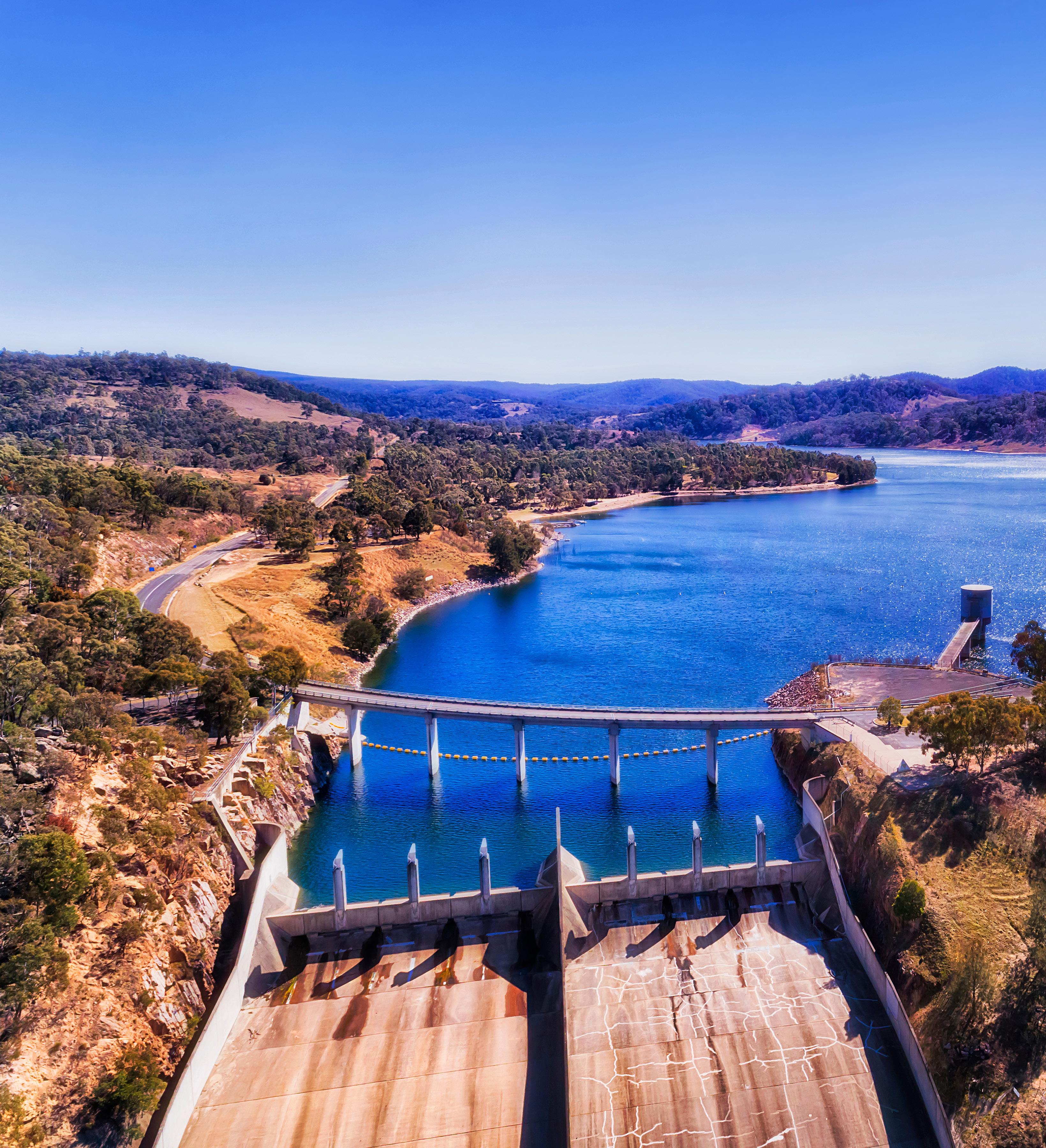
With a 30-year legacy of providing resilient industrial technology solutions, our experience connecting and protecting people, assets and the environment means we’re the preferred partner for solving IIoT, industrial networking, cybersecurity, asset management and asset visibility challenges.
Find out more.

P 1800 72 79 79 www.madison.tech
Edge Technology.
Industrial Connectivity.
Camera-asa-Sensor.
Cybersecurity.
Industrial IoT.
INTELLIGENT TRANSPORT SYSTEMS (ITS)

52
A test train approaches the new Anzac Station.
Image: Metro Tunnel.
METRO TUNNEL’S SMART FEATURES PUT TO THE TEST
The Metro Tunnel – Victoria’s biggest transport infrastructure project in more than 40 years – has reached an historic milestone, with two test trains entering the twin 9km tunnels deep beneath Melbourne in the early hours of 25 July 2023, putting the new infrastructure, and its smart signalling system, to the test.

53 INTELLIGENT TRANSPORT SYSTEMS (ITS)
As most of the city slept, the trains successfully made a 1.7km journey at low speed from the South Yarra entrance to Anzac Station – one of five new underground stations that have been built as part of the city-shaping project.
The trains continued their inaugural trip the following night, passing through Town Hall, State Library and Parkville stations before reaching Arden Station and returning to Anzac.
A NEW CHAPTER FOR THE PROJECT
The landmark moment was years in the making and marks the start of the project’s next major testing phase inside the new tunnels and stations.
Rail Projects Victoria (RPV) CEO Nicole Stoddart was among a small group on the Anzac platform to cheer the first train through.
Ms Stoddart said train testing in the tunnels was the start of a “long and complex phase” for the project.
“We need the time to be thorough and ensure a safe and enjoyable travelling experience for our future passengers,” Ms Stoddart said.
“The new cutting-edge signalling system is a crucial part of this work. We’re making sure these systems can communicate and work together, to help us run more trains, more often for the people of Victoria.”
Metro Trains’ Operational Standards and Safety Manager
Sam Eades was one of the drivers behind the first trains, describing it as a “surreal” experience.
“It’s an honour,” Mr Eades said.
“There’s been so much work leading up to this. It’s been so long coming. It’s kind of a little bit surreal to have two trains in the tunnel.”
Over the coming months, the seven-carriage trains will run back-and-forth deep under the CBD and Yarra River testing various equipment and systems to ensure they are working seamlessly and safely.
Fundamentals – such as lining the trains up with the platforms – will be tested first before the team gradually increases the complexity, from one train at low speed using minimal power, through to multiple trains at greater speeds. Everything from lifts, escalators, security systems, communications, lighting, plumbing, power and the Victorianfirst platform screen doors will all be rigorously tested to ensure all systems are working together with the new trains.
In 2024, teams will trial train services running from Clayton to West Footscray through the Metro Tunnel using the new signalling system, with station staff and drivers in a ‘dress rehearsal’ before opening to passengers in 2025.
This period will simulate timetabled services and a range of scenarios to confirm that everything is safe, reliable and efficient.
Metro Tunnel Project Director Ben Ryan said launching trains in the tunnels was a significant achievement for the team.
“This is a huge part of our work to make the Metro Tunnel passenger ready,” Mr Ryan said.
“We’re making sure all the pieces that fit together to set our stations up for day one are in working order. That includes things like lifts, escalators, lighting, tunnel ventilation and power.”
LONG-AWAITED NETWORK UPGRADE NEARS COMPLETION
The Metro Tunnel is an unprecedented upgrade of Melbourne’s train network, and the first major metropolitan rail investment since the City Loop opened in 1981.
It will allow more connections and faster journeys by joining the Sunbury and Cranbourne/Pakenham lines via a new tunnel, creating a new end-to-end rail line under the city from the north-west to the south-east.
The project will provide rail access to Parkville’s medical and research precinct – destinations such as the University of Melbourne, Royal Melbourne Hospital and Peter MacCallum Cancer Centre – and the St Kilda Road employment precinct for the first time, reducing travel times.
Passengers on every other line will have an easier transition between City Loop and Metro Tunnel services with pedestrian interchanges from Melbourne Central Station to State Library Station, and Flinders Street Station to Town Hall Station.
Since major construction started in 2017, the team has successfully:
♦ Launched four tunnel boring machines to excavate the twin 9km tunnels
♦ Brought the five new underground stations from concept to reality
♦ Installed the Victorian-first platform screen doors
♦ Upgraded Melbourne’s decades-old train signalling and systems
♦ Laid the final lengths of steel rail through the tunnels
COMPLEX JOURNEY AHEAD TO INTEGRATE SMART TECHNOLOGY
But arguably the most complex phase of the project is just starting: integrating the cutting-edge signalling system that will control trains through the tunnels.
Before the ribbon is cut on the Metro Tunnel Project, a huge program of testing needs to be carried out to ensure all the new systems are working in unison.
A crucial part of this is the project’s High Capacity Signalling, with teams installing 21st century technology alongside a 20th century system along sections of the busy Cranbourne/ Pakenham and Sunbury lines – and both systems need to communicate with each other.
It’s the first time in Australia that High-Capacity Signalling has been installed on an existing network alongside a decades-old signalling system, with the two needing to be integrated seamlessly.
September 2023 // Issue 28 www.infrastructuremagazine.com.au 54 INTELLIGENT TRANSPORT SYSTEMS (ITS)
“Digging the tunnels and building the stations is hard – really hard. But installing a brand new, high-tech signalling system, and ensuring it works safely and smoothly with the rest of the network, is arguably more challenging,” Mr Ryan said.
“We have some of the best signalling experts in the world right here in Melbourne, working on this project – so I’m confident we’ll get there.”
The High Capacity Signalling – which works in a similar way to adaptive cruise control in cars – will gather information from Melbourne’s new fleet of trains and equipment located along the rail line and transmit the data to signal control centres in Sunshine and Dandenong.
Highly qualified signallers and controllers will then direct trains along the line and through the tunnels using real-time information to maintain a safe distance between trains and let drivers know when to safely go or stop.
The existing system has been used on Melbourne’s rail network for more than 70 years. It’s safe but uses coloured signals – like traffic lights – to let a driver know when it is safe for a train to go, which limits how closely trains can run together.
The upgrades mean trains can safely move closer together, meaning more trains, more often.
RPV’s Deputy Director Systems Andrew Nelson described the signal control centres as the “nerve centre” for the Metro Tunnel.
“As we move forward to services in 2025, this area is key to our ability to test and control all our network,” Mr Nelson said.
“When the railway networks were first built in Melbourne, all of our signalling equipment was manually controlled.
“We’ve moved on from there. We can do all of that out of this control centre.”
ARE WE THERE YET?
The Metro Tunnel will change how people move around the city, suburbs and state – but Ms Stoddart said there remained significant work to be done.
“While we know this milestone is worth celebrating, there’s a lot more work to do,” Ms Stoddart said.
“We’ll also be looking at the High Capacity Signalling equipment and the systems and we’ll be making sure the train is talking to those systems. Just like the platform screen doors need to align to the train, other systems need to send information to the passengers of that train.
“We’ve got lighting, power, communications, safety, security, all of these systems to come together, including our platform screen doors.”
When finished, the Metro Tunnel will create capacity for more than half a million extra passengers to travel by train during peak times every week.
As the long and challenging period of testing inside the tunnels continues into 2024, the project team will be buoyed by the knowledge they are working towards a once-in-ageneration transformation of Melbourne’s rail network.

www.infrastructuremagazine.com.au September 2023 // Issue 28 55 INTELLIGENT TRANSPORT SYSTEMS (ITS)
State Library Station. Image: Metro Tunnel.
OPENING UP CENTRAL AUSTRALIA WITH THE OUTBACK WAY
By Stephanie Nestor, Assistant Editor, Infrastructure Magazine
Efforts to finish sealing Australia’s longest shortcut across Central Australia – the Outback Way – started over two decades ago, with recent government funding signalling that the end of the long-awaited highway’s construction is finally on the horizon. As a key tourism and freight route, the Outback Way is more than just a road. For remote Australia, the basic infrastructure of a paved road holds the potential to open up the country and connect communities with new opportunities.
Stretching 2,720km from Laverton in Western Australia to Winton in Queensland, is a series of connecting roads that form the Outback Highway, otherwise known as the Outback Way. Dubbed ‘Australia’s longest shortcut’, the Outback Way cuts through Central Australia to provide a direct route from East to West for tourists and freight drivers.
However, with almost 1,200km of the route left unsealed, the journey is difficult. Dirt and gravel roads are susceptible to damage and can be unusable after extreme weather events. So when these roads are out of action, it halts all movement in the region, leaving people isolated.
In February 2022, the Federal and Western Australian Governments announced $678 million in funding to seal the remaining sections of the Outback Way. $400 million has been allocated towards the Western Australian section, with
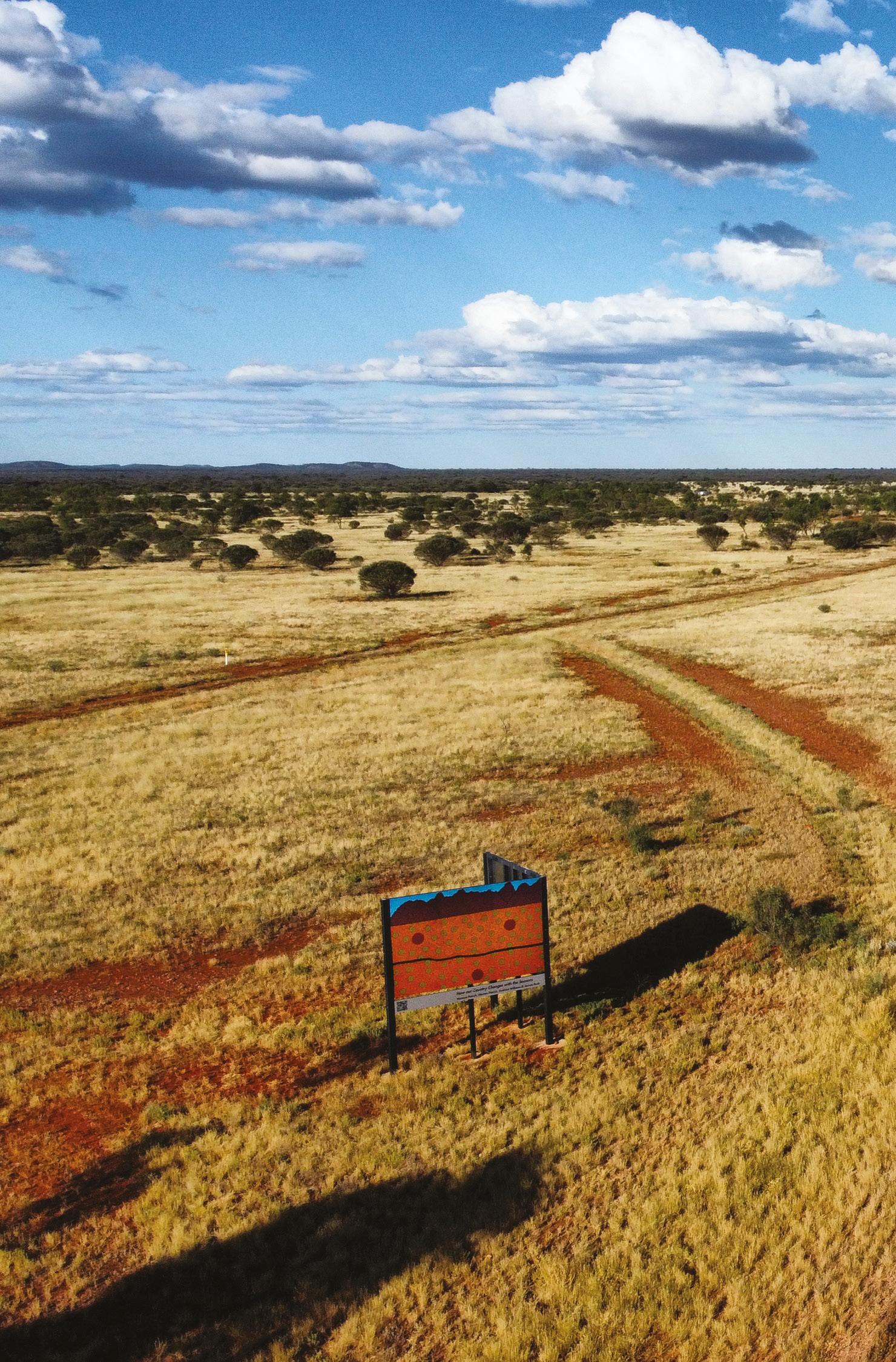
the Western Australian Government contributing an extra $100 million, and $154 million going towards the Queensland section.
Once complete, a paved route that goes from one side of the country to the other can unlock numerous possibilities for remote Australia, which is often left disconnected from the rest of the nation.
SAFETY ISSUES ALONG THE HIGHWAY
Formed in 1998, the Outback Highway Development Council (OHDC Inc.) is an alliance of councils dedicated to advocating for the upgrading and sealing of the Outback Way. For decades, the OHDC Inc. has lobbied all levels of government to secure funding to upgrade gravel and seal dirt roads along the highway, as well as boost tourism for remote communities.
So far, the OHDC Inc. has secured $1.2 billion in funding and aims to get the Outback Way sealed by 2027/28. With
September 2023 // Issue 28 www.infrastructuremagazine.com.au 56 ROADS AND TRAFFIC
increasingly frequent extreme weather events and a growing tourism sector, it is more important than ever to finish paving the highway to create a reliable way in, and out, of these remote areas.
OHDC Inc. General Manager, Mel Forbes, said leaving the route unsealed poses many safety issues that endanger drivers and deter visitors from entering Central Australia.

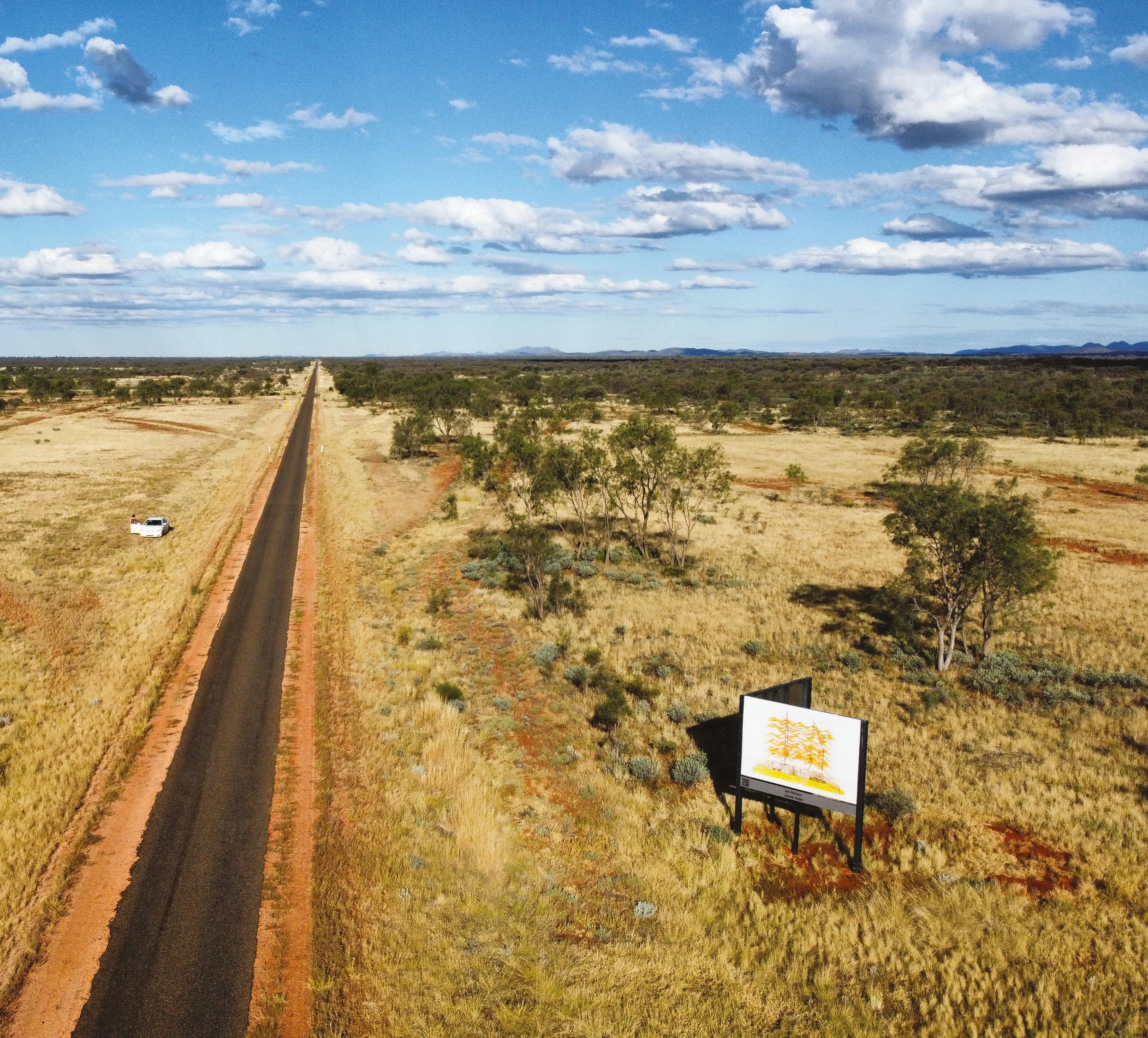
“The unsealed sections are quite famous in parts for corrugations, making them rough and dusty. These dirt and gravel roads are prone to erosion, which means they are risky most of the year and unpassable during extreme weather events,” Ms Forbes said.
“With an increased risk of accidents and loose gravel along the roads, it's just not the optimal surface to be travelling along. It makes it difficult to maintain control of vehicles and recreational vehicles, such as caravans, especially for drivers who are perhaps not as experienced as local drivers in those conditions.”
Ms Forbes also explained that there is also a massive economic impact to leaving the route partly unsealed.
“For local communities, heavy rain can cut off communities and just stop everything. That in turn feeds into increased maintenance and more frequent repairs, which becomes quite expensive for councils and businesses.”
www.infrastructuremagazine.com.au September 2023 // Issue 28 57 ROADS AND TRAFFIC
Image credit: Mel Forbes, General Manager of OHDC Inc.
THE EVOLUTION OF TOURISM POSSIBILITIES
There’s plenty to see and do along the Outback Way, including sites like Uluru, roadhouses, galleries, tours and more. But for many tourists, the journey can seem daunting as driving down the entire route can take well over a week.
Ms Forbes said paving the Outback Way will boost tourism in the region by improving accessibility and economic opportunities, allowing more people to experience what Central Australia has to offer.
“People are going to be much more inclined to do the quite lengthy drive if it's not too bone-jarring and a lot more comfortable. There’s also the issue of breaking down in those areas, because people are a little mystified as to how they're going to get out of that situation,” Ms Forbes said.
“What these upgrades will also do is increase the economic possibilities in terms of businesses setting up along the way, and therefore growing the economic capacities for the communities and the locals along the roads.
“There will be a continual evolution of tourism possibilities along the way as tourism providers work out different experiences, such as opening up accommodation and dining areas. This will also offer more possibilities for the local Indigenous communities along the Outback Way to increase their financial security with steady work in the tourism industry or other entrepreneurial opportunities.”
With the world’s largest Geocache trail and the Outdoor Gallery – which displays 28 works of art on 14 billboards across 111km of the highway – the Outback Way is a growing space for artists and tourism. More people travelling through means more infrastructure being built and more money being injected into these remote communities.

SECURING THE ROUTE FOR INDUSTRIES
The Outback Way is utilised by many industries, including freight and logistics, tourism, agriculture and mining. Paving the rest of the highway will significantly reduce travel times,

which will in turn provide a safer and more cost-effective route. Currently, it takes a light vehicle 33.9 hours to travel along the Outback Way, whereas it takes a heavy vehicle nearly 40 hours to do the same journey. However, once the route is completely sealed, it is projected to be 19-20 hours for both light and heavy vehicles.
For heavy vehicles, cutting out 20 hours of driving can significantly reduce costs while also increasing the frequency of trucks and other vehicles making trips across the country to deliver essential goods.
Ms Forbes said this will not only make a massive difference for transportation companies, but also for communities as it will be less costly to distribute goods, including groceries and medicine, to remote areas.
“In Ngaanyatjarraku Shire stores, it's estimated that goods and foods in that shop are 133 per cent higher in price compared to consumers in the city. And that's not fresh food, that's canned and tinned goods,” Ms Forbes said.
Even for the mining industry, transportation across remote Australia is already an expensive endeavour, but when a truck or heavy vehicle is using dirt or gravel roads, the costs can quickly add up.
“For one mining company, it is estimated that it costs $10 million per annum for transportation along unsealed roads in terms of fuel and increased maintenance. The mining industry obviously contributes a massive amount to the nation in their gross domestic product, so adding $4 per ton to the cost translates into adding another $4 per ton to bring products to market.”
Besides freight and mining, the cattle industry is set to benefit from a sealed Outback Way as well.
“CSIRO modelling indicates that if the road between Boulia and Alice Springs is sealed, this will increase freight and enable those cattle producers to move their stock up to the ports and through the Northern Territory much easier.”
September 2023 // Issue 28 www.infrastructuremagazine.com.au 58 ROADS AND TRAFFIC
RELIABLE ROADS FOR COMMUNITIES
Living in remote areas often means being far from help in times of emergency, especially when groceries are expensive, medical care is limited and there is only one road out of town.
Ms Forbes said a sealed highway will provide much better access to the essential services of healthcare, education, and emergency services.
“Having reliable road infrastructure that facilitates the transportation of medical personnel, supplies and equipment ensures improved healthcare services to those areas. Instead of people having to get into a truck and go along very bumpy roads when they're not well, it will mean that there's a chance for medical personnel to actually come to them,” Ms Forbes said.
Sealed roads mean remote communities are easily accessible for both locals and visitors, opening up opportunities for employment and education.
“In terms of staffing those remote communities, knowing that it's easy to get in and leave these towns, improves its attractiveness as a place to go work for a few years. Since COVID-19, the employment rate has been such a massive issue across Australia, especially in remote areas.
“That turns into opportunities for the local kids to have greater access to activities that are potentially off-community. Travelling and participating in life will enable them to be much more familiar with life outside of their remote community.”
While tourism and industry can boost economic growth in remote Australia, an increased number of drivers can pose issues for Aboriginal communities as well, with worries that over-development will push out vulnerable people. This is why the project is planning how to create the right connections for these communities.
“Even though upgrading the highway will open up and allow those remote communities the opportunity to participate in economic development, it will also allow them to clearly choose how they want to participate, because not everyone in any community wants to deal with a whole lot of people passing through their towns.
“What this does is it enables those communities by giving them agency to decide how development is going to roll out rather than having it be imposed on them.”
IT’S ABOUT EVERYONE
When building opportunities and infrastructure for remote areas, it all starts with the paving of a road. While a sealed road is taken for granted in urban areas, the paving of the Outback Way highlights how roads can connect remote communities and industries.

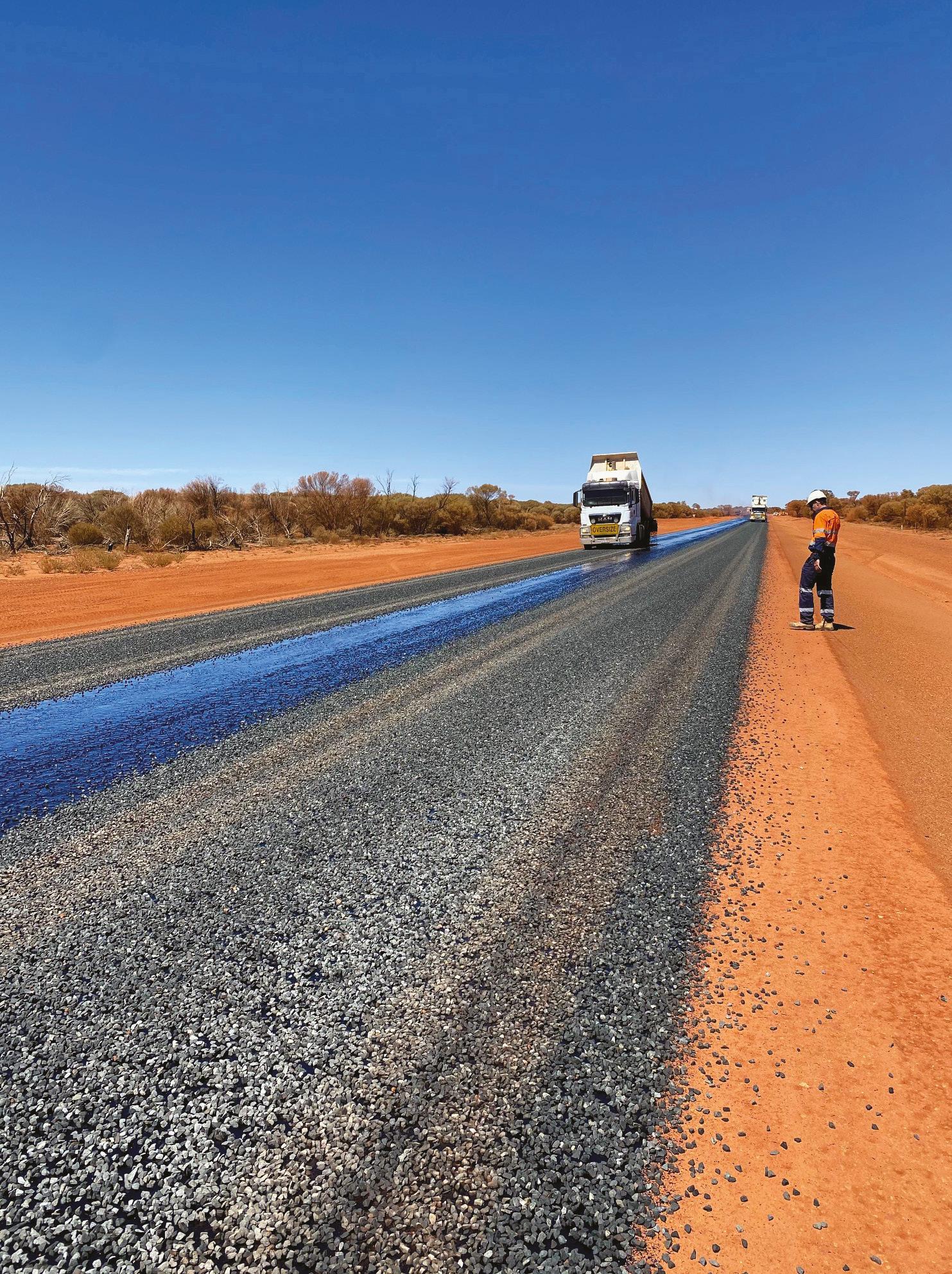
“We want to learn from what has been done in the past and make this the most inclusive and positive piece of infrastructure for everyone, and it is about everyone. It's great to talk about the economic benefits, but ultimately, it's about people, it's about communities, and it's about our broad culture,” Ms Forbes said.
“Ensuring that everyone has access to opportunities and basic things like healthcare and education, while also being able to grow opportunities from where they are, rather than having to relocate, those things just don't happen unless you have the basic infrastructure of a road.”
www.infrastructuremagazine.com.au September 2023 // Issue 28 59 ROADS AND TRAFFIC
ON THE ROAD AGAIN: EFFECTIVE SOLUTIONS FOR ASSET MANAGEMENT
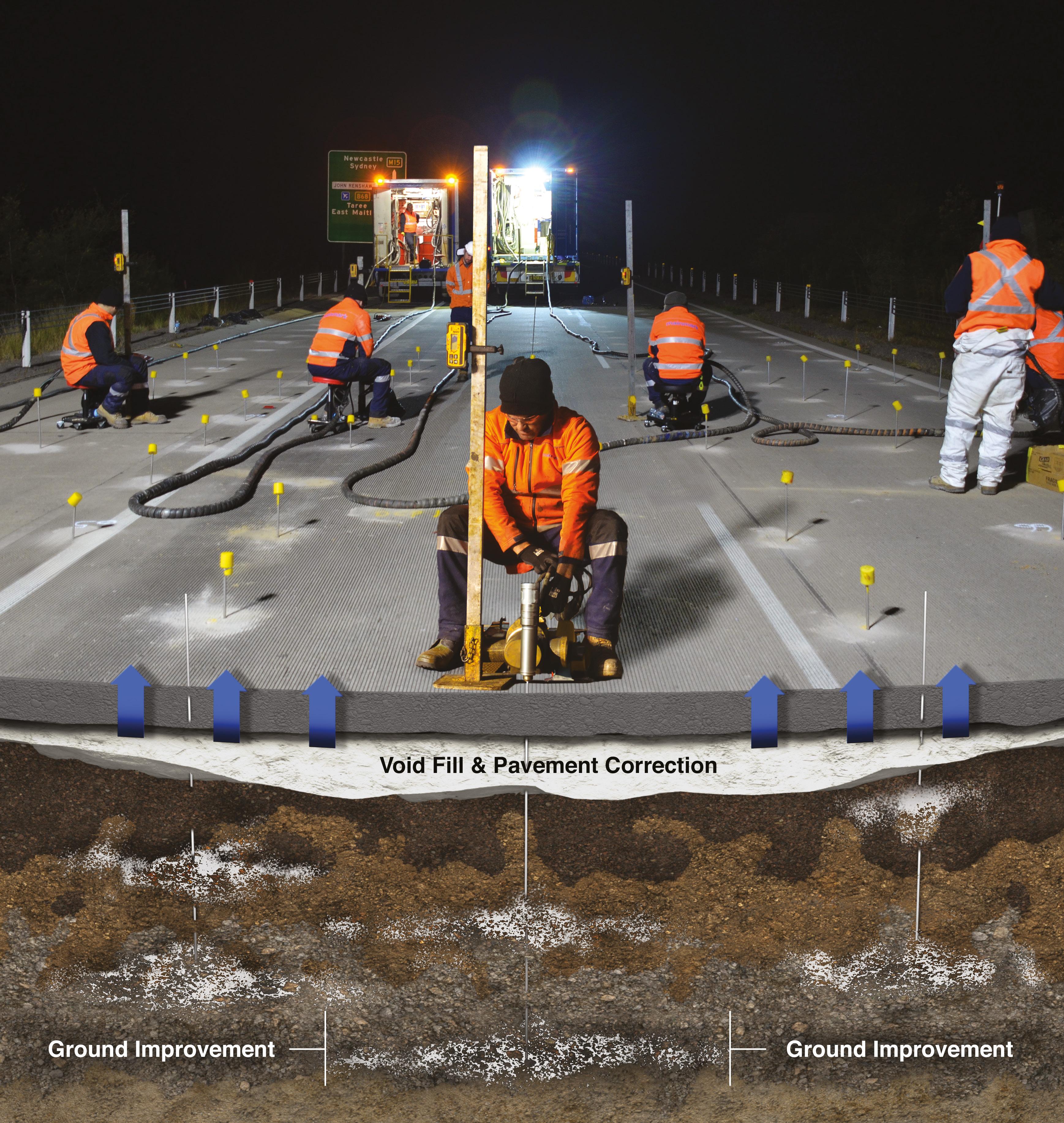
September 2023 // Issue 28 www.infrastructuremagazine.com.au 60 ROADS AND TRAFFIC // SPONSORED EDITORIAL
Roads serve as the backbone of Australia’s infrastructure, keeping people connected across vast distances. They provide access to essential services, facilitate trade and economic activity, and support seamless movement between regions. As Australia’s cities grow, roads are increasingly relied upon to accommodate traffic and provide safe and efficient transportation. That’s why employing robust maintenance and repair solutions is paramount to ensuring continued development and connectivity for the nation’s present and future needs.
The management of road assets is a complex challenge that requires balancing the needs of road users, the surrounding communities and the environment while ensuring infrastructure's continued functionality, safety, and sustainability. Moreover, it can be a costly undertaking and a significant resource drain.
As Australia’s cities grow, the climate changes, and infrastructure ages, finding low-impact solutions for repairing and maintaining roads becomes increasingly pertinent.
For almost 30 years, Mainmark has developed and delivered advanced technologies for ground engineering and asset preservation, working with the infrastructure industry to provide solutions to complex geotechnical issues alongside engineers and major stakeholders.
NON-INVASIVE ROAD REMEDIATION
Mainmark provides its well-established Teretek® Resin Injection technique as a fast, non-disruptive, and economical solution for re-levelling subsided pavements and structures and strengthening subgrade soils associated with pavement failures.
Teretek® materials expand in a controlled manner, allowing their targeted placement to fill voids, reconfirm support, and raise subsided pavements with precision.
The use of Teretek® supports a proactive approach to strengthening assets to withstand future conditions effectively.
Mainmark solutions are non-invasive and eliminate the need for extensive roadway disruption or excavation.
Often, these operations can be carried out overnight, and unlike traditional repair or replacement methods, our technologies have fast delivery and curing times. Treated areas can be used immediately, keeping Australia’s essential transport moving.
Mainmark’s solutions are particularly well suited for repairing sunken roadways (both concrete and asphalt), supporting the long-term infrastructure stability of roads, addressing voids or cavities, and reinforcing road foundations to ensure their longevity.
Some of the more common applications for the remediation of roadways with Resin Injection are:
♦ The filling of voids directly beneath pavements to reconfirm support and limit deflection and deterioration.
♦ Raising subsided pavements to re-establish design levels, drainage, or camber gradients to restore a safe and comfortable ride for motorists.
♦ Void filling, re-supporting, and raising bridge approach and relieving slabs.
♦ To provide targeted ground improvement to weak subgrade soils.
Teretek® offers several advantages and benefits when used to remediate roading infrastructure.
Cost Effective Compared to traditional methods Teretek® Resin Injection is a significantly more cost-effective solution.
Fast Correction with Teretek® Resin Injection can be completed within just a few hours rather than days.
Immediately Trafficable As soon as the repair is completed, the roadway can be reopened to traffic and full use.
Minimally Invasive Technology Repairs are performed without excavation, the need for extensive road closures or traffic disruption.
Surgical The injection process only requires small holes to be drilled through the roadway being corrected.
Accurate & Controllable The process is accurate to within a few millimetres.
Lightweight Teretek® materials do not add significant additional weight to the supporting soils (less than 200 kg / M3).
Environmentally Inert Hardened material has no effect to the surrounding soils or organisms, does not generate leachate and can be considered environmentally inert.
Self-Sealing Treatment can be safely carried out near open edges, embankments, or waterways with no risk of unwanted material escape.
To find out more about Mainmark, go to https://mainmark.com
ROADS AND TRAFFIC // SPONSORED EDITORIAL www.infrastructuremagazine.com.au September 2023 // Issue 28 61
WHY QUALITY, TESTED PRODUCTS ARE CRITICAL FOR INFRASTRUCTURE LONGEVITY
By the National Precast Concrete Association Australia
As road and infrastructure projects multiply across the nation, there’s a high demand for products with higher-than-usual lead times for precast concrete pipes and other stormwater products. But when inferior, untested products are unknowingly used, there can be a drastic negative impact on the lifespan and structural integrity of the project.
When it comes to construction projects, the devil is in the detail – that’s why the usage of properly tested and quality products is essential.
According to National Precast CEO, Sarah Bachmann, inferior products like raw cast liners are on occasion being substituted for their superior alternative, spun reinforced precast concrete liners.
“It is concerning that some authorities are installing the inferior alternative, unaware of their actual performance,” Ms Bachmann said.
Unlike spun liners, raw cast liners do not comply with AS/NZS 4058 Precast concrete pipes (pressure and non-pressure), a typical requirement of roads’ authority specifications.
Raw (or dry) cast liners are not spun, use very little reinforcement (or fibre reinforcement) and are typically untested and not manufactured to ISO 9001 accreditation.
A WA-GROWN SOLUTION
Located in Australind, Western Australia, National Precast Master Precast member MJB Industries has made the manufacture and supply of Class 2 spun liners a priority in its new pipe plant. Its original bidirectional pipe plant is currently operating at full capacity, with a production schedule booked months in advance.
MJB Director, Kim Hovey, said the new plant's first priority will be to produce spun liners, stockpiling them for current and future orders.
“Our second pipe plant will be operational in the third quarter of this year and will greatly increase production output and reduce lead times,” Ms Hovey said.
“Our spun liners are made to meet Main Roads Western Australia Specification 405, which require precast liner segments to be manufactured to AS/NZS 4058.”
Why continuous Teeroffs?
Ms Bachmann said that there are a limited number of manufacturers able to produce these spun liner products in the West.
“Other manufacturers of raw cast liners – that do not conform to AS/ NZS 4058 – are not an equivalent alternative and do not meet Main Roads Western Australia specifications,” Ms Bachmann said.
EDUCATION IS KEY
Ms Bachmann said this is an industry-wide issue that requires better understanding by everyone involved in roads and infrastructure projects.
“Compliance to Australian Standards and specifications is imperative for the longevity of our roads networks and I’m pleased to say that our Master Precasters, like MJB, ensure they do just that,” Ms Bachmann said.
Continuous Teeroff beams are typically used in the construction of long-span bridges and other large infrastructure projects and are more efficient for elevated motorways, which are necessary due to the increased urbanisation of cities and the frequent requirement to construct bridges and motorways over existing infrastructure. Their specification has become increasingly common in Western Australia, primarily in response to project specific constraints such as limitations on pier widths and structural depths, and heavily loaded edge beams on Single Point Urban Interchange (SPUI) bridges.
The beams have been used in Perth’s $1 billion Gateway WA project that upgraded the road network around Perth Airport, the Reid Highway Duplication over the Mitchell Freeway, and the northern section of NorthLink WA.
Similar in shape to standard Teeroffs – with a horizontal top flange and a vertical web – they are designed to be much longer, often spanning hundreds of meters. They are typically constructed as simply supported, with a link slab providing a continuous concrete running surface without any intermediate deck joints. Their main advantage is their ability to support very heavy loads over long distances without the need for intermediate supports.
This is achieved by joining multiple beams together with a series of welded or bolted connections, creating a continuous beam that can span the entire length of a bridge or other structure.
62 ROADS AND TRAFFIC
September 2023 // Issue 28 www.infrastructuremagazine.com.au
CASE STUDY: EFFICIENT ROAD CONSTRUCTION USING CONTINUOUS TEEROFFS
Key facts
» Project: Bunbury Outer Ring Road (BORR)
» Location: Western Australia
» Client: Main Roads Western Australia
» Construction: South West Gateway Alliance consortium (Acciona, NRW Contracting, MACA Civil, AECOM and Aurecon)
» Master Precaster: Australian Precast Solutions
The Bunbury Outer Ring Road (BORR) project is south-west Western Australia’s largest ever infrastructure project and was first proposed in 2009, with construction beginning in 2016. The new 27km, four lane ring road –that connects the Forrest Highway with Bussell Highway – consists of dual carriageways, roundabouts, and overpasses.
The project is being constructed by the South West Gateway Alliance consortium, comprising Acciona, NRW Contracting, MACA Civil, AECOM and Aurecon. It forms part of the post-COVID-19 recovery infrastructure programme, with 80 per cent of its $852 million cost being funded by the Federal Government, and the remainder coming from the State Government. The BORR is set to improve access to Bunbury and other regional destinations in Western Australia’s south-west.
Reduced onsite works and costs, and increased safety, are evident in this Western Australian motorway, due to the use of 139 precast concrete Teeroff beams that have been manufactured with strict quality requirements.

As a National Precast Master Precaster – and like other Master Precasters –Australian Precast Solutions has been independently audited by National Precast Concrete Association, to not only ensure its quality systems are being implemented on a daily basis, but safety and environmental systems as well.
Weighing a huge 191t and measuring 41m long, the Teeroffs are 2.2m deep by 4.5m wide, and were manufactured for the project at the precaster’s newly built and commissioned factory in Bunbury.
Of the project’s $852 million cost, around $450 million is being spent with local south-west businesses and $30 million on First Nations businesses, with First Nation employment a priority.
The project is also an example of sustainable infrastructure development, designed with environmental considerations in mind, featuring wildlife crossings which allow animals to safely cross the road without endangering themselves or motorists.
When complete, the Bunbury Outer Ring Road will be a vital artery that connects the city's northern and eastern suburbs with the South West Highway, easing traffic congestion and reducing travel times.
As well as improving access to Bunbury and other regional destinations, it will also alleviate the convoluted previous freight network that impeded freight and transport efficiency.
www.infrastructuremagazine.com.au September 2023 // Issue 28 63 ROADS AND TRAFFIC
CLIMATE CONSCIOUS ENGINEERING AT CSE23
With Australia’s engineering sector at the forefront of innovation globally, Engineers Australia’s Climate Smart Engineering Conference 2023 (CSE23) has gained a reputation as a focal point for informed discussion and profiling of new and emerging technologies.
CSE23 will be held at the world-class sustainable Melbourne Convention and Exhibition Centre on 29–30 November. This is a flagship conference for knowledge-sharing, networking and engaging debate on engineeringled climate solutions – reflecting the critical role the profession will play in driving the economy-wide transition to net-zero.
Now in its third year, the program for CSE23 includes some of the profession’s brightest and boldest minds – as well as key leaders across government and industry – offering diverse perspectives on climate mitigation and resilience, the clean energy transition and circular economy opportunities.
Speaker line-up includes:
» Dr Gill Armstrong, Senior Project Manager, Climateworks Centre, Monash University
» Dr Alan Finkel AC, former Chief Scientist of Australia
» Ruby Heard CPEng, Director, Alinga Energy Consulting
» Lisa McLean, CEO, Circular Australia
» Lara Parsons, MIEAust, Senior Associate Infrastructure Delivery and Strategic Advisory, Jacobs
» Adrian Piani, FIEAust, CPEng, EngExec NER, ACT Chief Engineer, ACT Government
» Kane Thornton, Chief Executive, Clean Energy Council

Engineers Australia Chief Executive, Romilly Madew, said, “Whether it’s adapting to the impacts of climate change, designing, developing and deploying safe, affordable and innovative technologies to support decarbonisation, or moving to a more circular economy, engineers are essential in addressing climate change.”
As an active participant in COP27 and COP28, Engineers Australia continues to build strategic alliances with global partners to meet shared obligations to curb carbon emissions, achieve the Nationally Determined Contribution commitment to Australia's emissions reduction target of 43 per cent, and net-zero emissions by 2050.
CONFERENCE THEMES FOR 2023
The key themes that underpin the 2023 conference program include adaptation and mitigation, resilience, social impact, business management, regeneration and systems thinking, the energy transition, circular economy, technology and innovation.
“This conference builds on our international advocacy, but it is also a key opportunity to profile best practice and thought leadership,” Ms Madew said.
“This is a conference for everyone, engineering and industry leaders, and our leaders of the future will be able to share in the latest thinking while also building those all-important networks that help drive innovation in our sector.”
The two-day program includes a variety of speakers and topics that will challenge, confront and inspire attendees.
At the 2023 event, a full technical program chaired by Engineers Australia Chief Engineer, Jane MacMaster, will support the plenary sessions.
“Engineers Australia is proud of the expertise and diversity of speakers selected for the CSE23 event program, which was developed in consultation with our members and the CSE23 Plenary Program Advisory Council,” Ms MacMaster said.
“Addressing an issue as significant and wide-reaching as climate change will require engineers to work collaboratively with stakeholders right across the economy. The foundations we build now will shape the future of our country, and support effective pathways to net-zero.”
To learn more about CSE23 and register, visit engineersaustralia.org.au/cse
64
ROADS AND TRAFFIC // SPONSORED EDITORIAL
ACCELERATING AUSTRALIA’S TRANSITION TO NET ZERO EMISSIONS


Climate Smart Engineering Conference 29-30 November 2023 | Melbourne
Connect with the profession’s brightest and boldest minds, government and industry leaders to help shape a sustainable future at the Climate Smart Engineering Conference this November. Register now engineersaustralia.org.au/cse Conference partners
WESTERN SYDNEY INTERNATIONAL
AIRPORT
PROGRESS:
AN AIRPORT FOR THE FUTURE
The construction of the Western Sydney International (Nancy-Bird Walton) Airport (WSI) is building momentum as it achieves significant milestones, featuring a keen focus on sustainability.
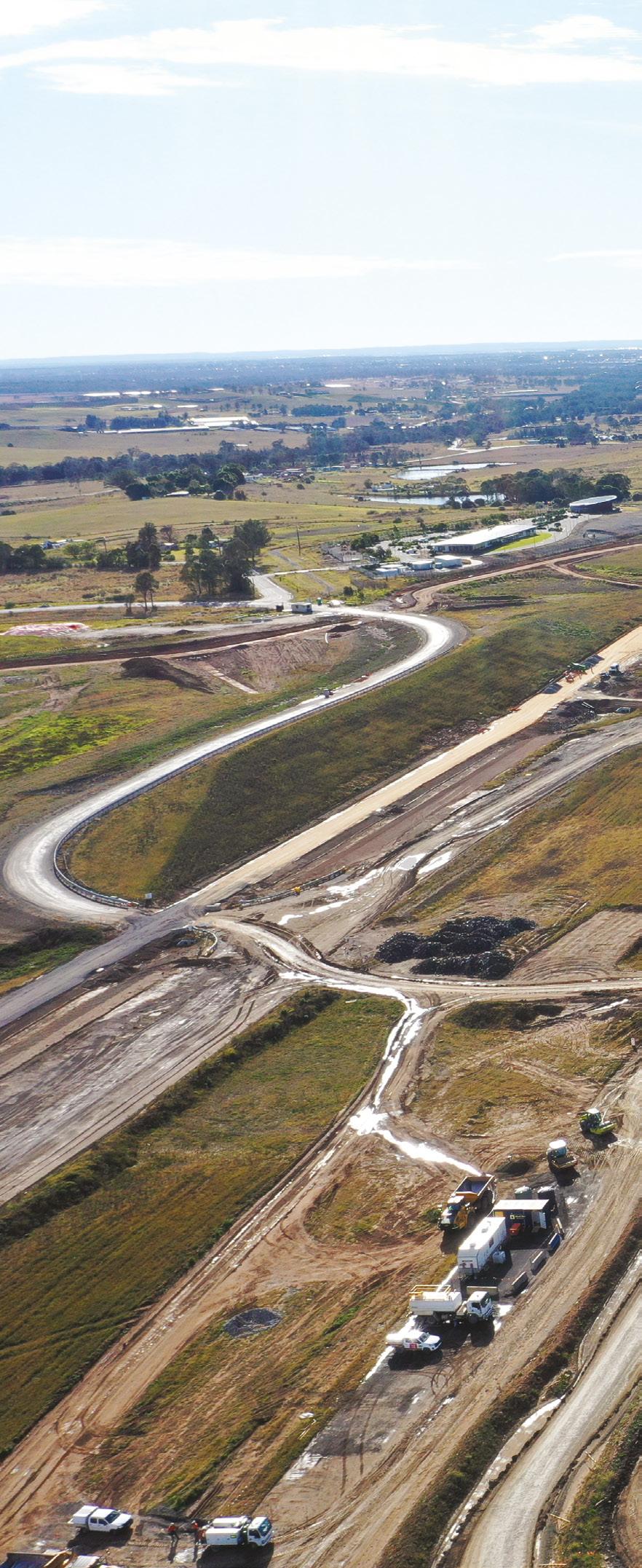
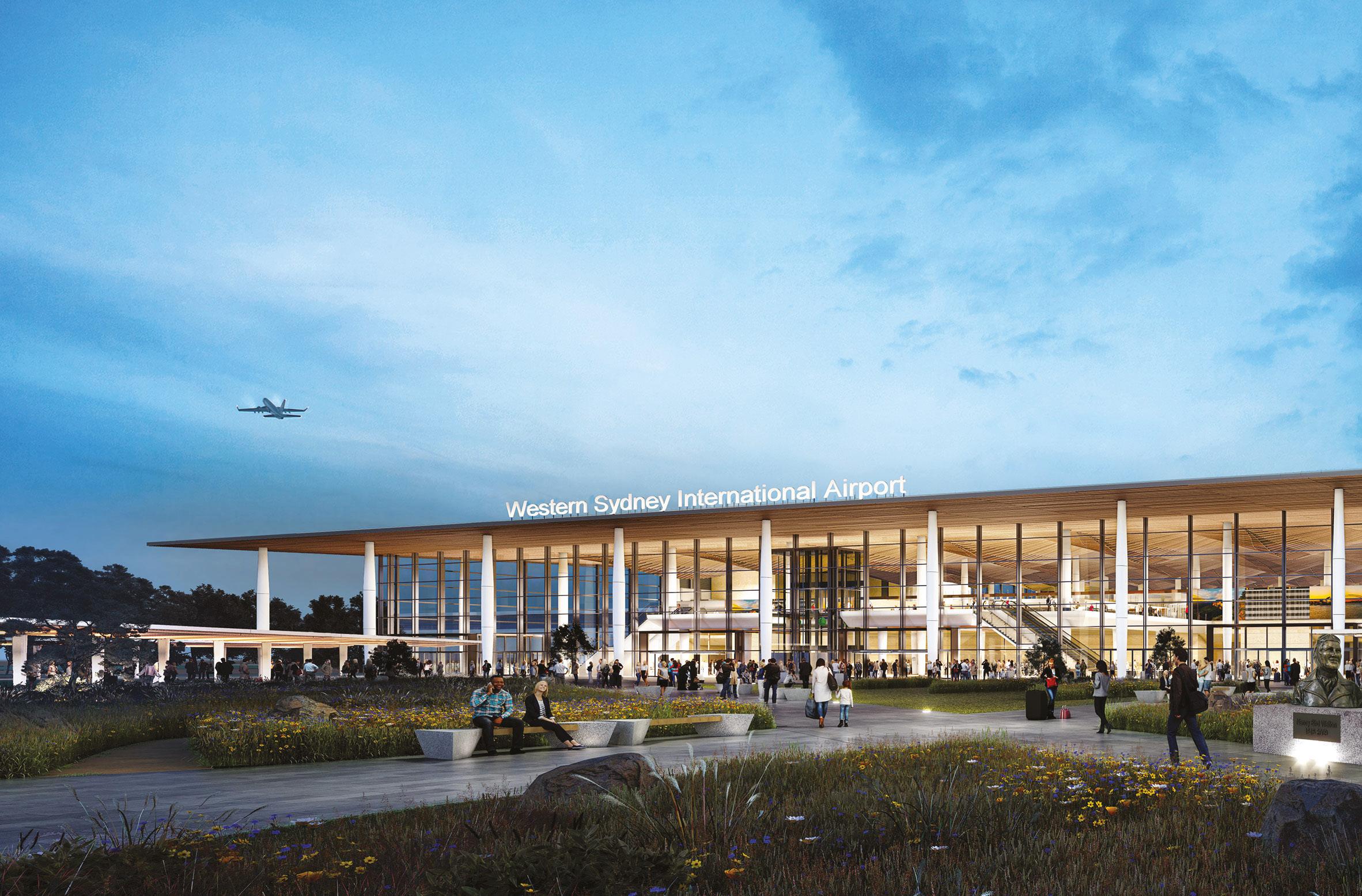
September 2023 // Issue 28 www.infrastructuremagazine.com.au 66 SUSTAINABILITY
The WSI, set to open in 2026, aims to ease congestion for Sydney residents, open up the city’s airspace, and accommodate 10 million passengers per year – among many other benefits for the growing region.
It also ensures that the airport will be sustainable for decades to come, with recycled materials being used in the construction, recycled water being captured and used on site, and landfill diversion being a top priority.
The airport is progressing well, with stage one of the full-service domestic, international and air cargo airport build achieving 50 per cent completion in May 2023.

Earthworks for WSI has been one of Australia’s largest earthmoving projects, with 26 million cubic metres of earth moved around the site, which was completed in April 2023.
WSI’s CEO, Simon Hickey, said that these milestones are a testament to the great work being done by the team at WSI, contractors and staff.
“All is on schedule for WSI’s planned opening in late 2026,” Mr Hickey said.
“The creation of jobs and the economic uplift that the new airport will provide, will be a multi-generational game changer, particularly for Western Sydney”.
There are more than 3,200 people working on-site in this peak construction phase, 54 per cent of whom live in Western Sydney.
‘Learning’ workers, which include trainees, graduates, apprentices and workers training to upgrade their qualifications and skills, currently account for 30 per cent of the workforce.
“Over $400 million has been spent supporting around 250 Western Sydney-based
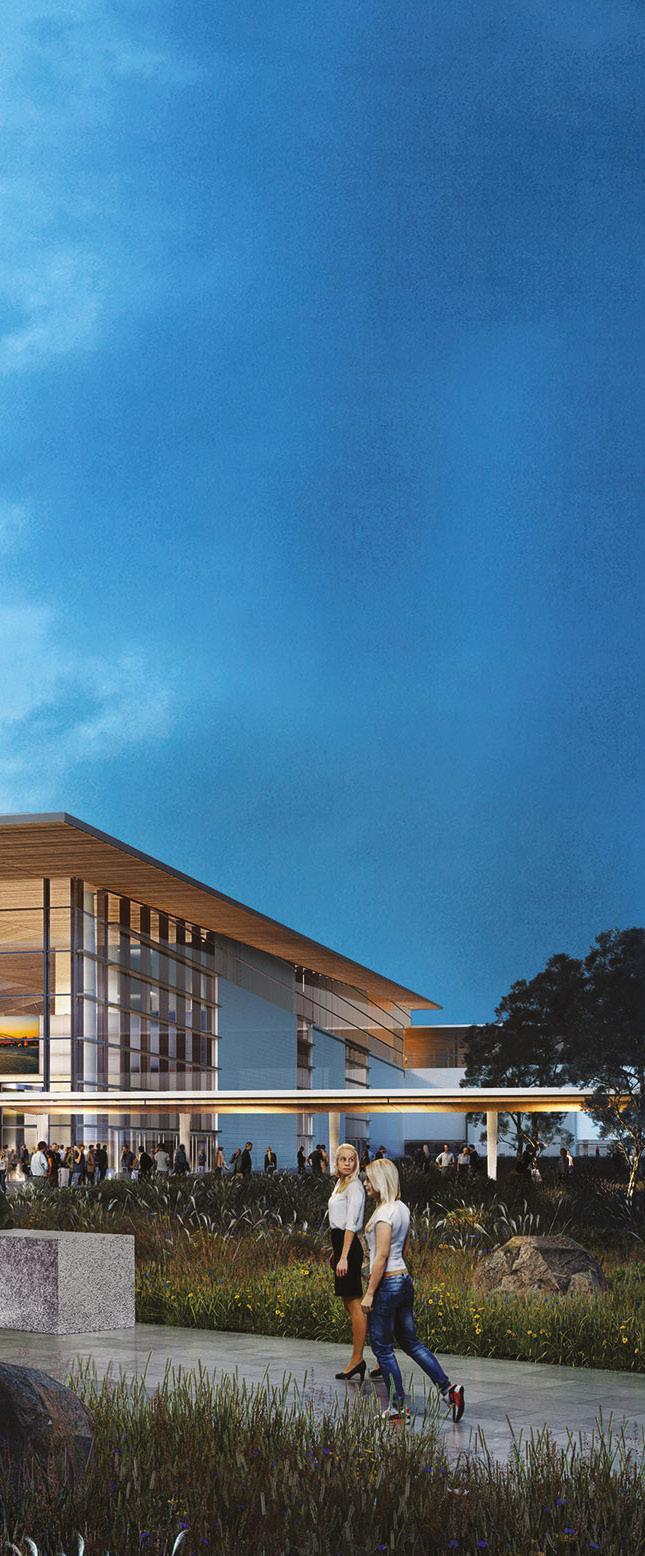
www.infrastructuremagazine.com.au September 2023 // Issue 28 67 SUSTAINABILITY
Airside runway as of June 2023.
businesses. This means more local jobs, more investment in the local economy and more opportunities for these businesses,” Mr Hickey said.
“This investment in the region will only intensify as WSI moves through its construction phase and into airport operation.”
With more than $15 billion of investment in supporting road, rail and social infrastructure, and indirect job creation from flow-on benefits of the airport, the WSI is driving the creation of 200,000 new jobs in the region and boosting the local economy.
The national carrier, the Qantas Group, announced plans to operate up to 15 aircraft from WSI within the first year and to focus on recruiting locals, with approximately 700 jobs up for grabs.
The international, domestic and air cargo operations will provide a source of aviation growth for Sydney for decades and is predicted to generate an estimated $24.6 billion in direct
expenditure by 2060, and a $23.9 billion increase in the nation’s GDP.
At opening, WSI will be able to cater for up to 10 million passengers a year and is planned to grow to service 80 million passengers annually in the early 2060s, making it around the same size as Dubai and Hong Kong today.
LARGE-SCALE CONSTRUCTION CONTINUES
WSI’s 3.7km long runway will be capable of servicing any commercial aircraft, including the next generation of ultra-long-haul airliners. The surface is made of two pavement types – rigid (concrete) and flexible (asphalt); the rigid sits at both ends of the runway and each is about 250m long.
On the runway, 12,055m³ of concrete has been poured and two layers of flexible pavement will use a total of 53,227t of asphalt.
The entire runway sits on a layer of crushed sandstone (approximately 1800mm deep) that was imported from
tunnelling projects in Sydney and the asphalt section of the runway sits on around 180,333t of fine crushed rock.
The WSI Airside Contractor has completed an innovative concrete trial for the rigid airfield pavements using ‘slip-forming’, which allows the concrete to be continuously poured and formed to its geometric shape, without traditional formwork.
SMART, SUSTAINABLE TRAVEL
Mr Hickey said that technology and sustainability have been in the forefront of planning and installation.
“Unlike other airports that need to retrofit ageing infrastructure, Western Sydney International Airport will capitalise on its unique greenfield opportunity by incorporating the latest technologies to create the best possible experience for airline passengers, the airlines and air cargo customers,” Mr Hickey said.
Recycled and reused content has been used during the airfield construction,
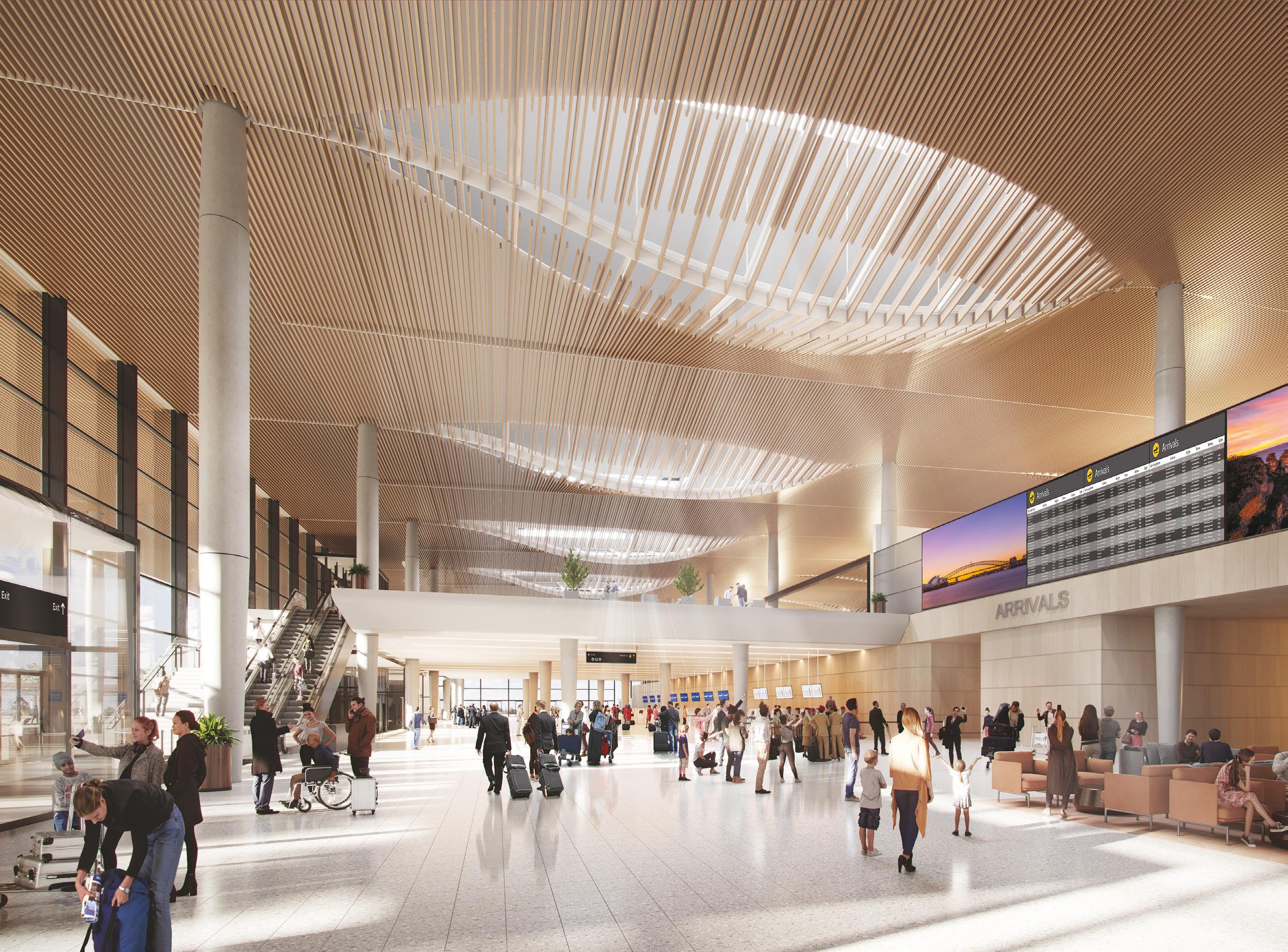
September 2023 // Issue 28 www.infrastructuremagazine.com.au 68 SUSTAINABILITY
and around 98 per cent of water used for the earthworks was recycled water that was captured on site.
The earthworks project reused or recycled a total of 5,435t of construction waste, which is a 96 per cent diversion from landfill and more than 400,000m² of recycled concrete was used.
More than 4.5 million tonnes of high-quality crushed sandstone from the Metro and WestConnex tunnelling sites has been used to construct heavy vehicle roads as well as a supportive layer that will sit beneath taxiways and runways on the airport site.

State-of-the-art, future orientated baggage handling systems are being installed, providing fully automatic sorting for departing, arriving and transfer baggage, using technology similar to that employed at major Amazon distribution centres.
To reduce carbon emissions and provide passenger comfort, the terminal has been designed with efficient air conditioning, lighting systems
and façade design. EV charging systems will be located in the carparks and the terminal roof will generate renewable electricity and harvest rainwater.
The runway will be equipped with 3000 hi-tech aeronautical ground lights that will provide significant energy and maintenance savings, and the advanced Instrument Landing System will provide the capability for aircraft to land and take off in near zero visibility.
A Business Fibre Zone is also being created, which will allow customers to access nbn’s premium business product; 25km of fibre will be installed to service the airport terminal and the future business park.
WSI: MORE THAN AN AIRPORT
Billions are being invested in roads and rail across the region to support the new airport, which will be connected by a new metro train line and toll-free M12 motorway.
The Business Precinct will initially be a 20ha development area that will eventually grow to almost 200ha, about the size of the Parramatta CBD, and will feature two train stations – one at the on-airport Business Precinct and one at the passenger terminal.
THE FUTURE
“The benefits that the construction and operation of Western Sydney International Airport will create for Western Sydney, and particularly for local young people, are unlimited,” Mr Hickey said.
“We have a vision, which is more than building an airport. Our aim is to empower our community to take advantage of the new era of jobs and opportunities that WSI will deliver to their doorstep.”
www.infrastructuremagazine.com.au September 2023 // Issue 28 69 SUSTAINABILITY
LET’S TALK WASTE: HOW THE SECTOR CAN BECOME A SUSTAINABLE FUTURE CORNERSTONE
 By Kody Cook, Journalist, Infrastructure Magazine
By Kody Cook, Journalist, Infrastructure Magazine
70 SUSTAINABILITY
Australia generated 12.7 million tonnes of construction waste in 2018, leading to the industry being criticised for hindering sustainability efforts, with the sector slow to adopt new strategies to help reduce its environmental footprint. However, new research by Bond University has found that if the construction sector wholeheartedly embraces new innovations, it could become a major player in the circular economy. Infrastructure Magazine spoke with an academic in Bond University’s Comparative Construction Research Centre, Dr Bode Ogunmakinde, to discuss how his research can help build a more sustainable sector.

71 SUSTAINABILITY
Despite efforts by the construction industry to keep up with modern advances, adopt smart technology and implement innovative processes, one historical aspect of the industry remains the same – there is a lot of waste involved in building new infrastructure.
Due to the complicated and timeconsuming nature of minimising and recycling waste, many construction companies simply take the easier option of sending all of their waste to landfill.
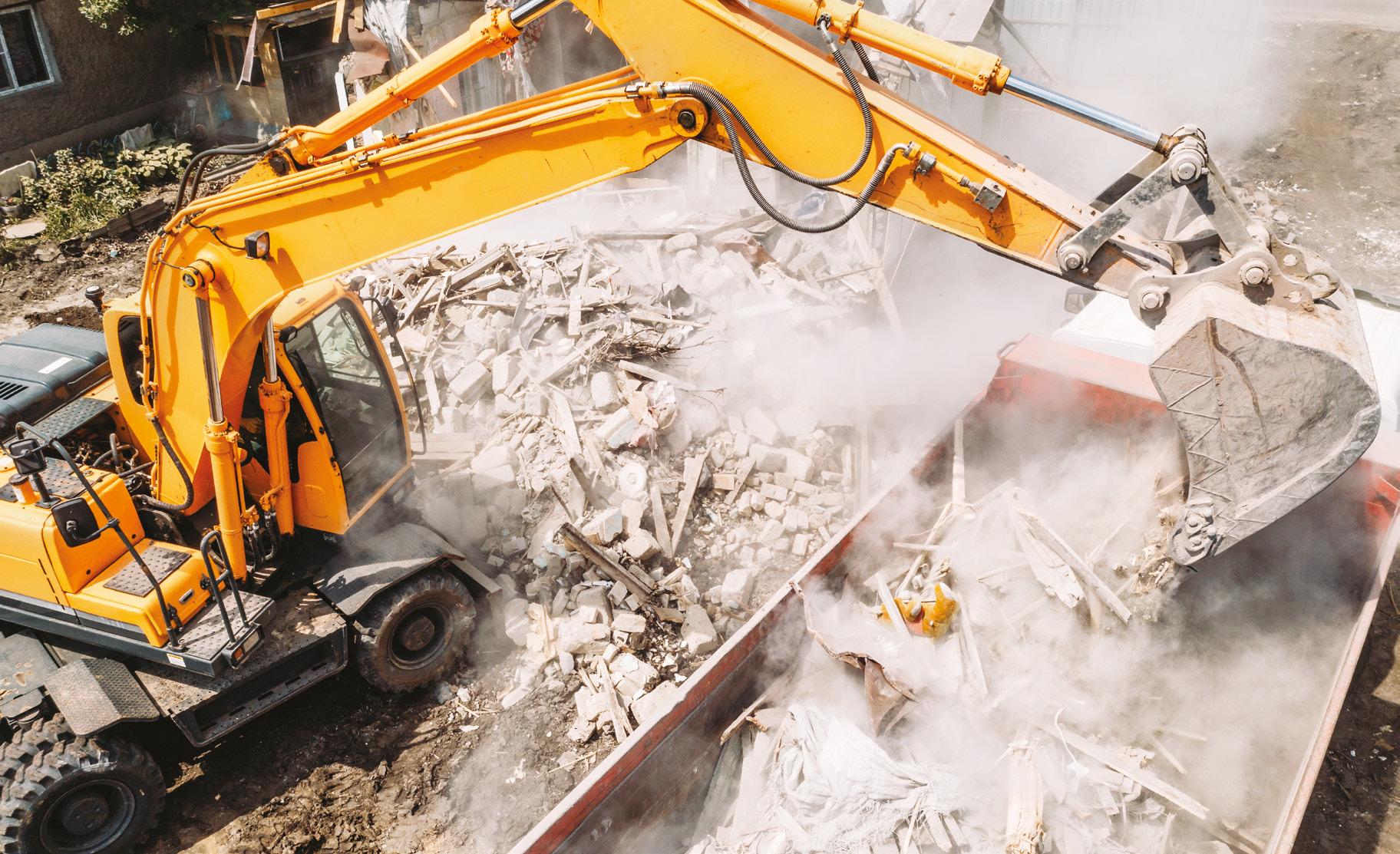
This, coupled with a lack of confidence in reclaimed materials, means the construction sector has been lagging behind the sustainability efforts of other industries and has been slow to take on circular economy methods.
WHY A CIRCULAR ECONOMY?
A circular economy approach for the sector would see resources kept in use for as long as possible – to be recovered, regenerated, and reused at the end of their life cycle rather than being discarded as waste. In a circular economy, products and materials are designed for durability, repairability, and recyclability.
According to research by Dr Bode Ogunmakinde and his colleagues, trying new initiatives to reduce waste and applying a circular economy approach can drive innovative solutions and boost the economy.
The study found that, by applying a circular economy approach, the industry could actually play a strong role in increasing sustainable development and that it should be focusing on incorporating circular economy efforts into all future plans to help Australia achieve sustainability goals.
The study states that by adopting circular economy technologies and strategies, the construction industry can achieve sustainable development while minimising waste, reducing pollution, and conserving resources.
FIRST STEPS
Dr Ogunmakinde said that the first step for the industry to embrace sustainable practices is research.
“Over time research has shown as a way of providing solutions to most issues in the industry,” Dr Ogunmakinde said.
Dr Ogunmakinde explained that by conducting sampling across a range of construction projects, researchers can identify what kinds of waste are being generated, what materials the waste is being generated from, and how best to account for or reduce this waste in the future.
“The next thing will be for us to set priorities,” he said.
Dr Ogunmakinde said that outlining priorities and targets across all levels of the industry will ensure that businesses and developers cooperate throughout projects to limit waste.
“The next thing will be to train everyone that will be involved because if you set a target and you don’t have trained operators and workers, how do you expect them to achieve the target?
“Education and training is very, very important and for the industry to minimise waste in order to achieve the sustainable development goals, we cannot overemphasise education.”
Finally, Dr Ogunmakinde explained that in order to encourage the industry to take on the initiatives and technologies put forth by the study, they need to be demonstrated and proven to be effective.
“Seeing is believing. They need to see that yes, by using this strategy or using this technique, we have been able to reduce waste generation to the barest minimum.”
SECURING GOVERNMENT SUPPORT
Dr Ogunmakinde said that the Federal Government can help support the circular economy transition in the sector by providing tax incentives to organisations making an effort to use more sustainable designs, materials and processes.
“Another thing would be for the government to implement construction and demolition waste reduction targets.
“As a nation, we should have a target that applies to any construction project in this country. Once we have that in place, everyone will have to work along that line.”
Dr Ogunmakinde said that at the state level, the government can help incentivise circular economic practices by providing rebates to companies that participate.
“Also, the State Government can fund pilot programs or pilot construction projects to test the circular economy approach and circular economy business models, because a statewide approach in that area could encourage others to implement the circular economy principles as well.”
Dr Ogunmakinde said that local governments and councils need to implement sorting and storage requirements for construction sites.
September 2023 // Issue 28 www.infrastructuremagazine.com.au 72 SUSTAINABILITY
“At the moment, I know there are some local councils that enforce having waste bins and skip bins on the site, but that is not enough,” he said.
“We need to have different skip bins for different waste generated on the site, so councils may need to enforce that in order to get things done.”

Dr Ogunmakinde said that local councils should also be encouraging deconstruction over demolition, as it generates far less waste.
“Local councils should at all costs encourage deconstruction. In the process of deconstructing a building, we're going to save a lot of material that can be salvaged and reused.”
The research – which recently received the 2022 Best Paper Award by Elsevier's Journal of Resources, Conservation and Recycling – investigates a number of technologies that are expected to help reduce construction waste, and encourages the industry to adopt them sooner rather than later.
TECHNOLOGIES TO REDUCE CONSTRUCTION WASTE Building Information Modeling (BIM)
Dr Ogunmakinde explained that BIM is a highly collaborative process which allows construction professionals and other stakeholders in the industry to come together at the start of the project and plan around waste management from the beginning.
“This will allow them to collaborate easily, and where you have collaboration right from the start you can actually predict what sort of waste will be generated, in which area the waste will be generated, and then that will help to minimise such waste,” Dr Ogunmakinde said.
Digital Material Passport
Dr Ogunmakinde explained that this technology makes use of a digital database which provides information or collects information about the material that will be used in a building.
“The material database, the digital material passport, will provide information about a material which will include the material composition, the manufacturer of that material, store information regarding the dimensions and the weight of that material, as well as the installation dates, the expected lifespan of that material, and if there are reuse or recycling potentials at the end of the life of that material.”
Automated Waste Sorting
Dr Ogunmakinde explained that this method makes use of AI and robotics to separate and sort waste material autonomously.
“Most of the time the waste generated on site ends up in the landfill. However, much of the waste generated can actually be recycled if they were sorted appropriately.”
Dr Ogunmakinde said that the sorting necessary for recycling can be time consuming and complex, due to the different types of reusable materials that must be separated from each other. An AI-assisted machine is best suited for doing this task efficiently and accurately.
3D Printing
“3D printing is an interesting one. Through an automated process of manufacturing, components, part of a building or the entire building can be manufactured through the use of a 3D printer.
“We can manufacture the windows for instance, we can manufacture the door, even the walls from 3D printers and then install them on the site.”
Dr Ogunmakinde explained that by accurately prefabricating components offsite, waste is limited due to the reduction of offcuts and excess materials.
The Internet of Things (IoT)
Dr Ogunmakinde explained that IoT devices can help to track resources and energy flows in buildings and sites in order to identify potential efficiency opportunities on construction projects.
“We can use the blockchain to track materials and equipment that are being used on the site in order to ensure that only certified materials are used, and by doing that waste can also be minimised.”
A GLOBAL RESPONSIBILITY
Dr Ogunmakinde said that it is not just the construction industry that needs to step up.
“The bottom line here is, we all need to do our part,” he said.
Construction companies, governments of all levels, and even construction clients all need to be working together to ensure the success of circular economy initiatives.
“I'm hoping that in time, they'll accept these techniques,” he said.
“It's about the environment, and we all need to do our part to ensure that we are not polluting the environment with the waste that we’re generating on construction sites.”
www.infrastructuremagazine.com.au September 2023 // Issue 28 73 SUSTAINABILITY
GOING CIRCULAR: WHAT INFRASTRUCTURE STANDS TO GAIN
By Martin Holliday, Principal Sustainability Consultant, Tonkin + Taylor
The world has lofty goals when it comes to decarbonisation; and the infrastructure industry has a critical role to play. By adopting circular economy principles in the design, construction and maintenance of critical assets, the infrastructure sector can contribute significantly to the global reduction of carbon emissions.
As infrastructure developers, we need to plan for the long term. The projects we're currently planning are more than likely going to be around for the next 100 years. This means that we need to design and build them with longevity in mind.
It's a daunting task, but it's essential. The world is facing a scarcity of resources, and we need to use them wisely. By planning for the long term, we can ensure that our infrastructure is sustainable and efficient.
In 2023, the term circular economy is in common usage, and most of us are familiar with its meaning. But as a quick recap for the uninitiated, circular economies are based on three core principles: the elimination of waste and pollution; the circulation of products and materials at their highest and most valuable state; and the regeneration of nature.
Unlike our current economy, which is linear by design – we take materials from the earth, make products from them and eventually dispose of them as waste – circular economy principles unsurprisingly work in circles instead.
It’s important to note that a circular economy isn’t one single circle – it’s made up of many circles, and these circles vary in size. A single circle may be a single industry or a single product, like car manufacturing. It could be one state or territory, as we see focused on in Victoria’s Recycled First Policy, or it could be a whole country.
Adopting circular economy principles in the infrastructure sector will involve integrating sustainable practices across every facet of operations. This includes planning for materials to be recycled at the end of their lifecycle, integrating methods for utilising waste, designing infrastructure for longevity and adaptability, and curbing emissions through smart technologies.
CIRCULAR ADVANTAGE
Circular economy practices not only enhance the sustainability credentials of an organisation or project, they also create new value, reduce costs and increase resilience.
In fact, in the 21st century, a circular approach to the planning, design, construction and maintenance of assets is crucial to the ongoing viability of infrastructure asset owners themselves.
Australia has always been referred to as the lucky country, and we find ourselves in a rare position globally of being resource rich with a relatively low population. Now is the time for us to work out what we do well in the circular economy space, particularly relating to infrastructure and manufacturing, and look to build on those successes. We have the resources to build a circular economy, and we have the skills and knowledge. We just need the political will to do so too.
At Tonkin + Taylor, we have a unique role to play in that we understand both the infrastructure project lifecycle, and we have an intimate understanding of sustainability.
We work with a number of clients across Australia and New Zealand to help them identify the right places to adopt circular principles, and focus on the concept of using the right material in the right place at the right time.

A great example is the number of Major Road Projects Victoria (MRPV) developments that we’re currently involved with. These developments are utilising low carbon concrete and recycled products; and the Mickleham Road Upgrade in particular has focused on creating a real sustainability culture across the entire project team.
By engaging the entire team and having a number of conversations about sustainability at all levels of these projects – including with team members you traditionally wouldn’t associate with great sustainability outcomes – we are achieving some phenomenal results for the development, the client, and most importantly, the environment and local community.
Sustainability is about doing things differently; and throughout the lifecycle of an infrastructure project, interventions can be made to realise more sustainable outcomes. Of course, the earlier in the project lifecycle you look at how this may be achieved, the bigger the potential gains. But even in an advanced project, the best time to start a conversation about sustainability and circularity, and start realising the many benefits, is today.
September 2023 // Issue 28 www.infrastructuremagazine.com.au 74
Sustainability and circularity are key to infrastructure success. Contact the specialists at Tonkin + Taylor for help with your sustainable infrastructure goals by emailing australia@tonkintaylor.com.au or calling 03 9863 8686
SUSTAINABILITY // SPONSORED EDITORIAL




Complex challenges into sustainable solutions Find out more at... www.tonkintaylor.com.au
a specialist provider of engineering and environmental services, Tonkin + Taylor brings your project ambitions to life. With proven experience on large-scale projects across Australia and New Zealand, we are the specialist partner of choice. From land development, transport, renewable energy, waste + resource recovery to water resource management, industry, and mining – we are passionate about creating and sustaining a better world together.
As
FEATURES SCHEDULE & ADVERTISERS’ INDEX

76 September 2023 // Issue 28 www.infrastructuremagazine.com.au
Airport Urban development Smart Cities Automated & electric vehicles Freight & logistics DISTRIBUTION TBC June 2024 Deadline: 26 April 2024 Ports Asset management AI & machine learning Intelligent Transport Systems (ITS) Roads & traffic Sustainability DISTRIBUTION TBC September 2024 Deadline: 19 July 2024 Rail Disaster management Security Airport Tunnels & bridges Rail IoT & cloud communication DISTRIBUTION AUSTRALIAN AIRPORTS ASSOCIATION (AAA) NATIONAL CONFERENCE AUSRAIL PLUS 2023 November 2023 Deadline: 13 October 2023 March 2024 Deadline: 2 February 2024 Software, communications & connectivity Digital Twins Funding/investment Signalling, tracking & control systems Condition monitoring & maintenance Spatial & GIS Training & skills DISTRIBUTION TBC Cacti Conserve 10 Century Yuasa OBC CST Hire 6 Engineers Australia 65 Infrastructure Association of Queensland Inc 13 Madison Technologies 51 Mainmark Ground Engineering 61 Monkey Media 11 nbn 27 Parchem Construction Supplies 31 Polymaster IFC Quest Apartment Hotels 8 Reveal 45 Seequent 39 Spectur 33 Strailastic Australia 7 The Finance Consultancy IBC Tonkin + Taylor 75 Toolkwip Pumps 9 Interested in working with Infrastructure Magazine? Scan to download our media kit.




BusinessStage We GUARANTEE a greater result –your lender or a new one – or we’ll donate $1000 to your chosen charity. www.thefinanceconsultancy.com.au Chris Slack: 0415 305 502 theteam@thefc.com.au • Vehicle and Equipment Finance • Business Acquisition • Shareholder buyout • Unique Working Capital Solutions • Trade and Debtor Finance • Sole Traders to ASX Listed businesses Does YOUR business currently use Trade or Debtor Finance? Email theteam@thefc.com.au to make lending work harder for YOUR business.
Protect your critical assets with the most reliable systems made in Australia.
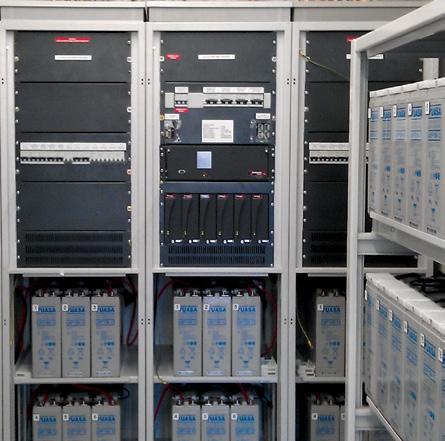






Century Yuasa has been protecting critical power assets for 30 years with our local design, construct and onsite teams. Our DC systems are built with the best of global technologies and supported with the globally recognised Yuasa VRLA batteries which are the only batteries you can genuinely rely on to protect your critical assets and business services year after year.
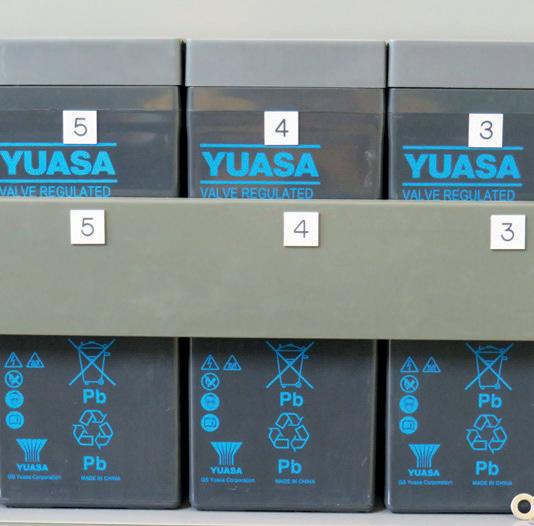


To learn more about Australia’s own DC power systems, maintenance services, and the Yuasa range of VRLA batteries, visit our website.
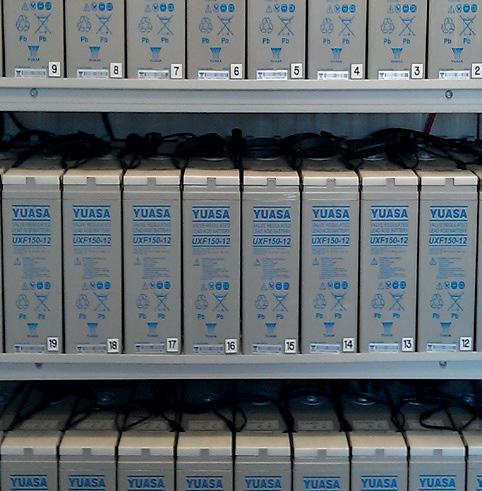
For enquiries call 1300 364 877 https://cyb.com.au/industries-markets/industrial






































 By Adam Copp, CEO, Infrastructure Australia
By Adam Copp, CEO, Infrastructure Australia







































 By Tess Macallan, Journalist, Infrastructure Magazine
By Tess Macallan, Journalist, Infrastructure Magazine





























 By Kody Cook, Journalist, Infrastructure Magazine
By Kody Cook, Journalist, Infrastructure Magazine

















